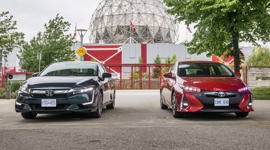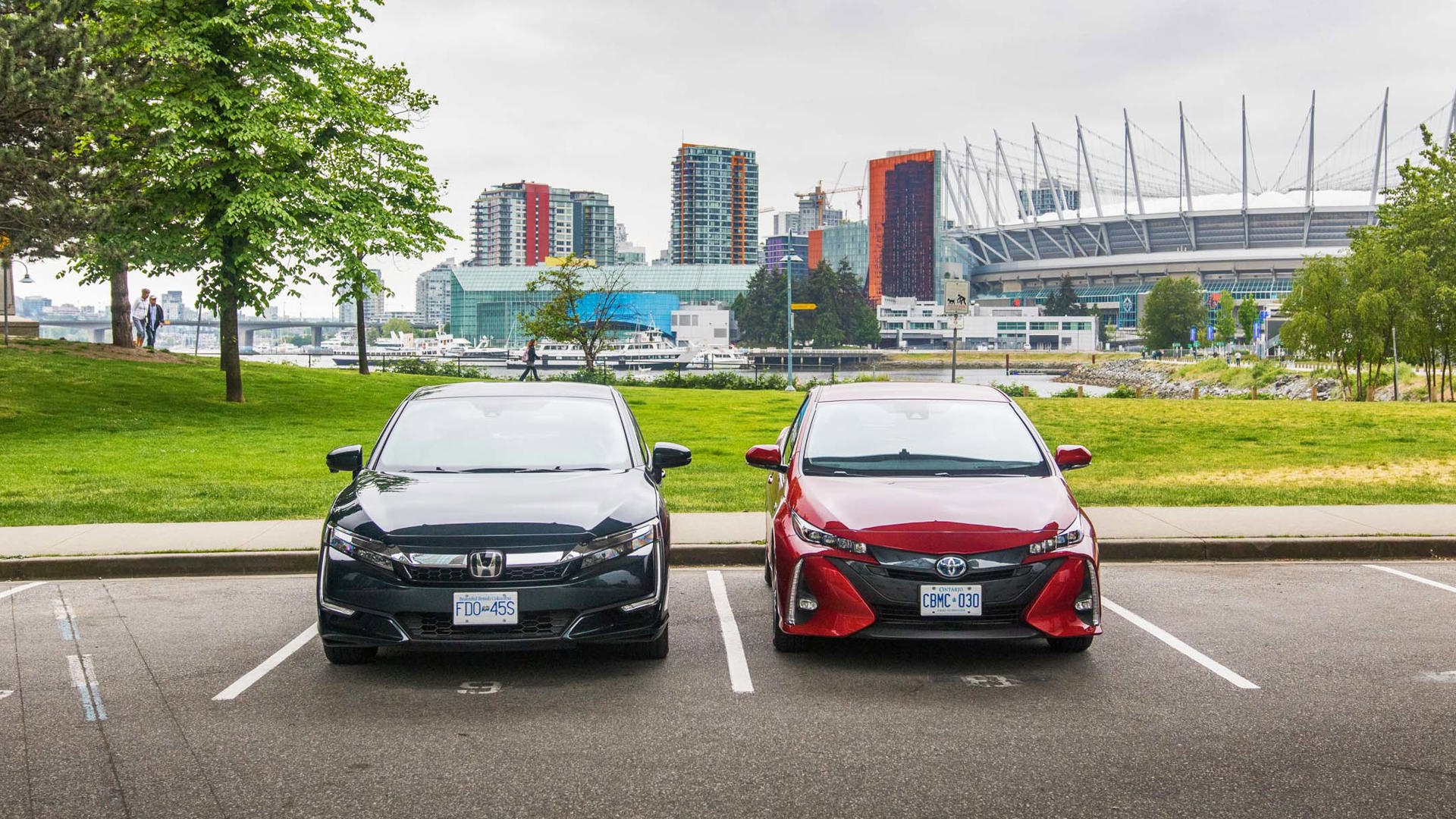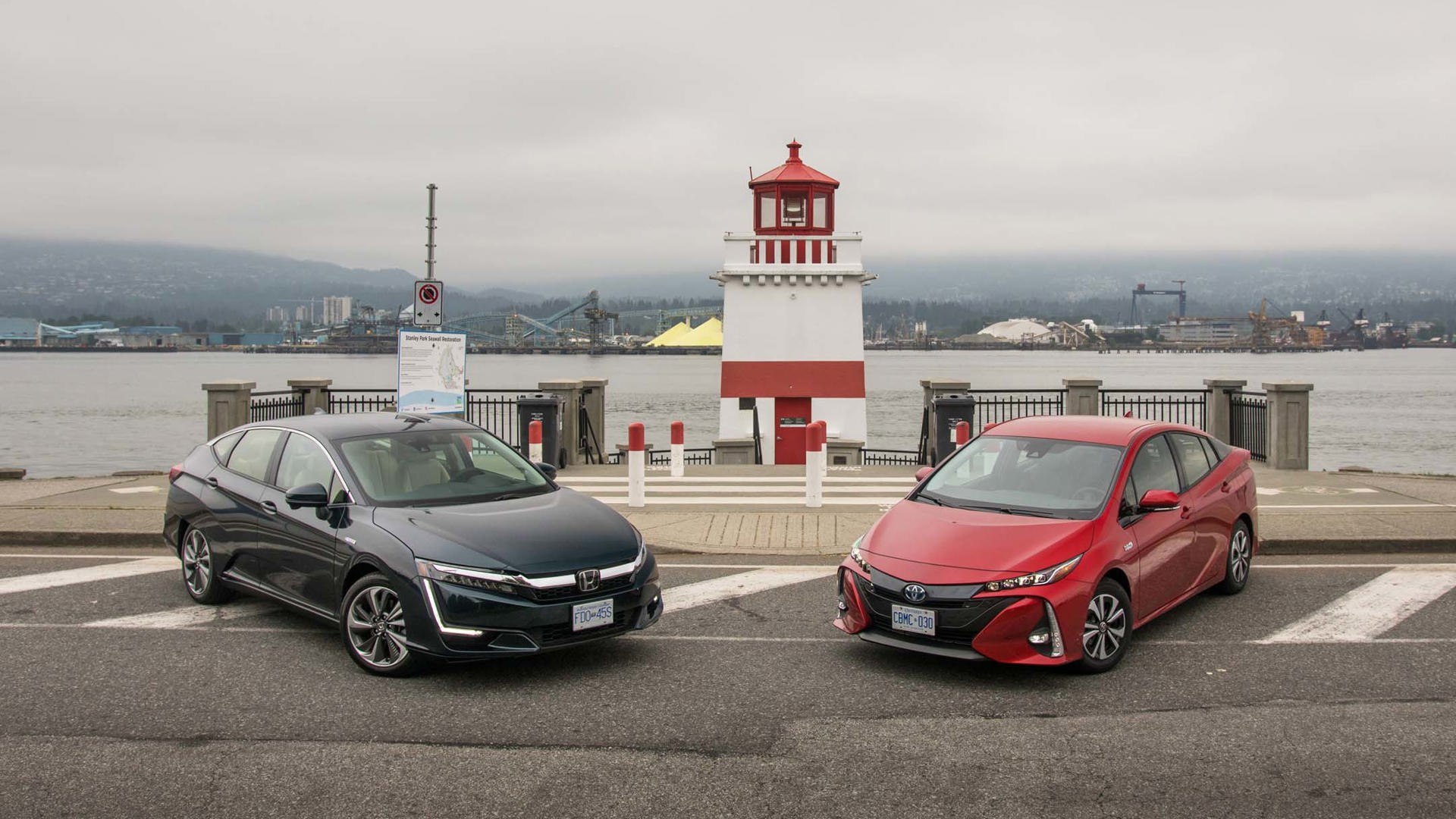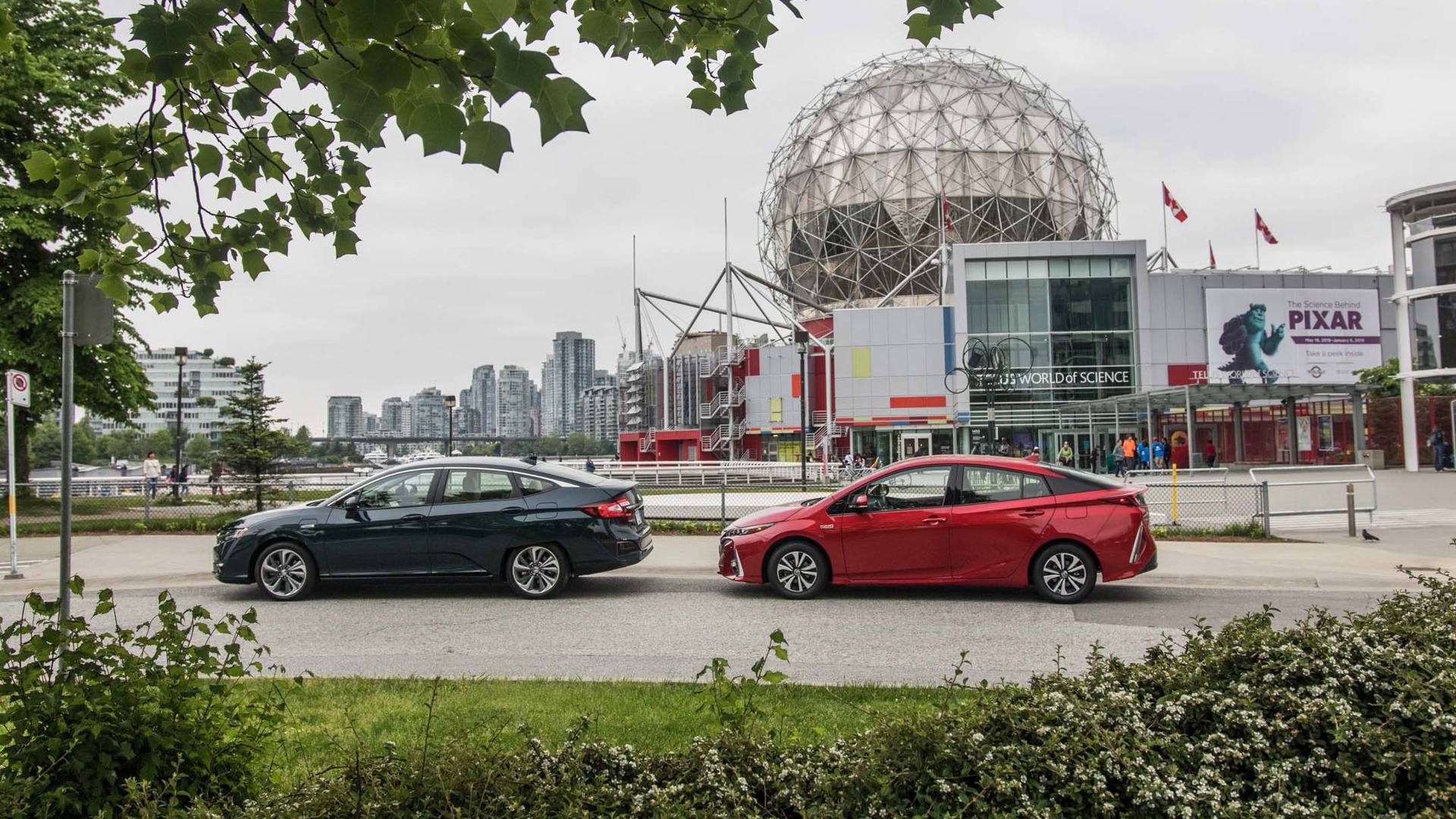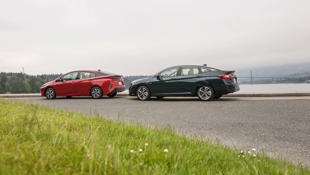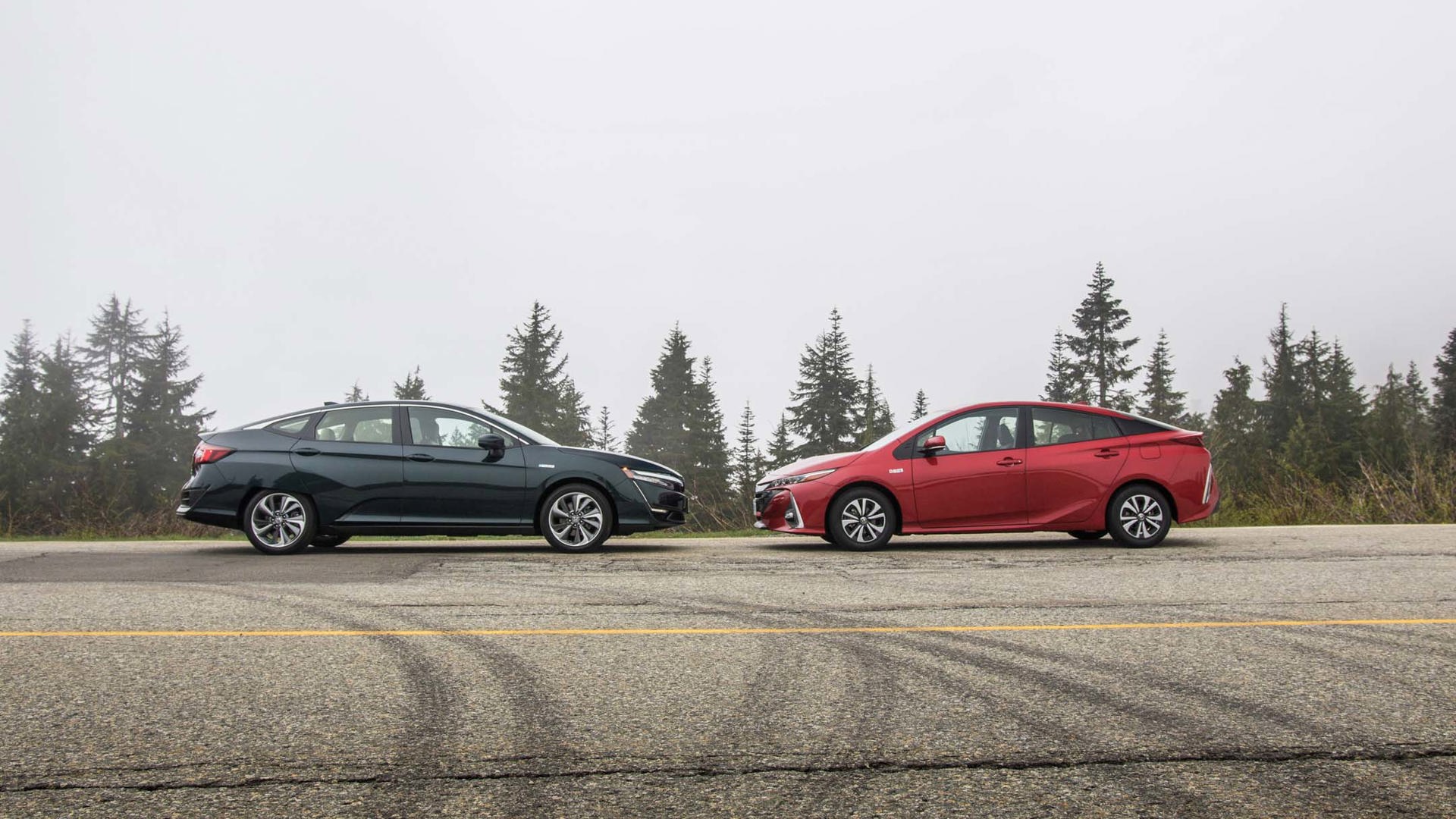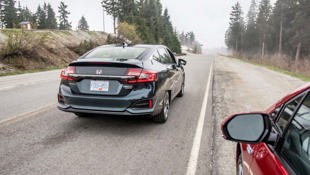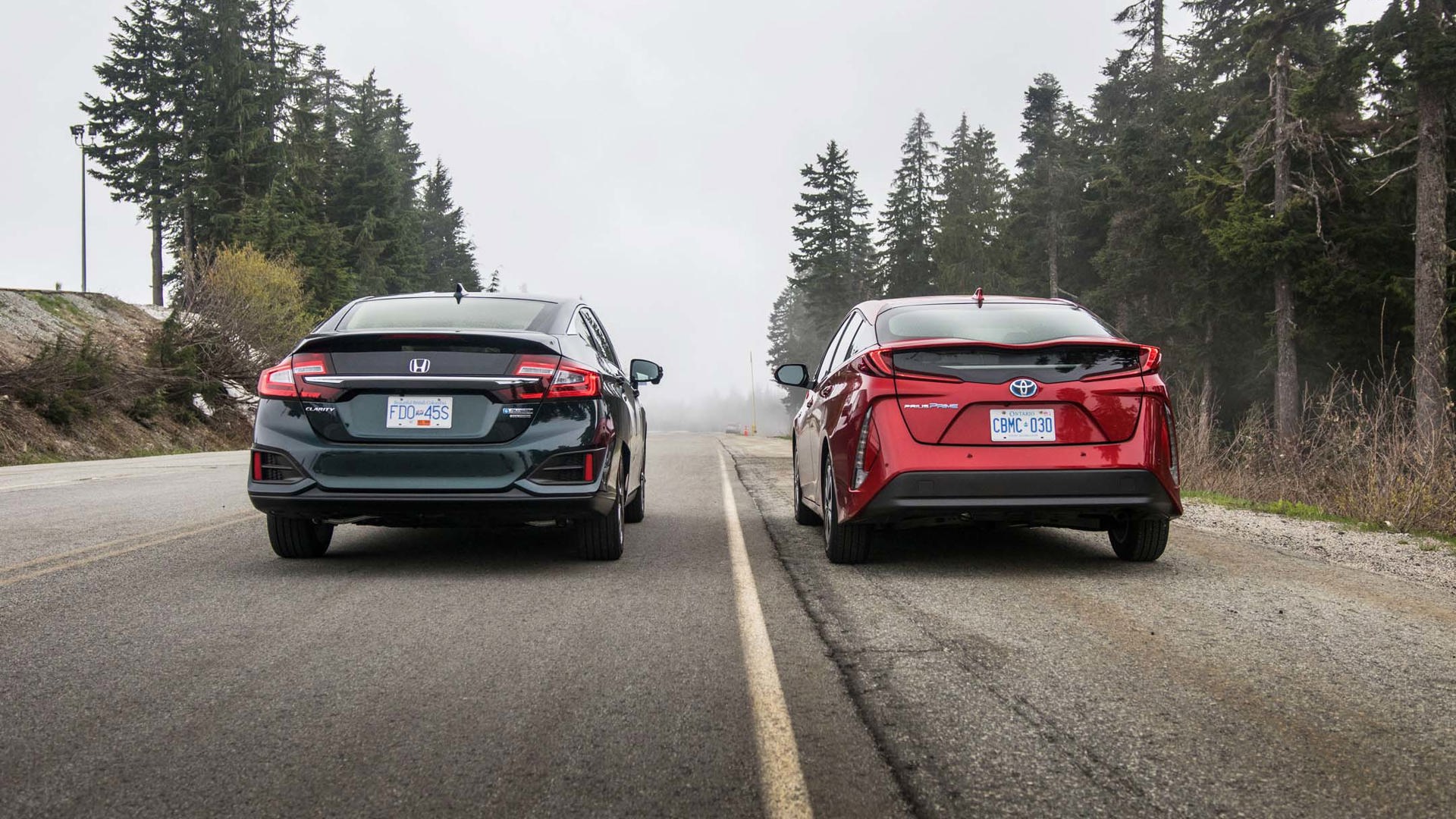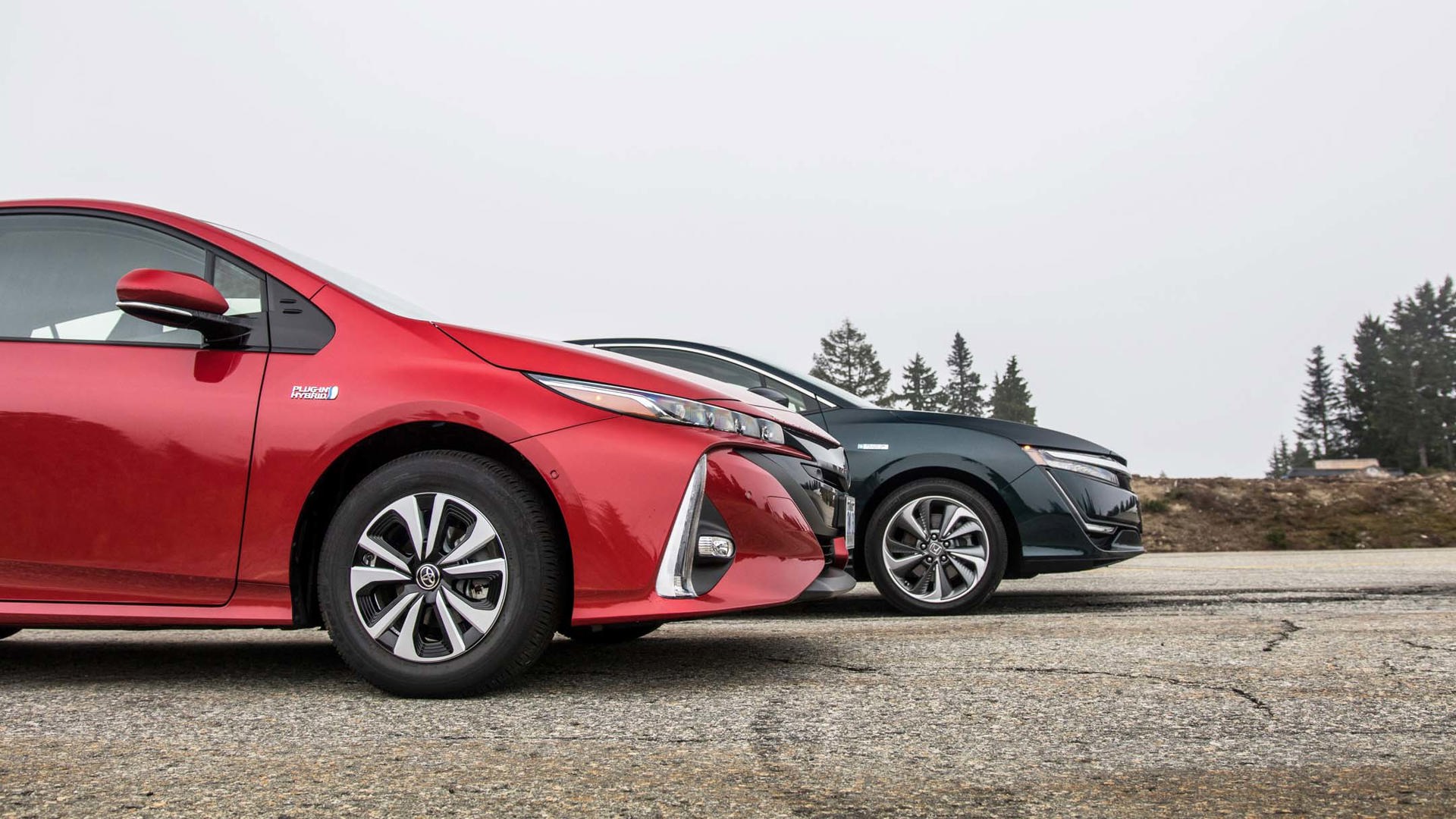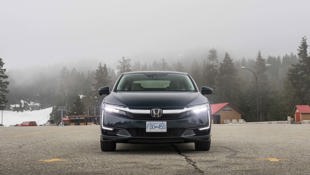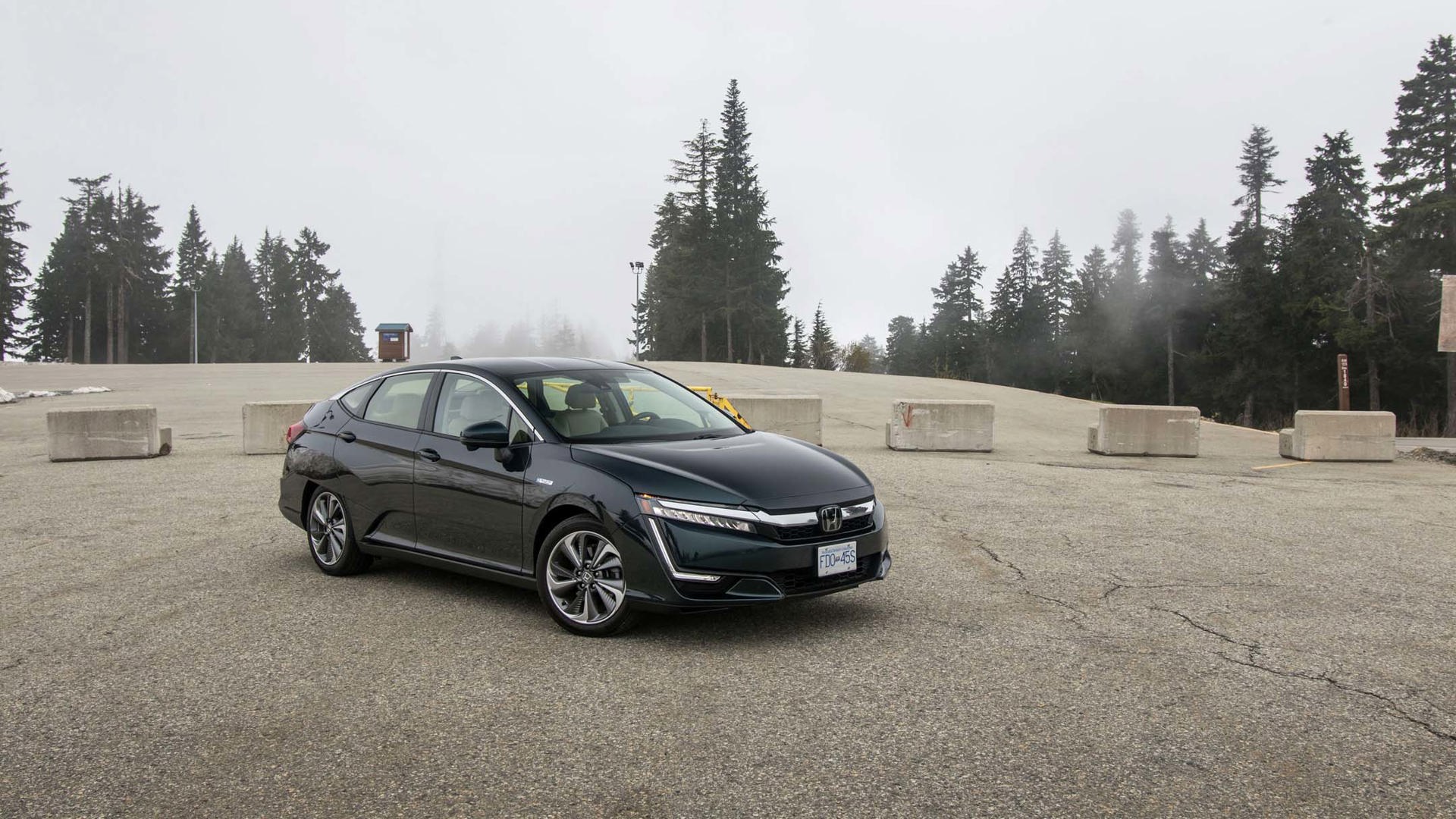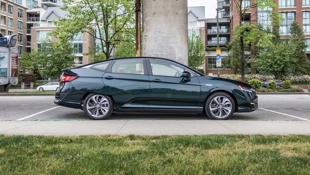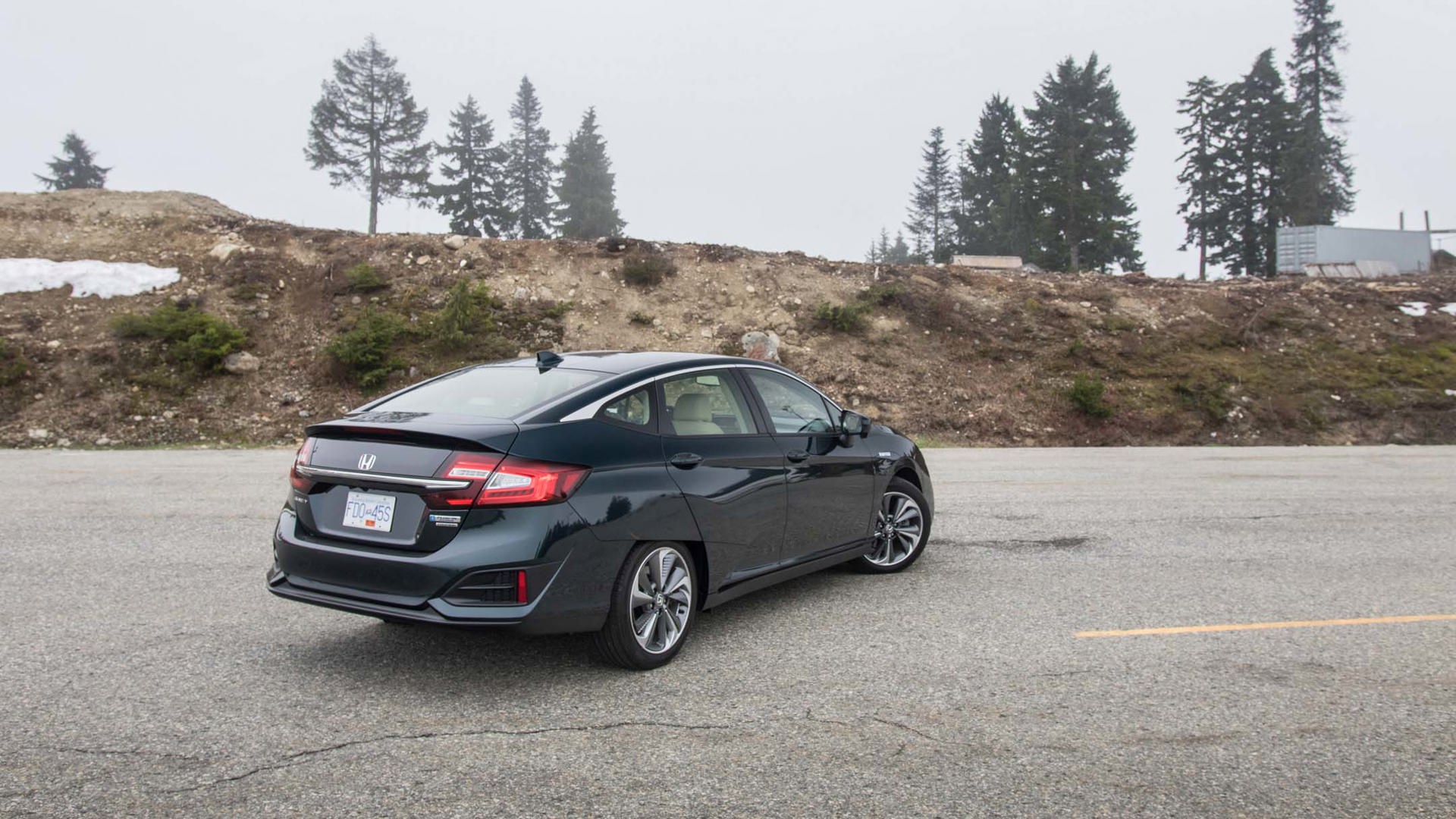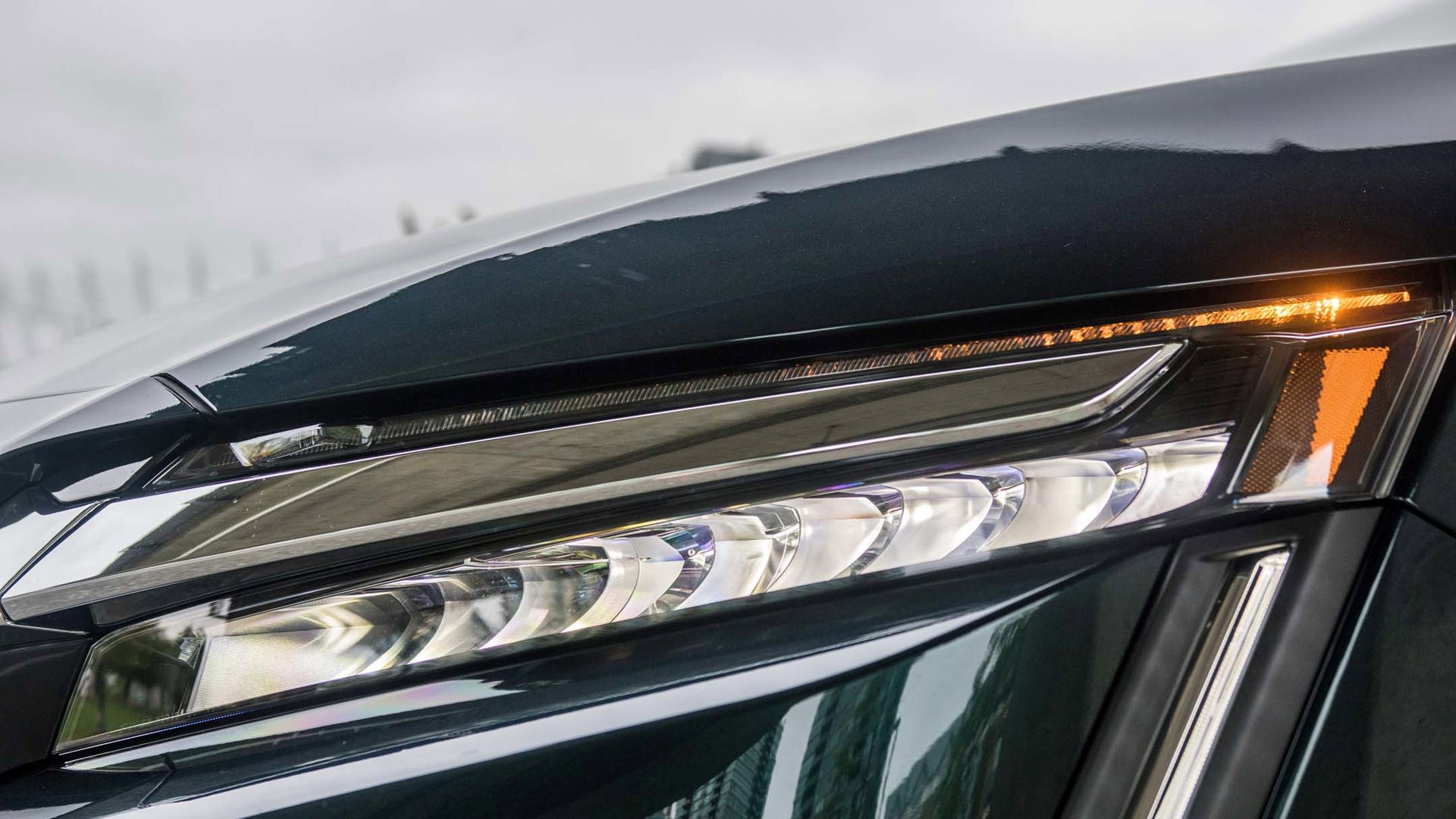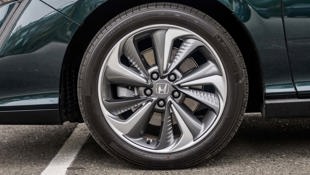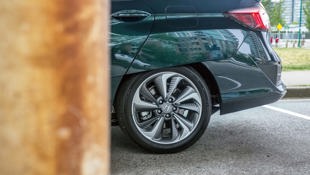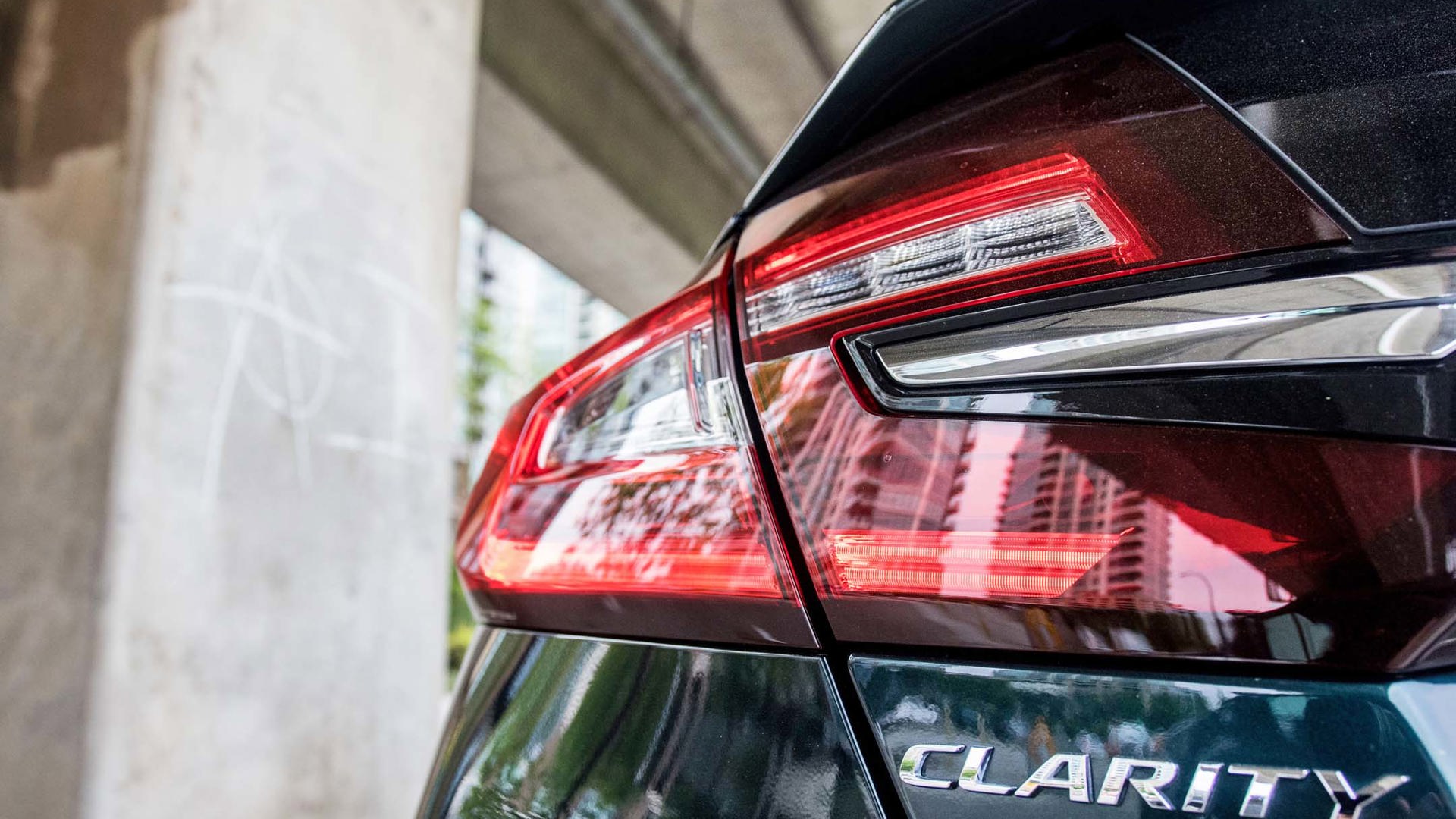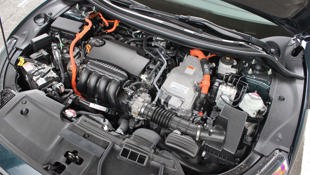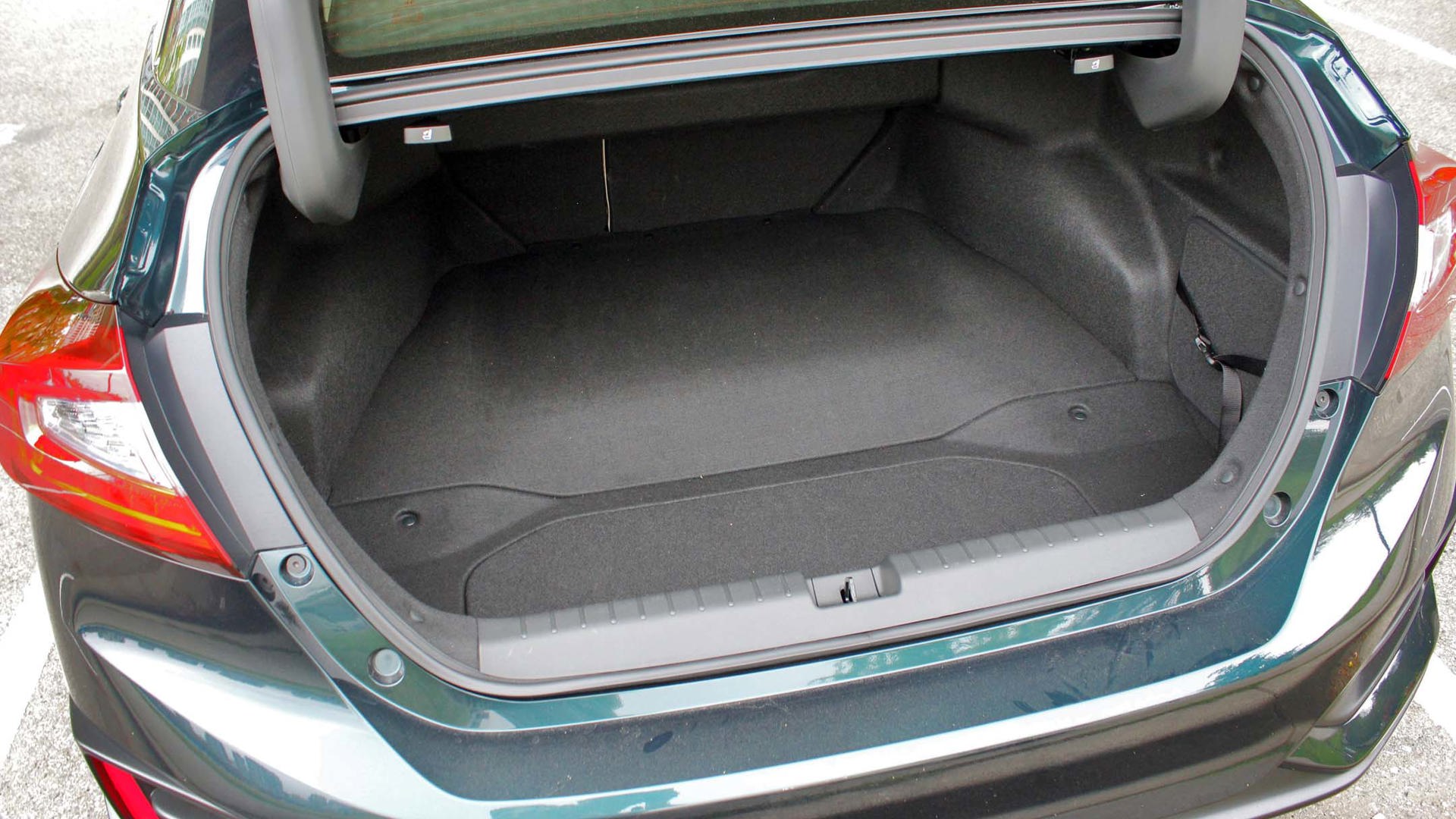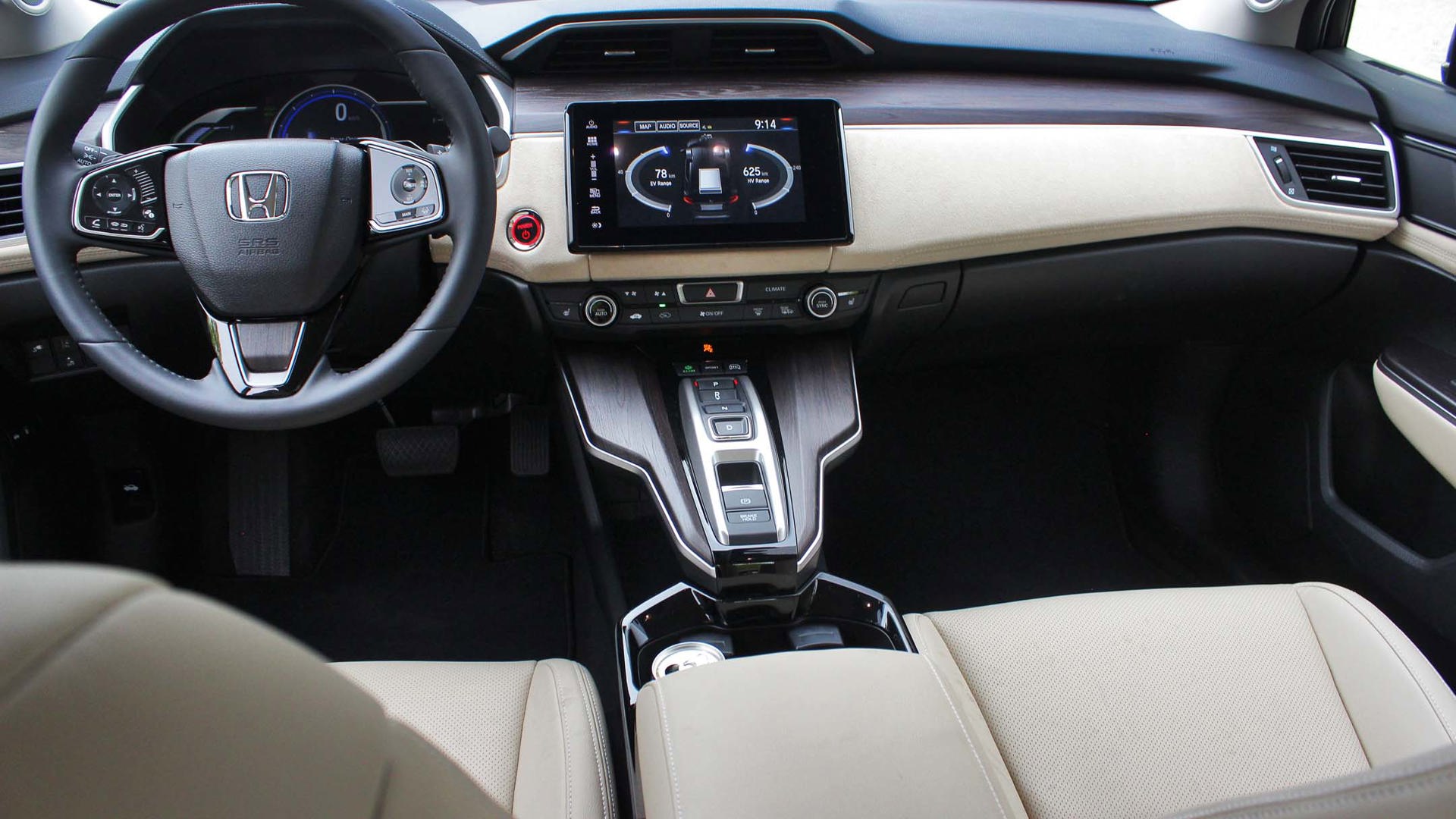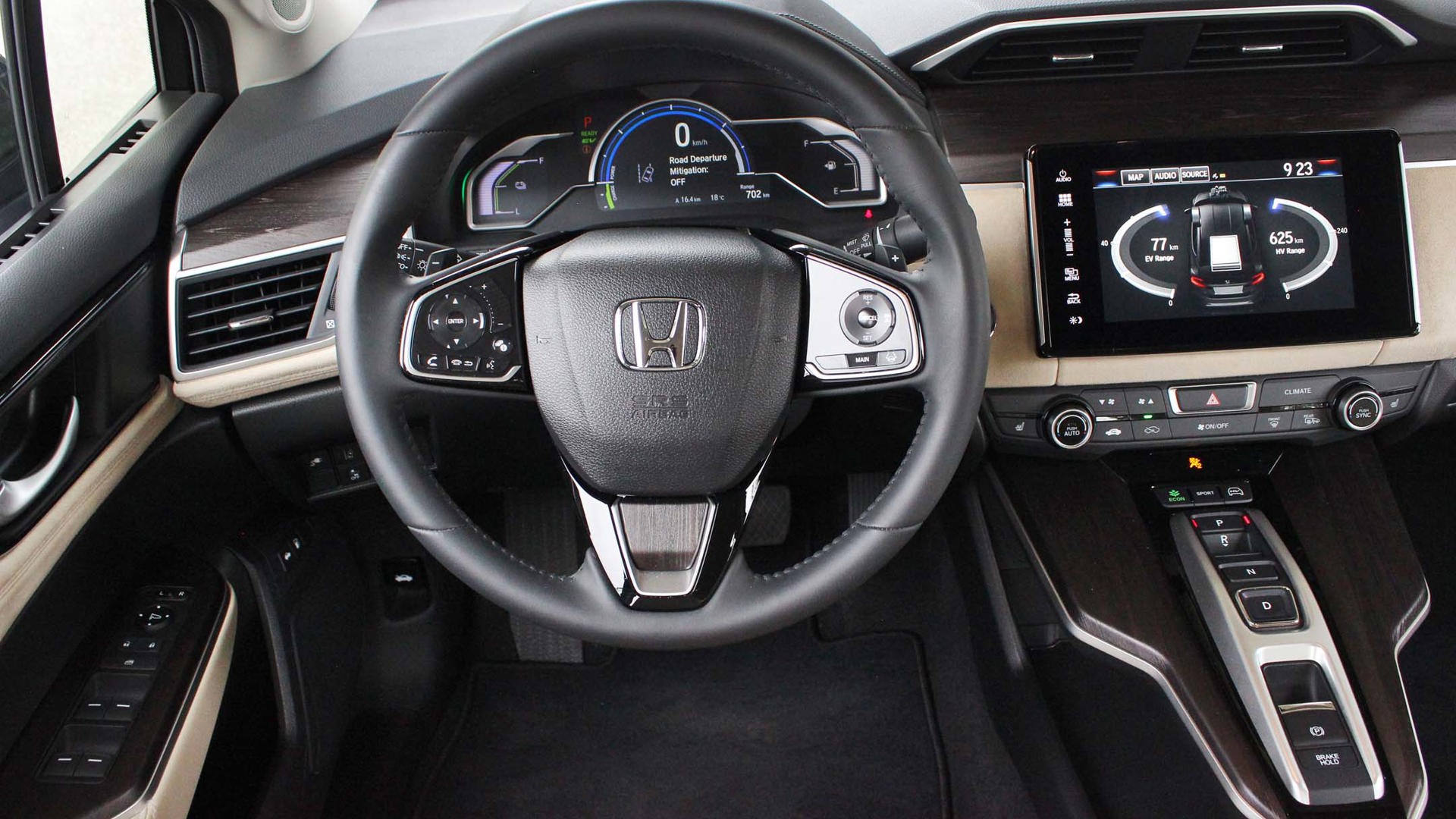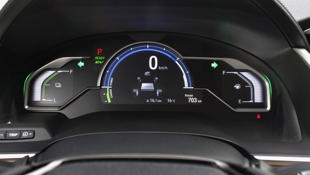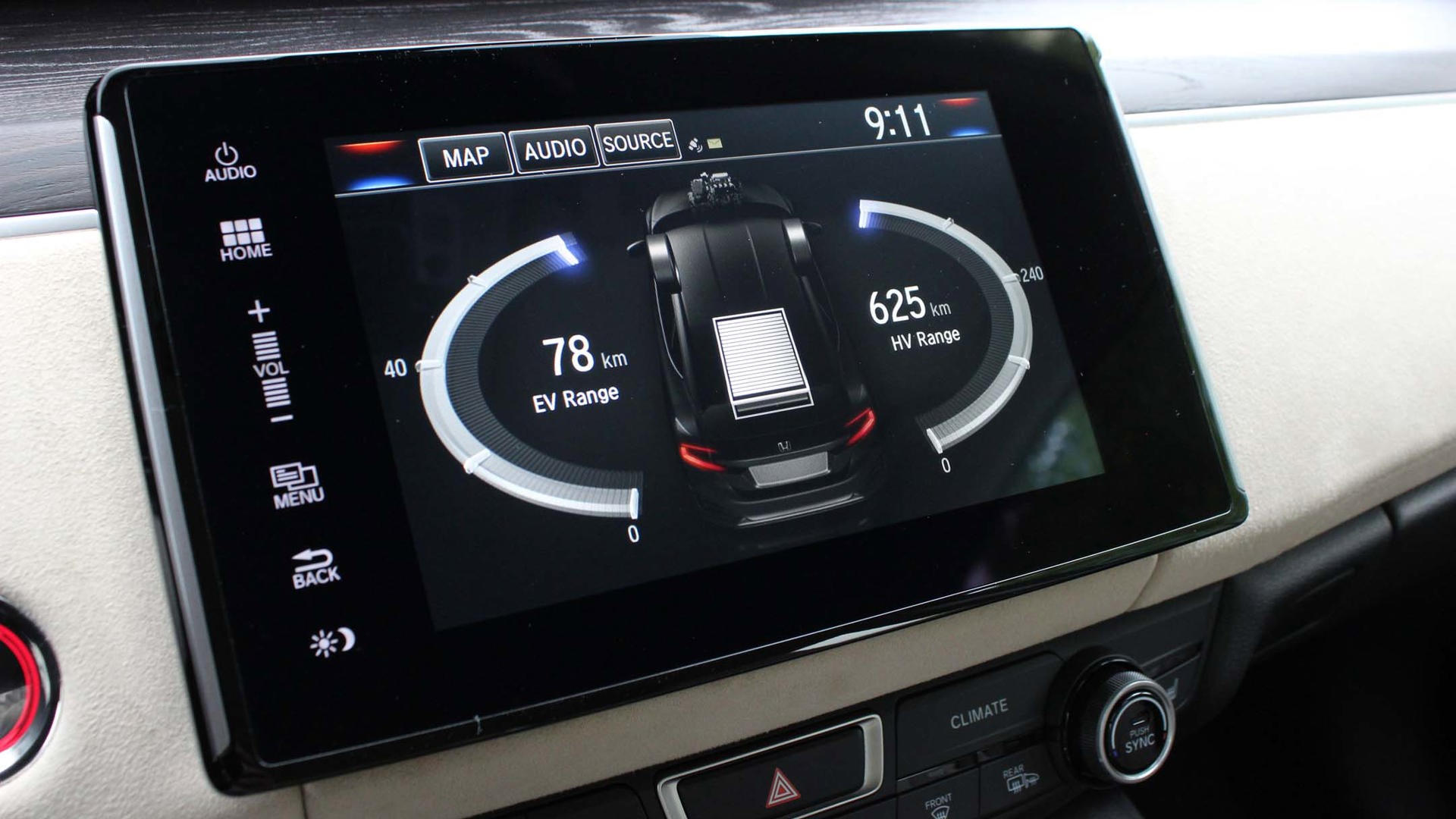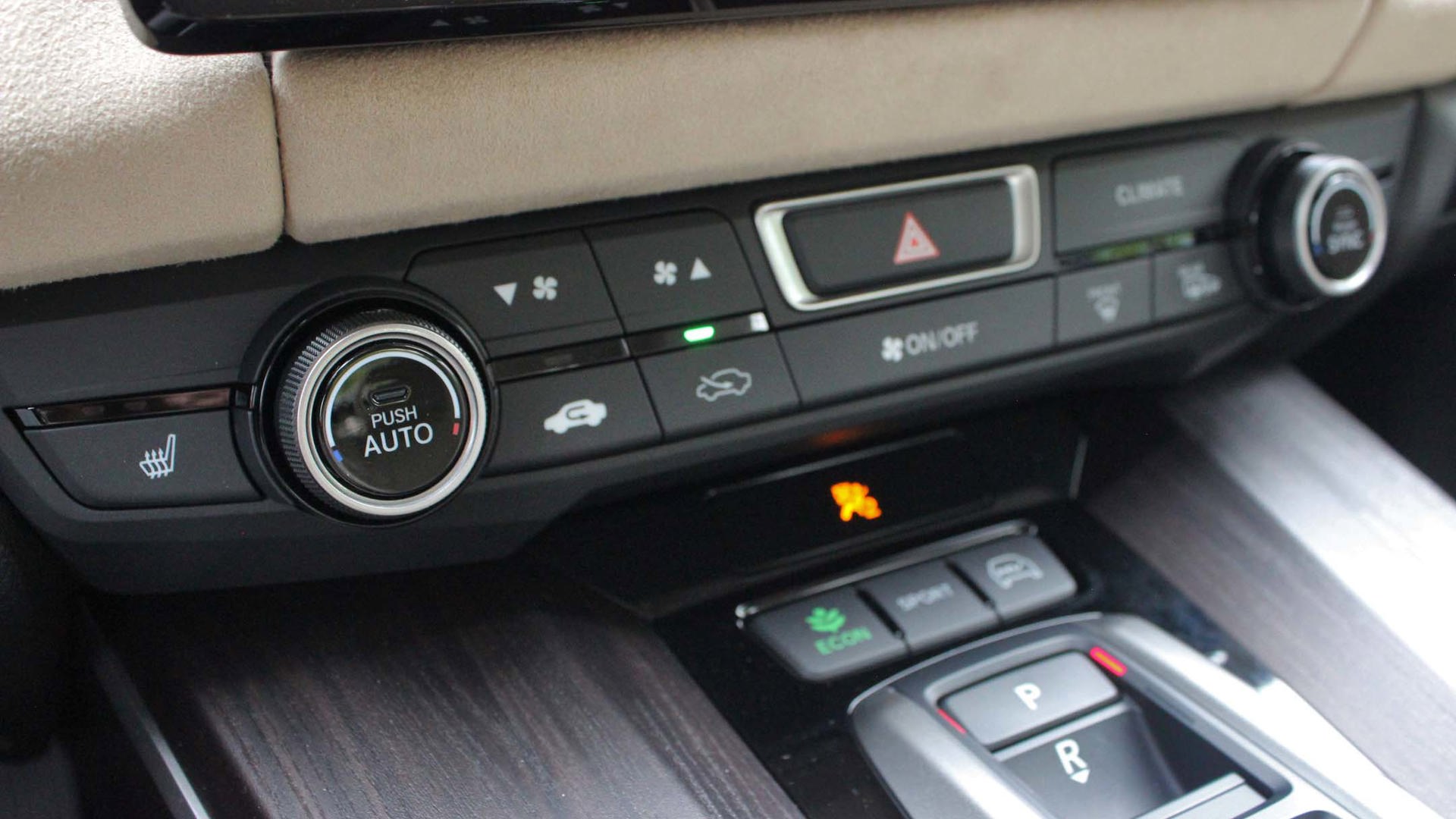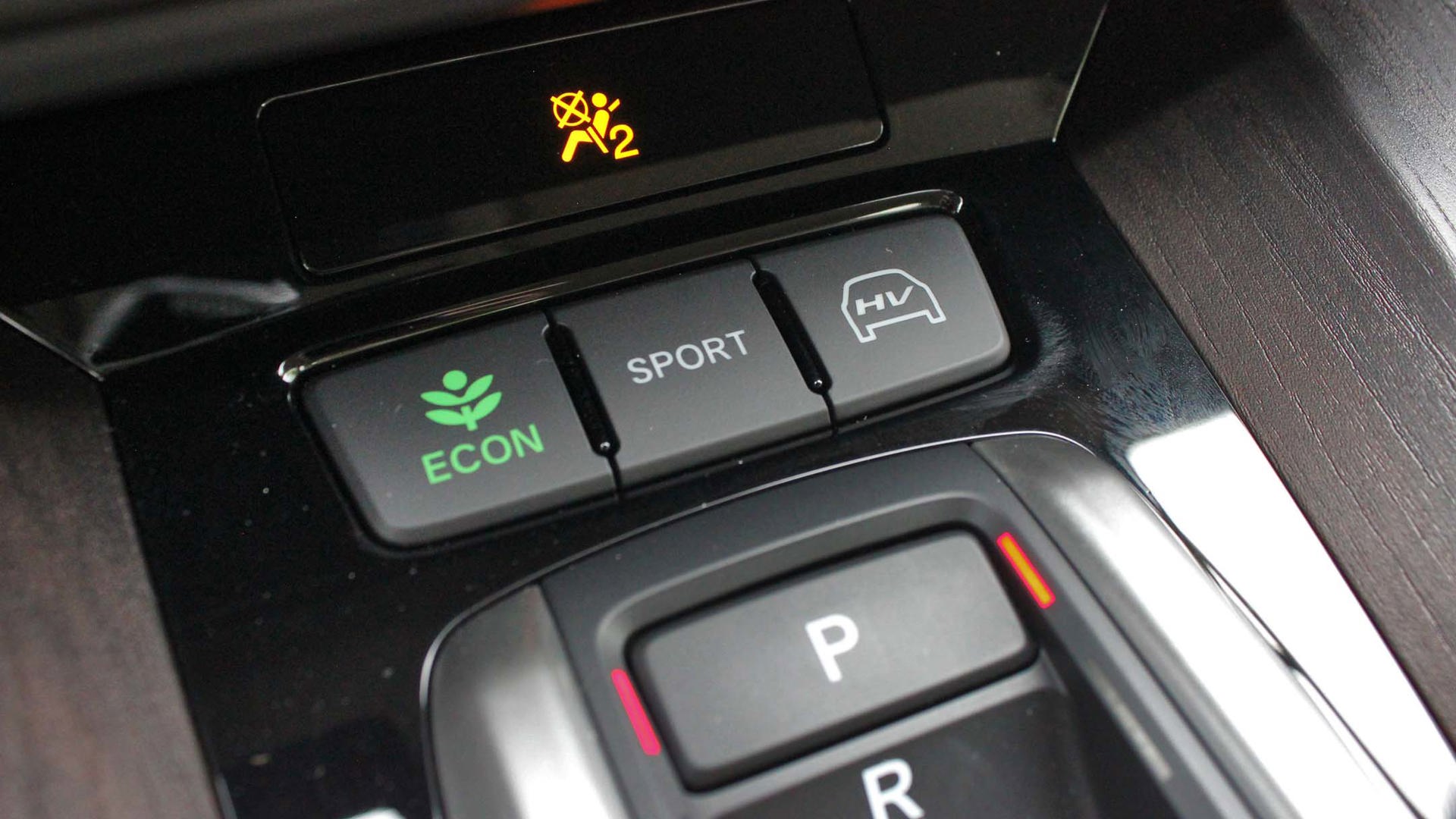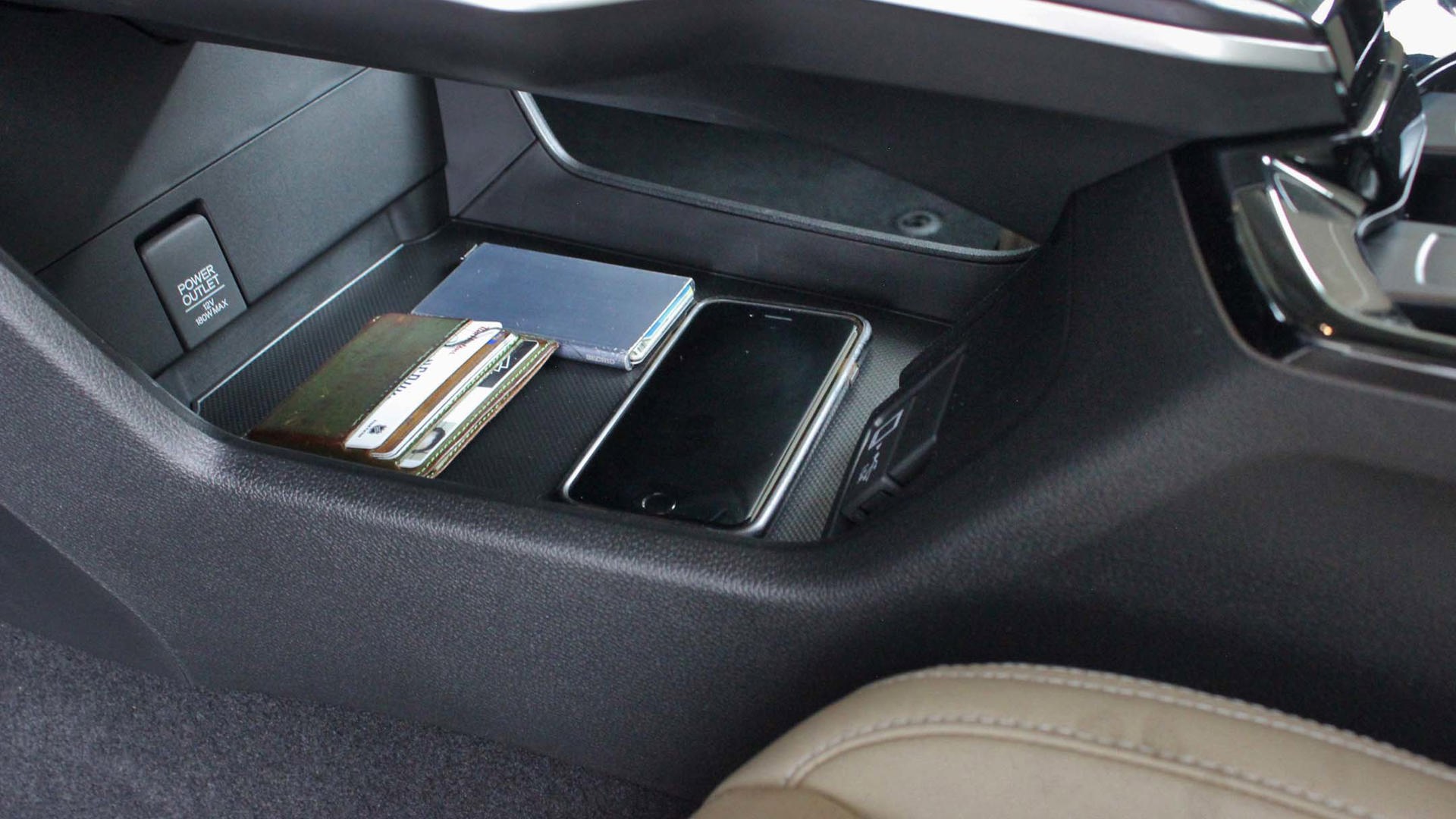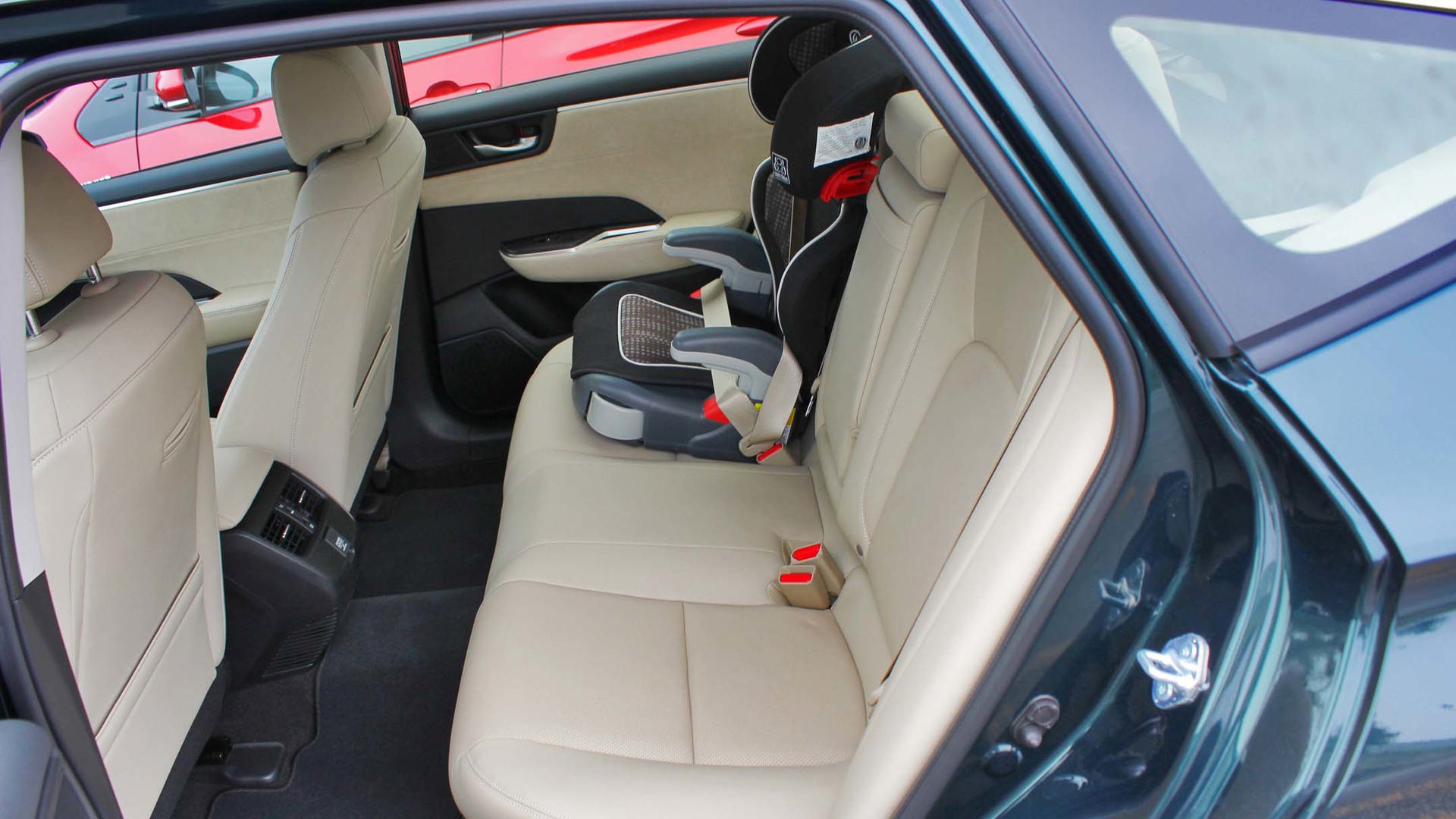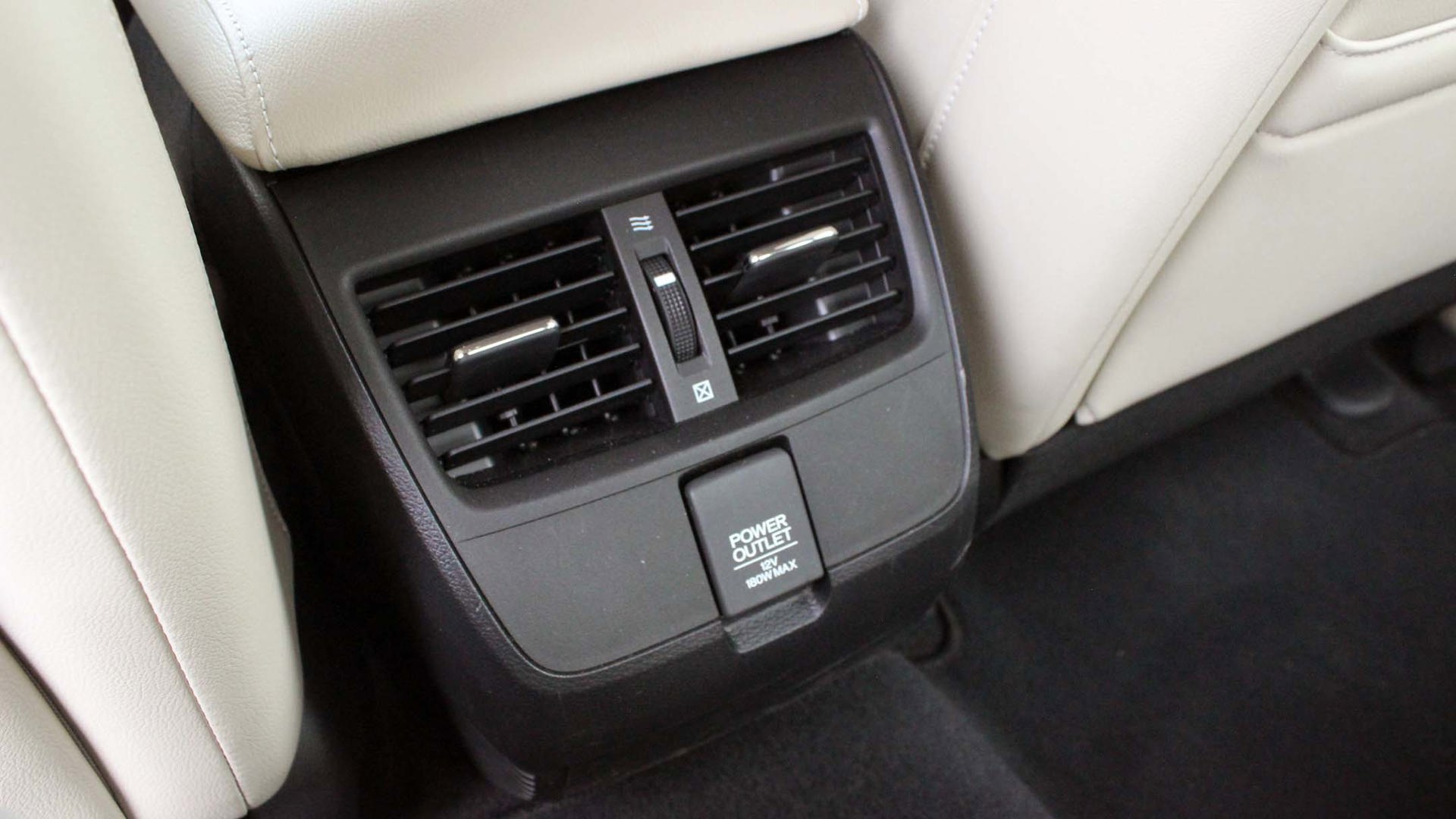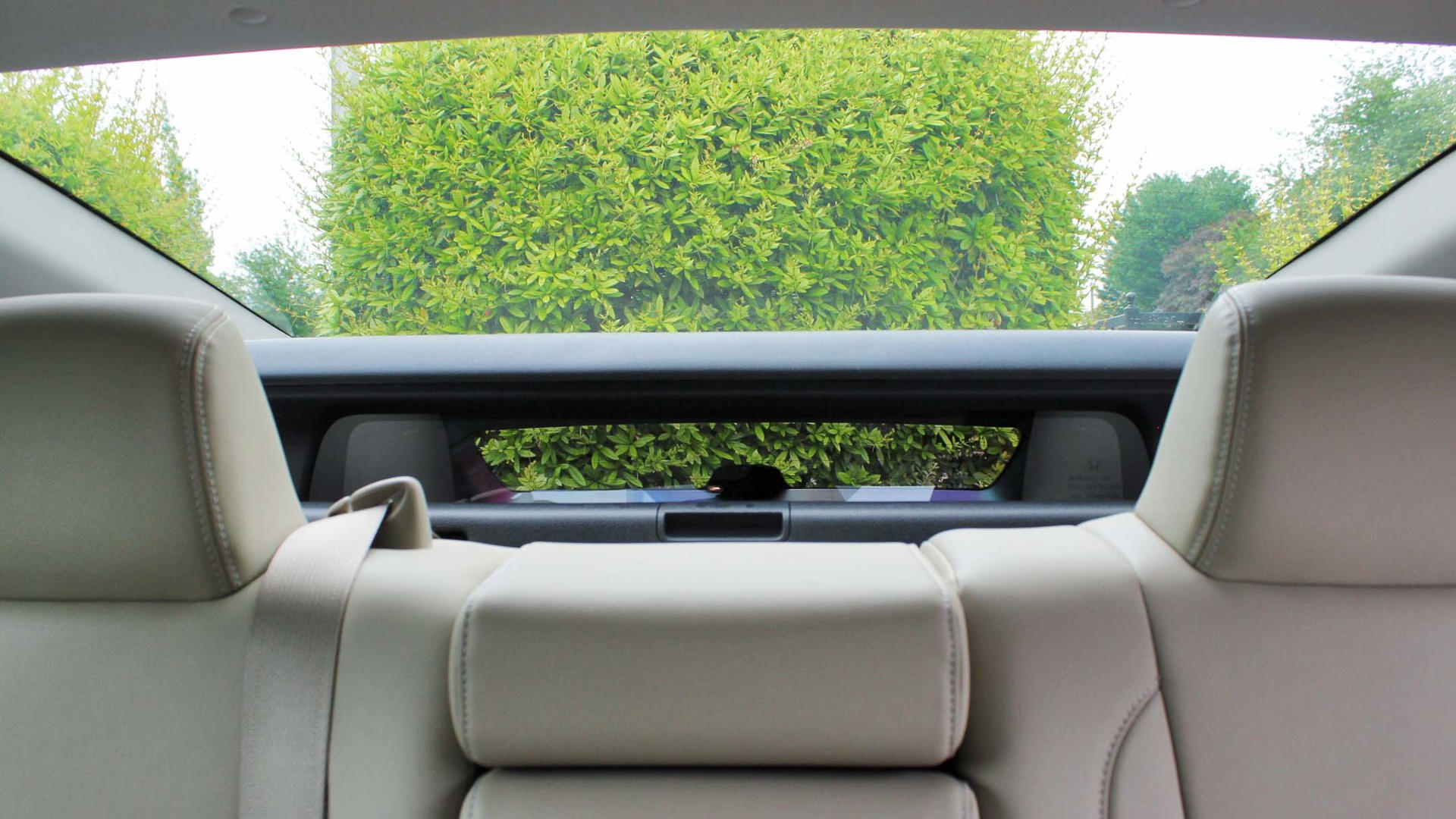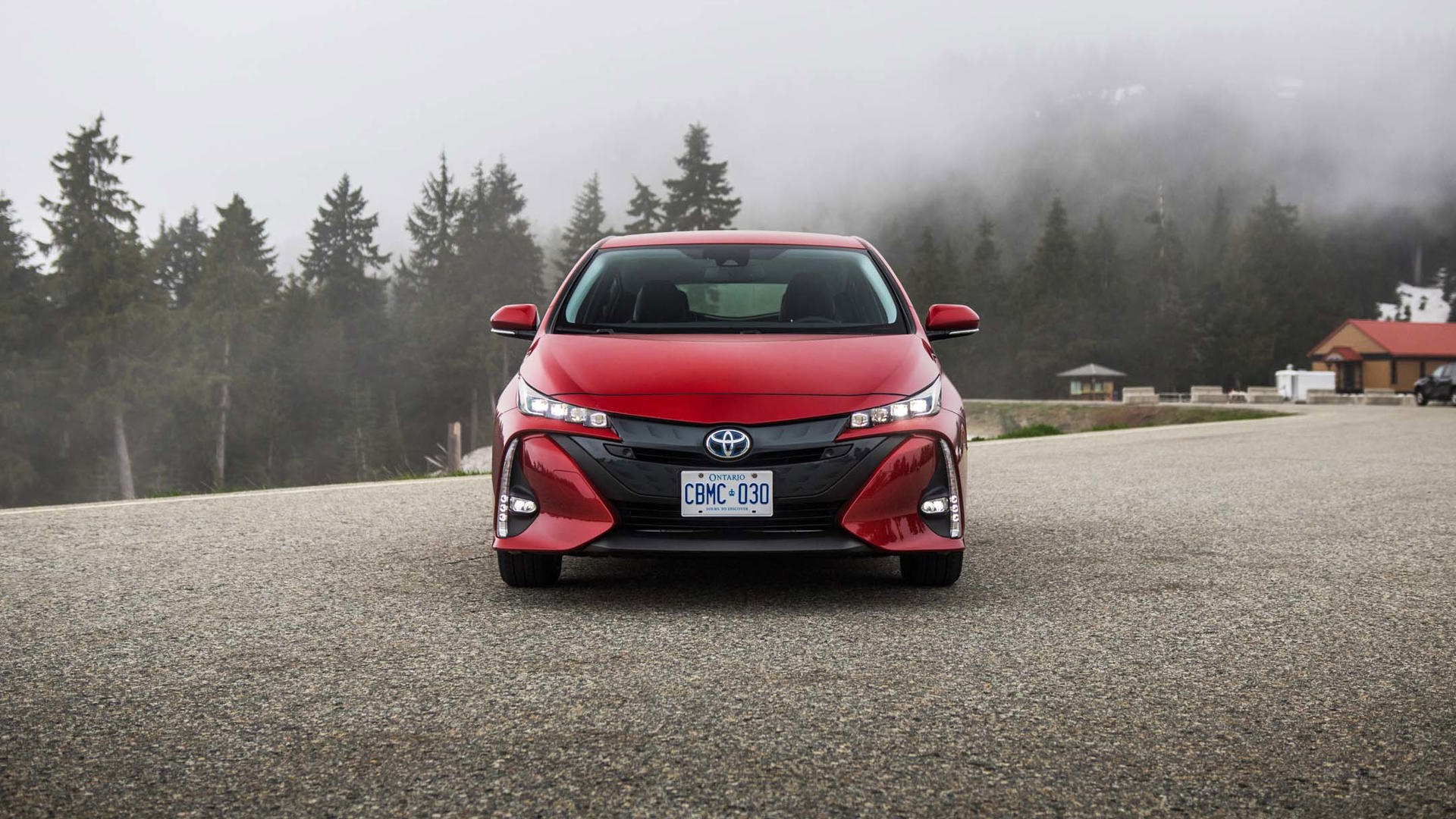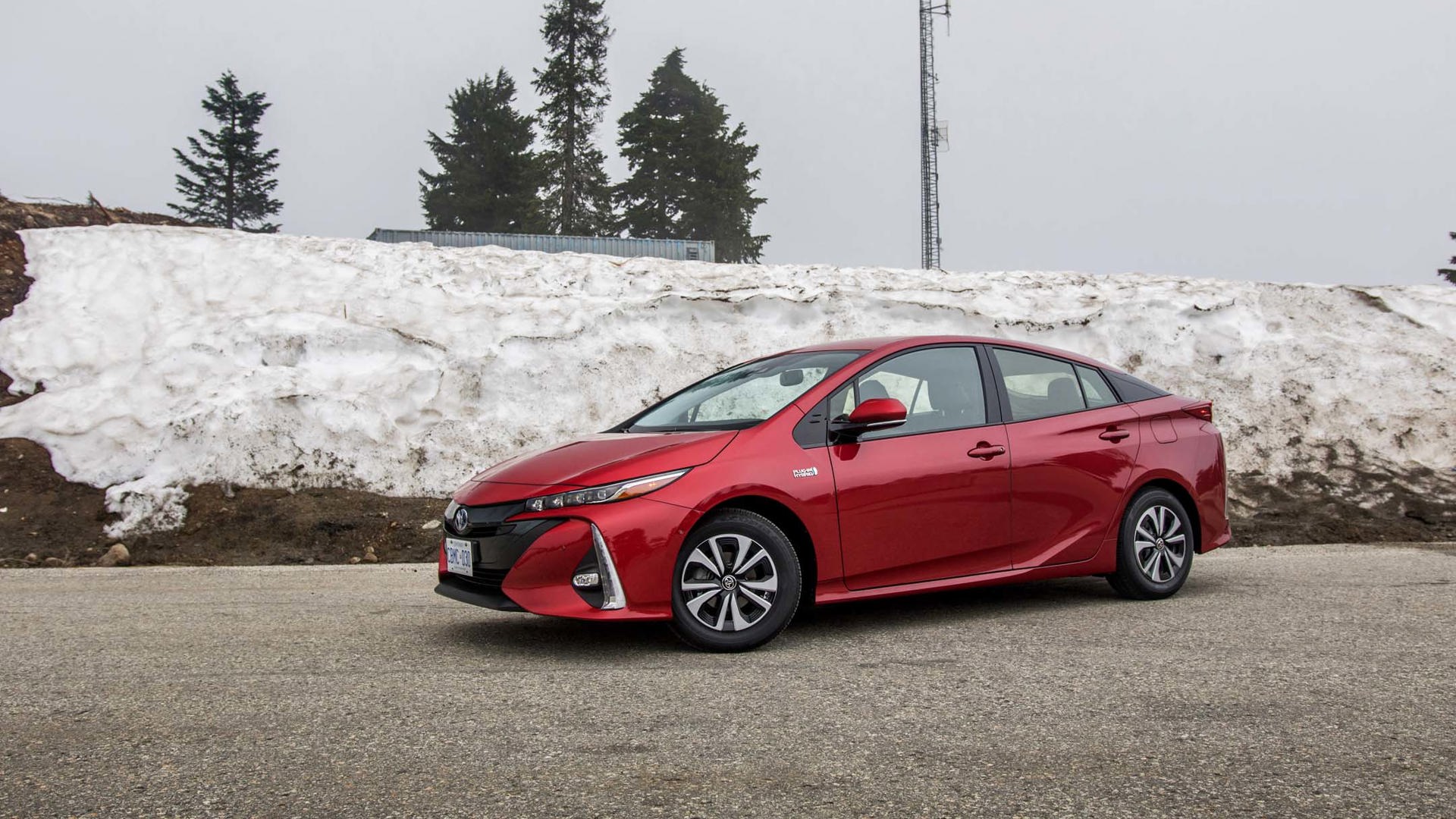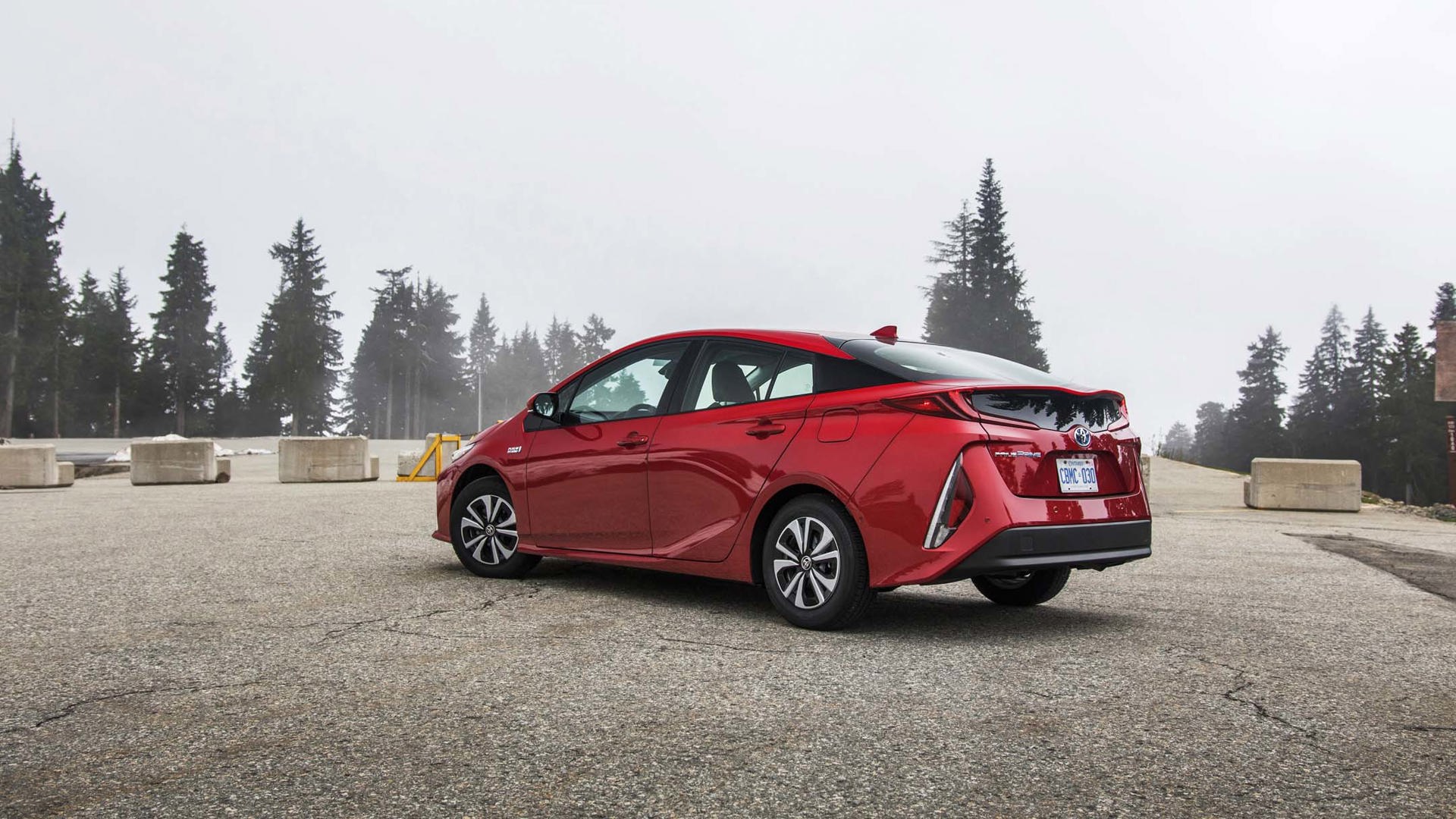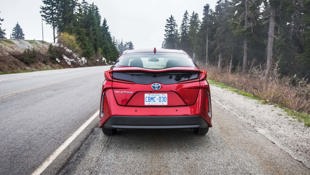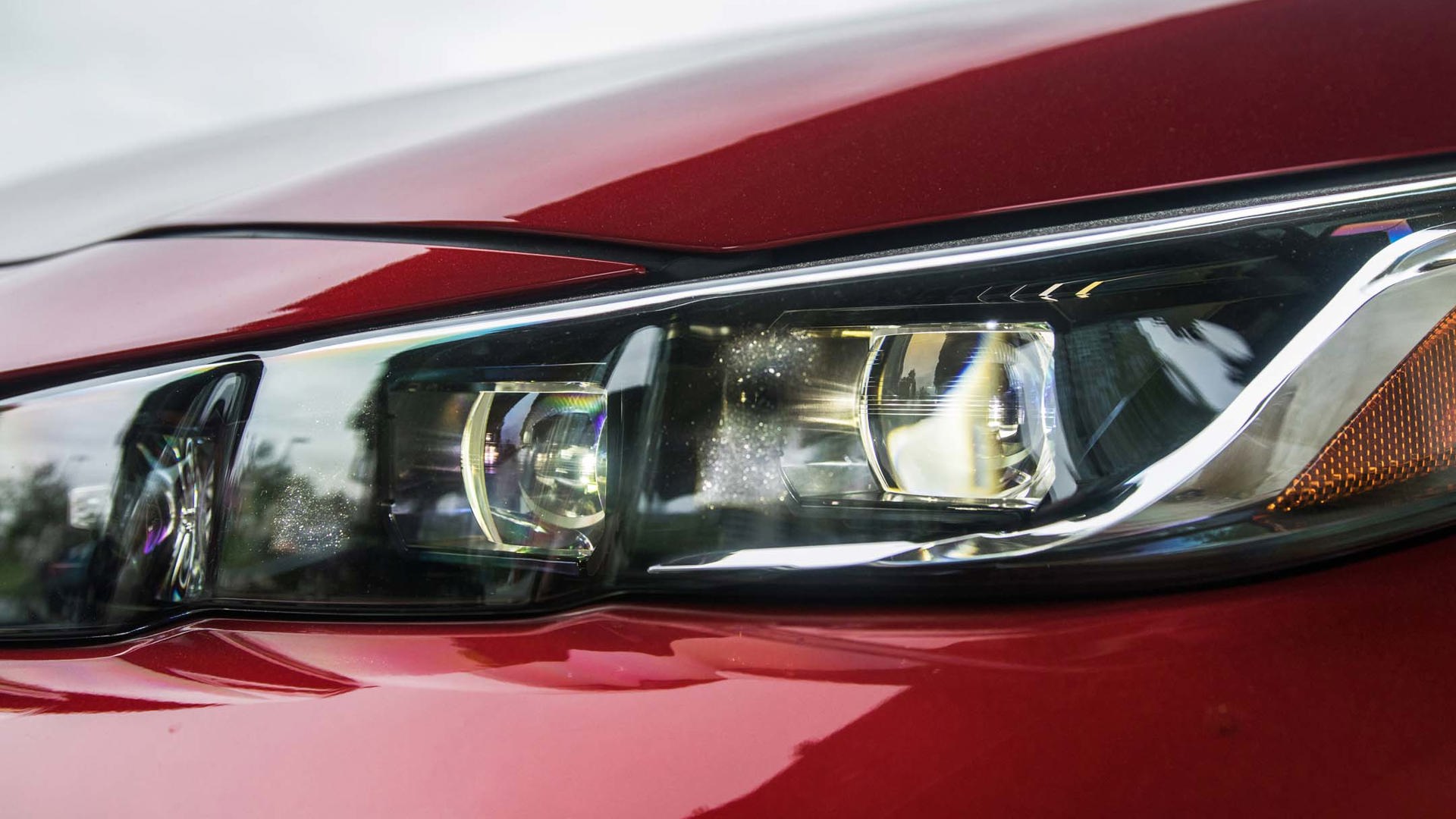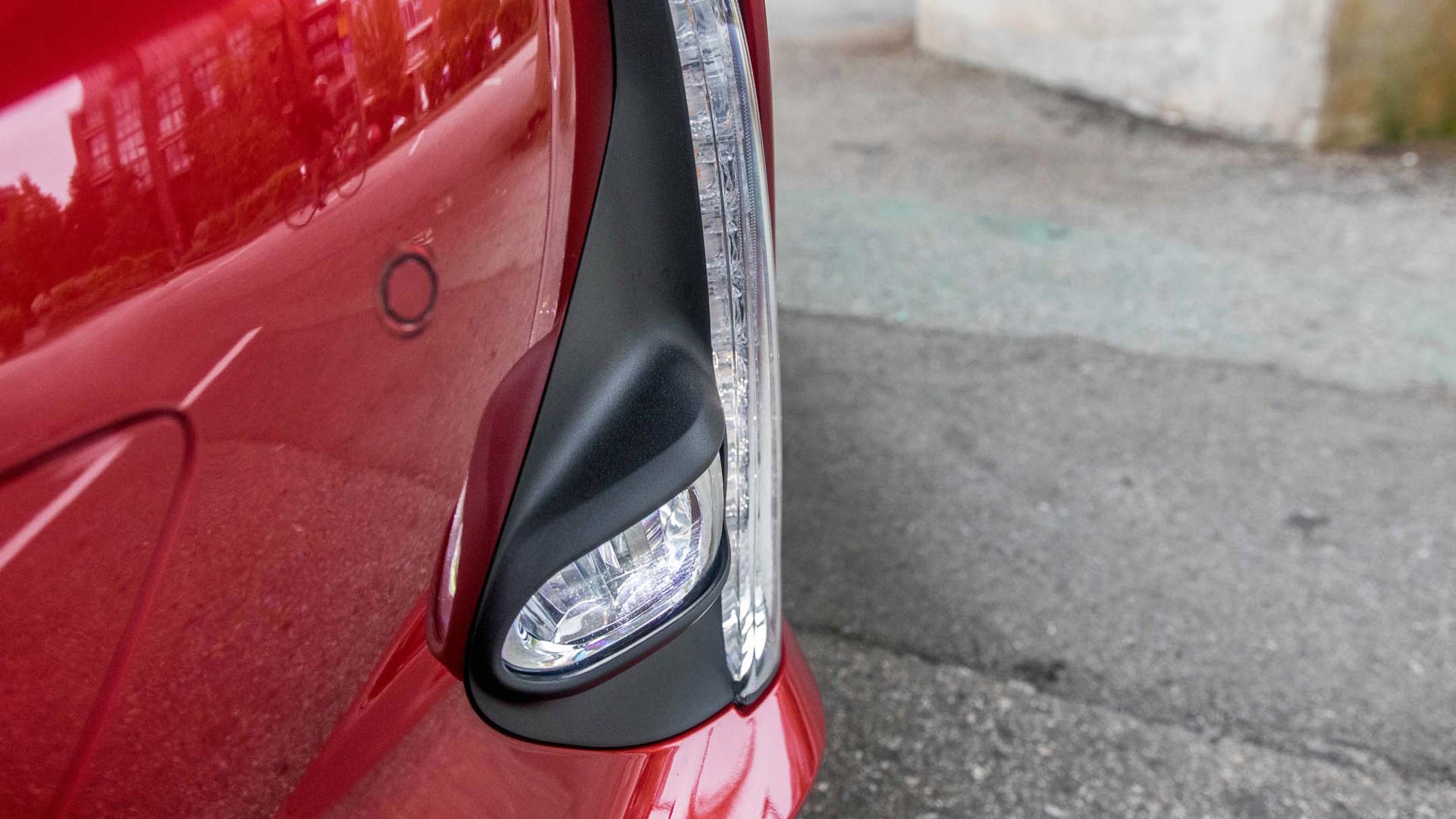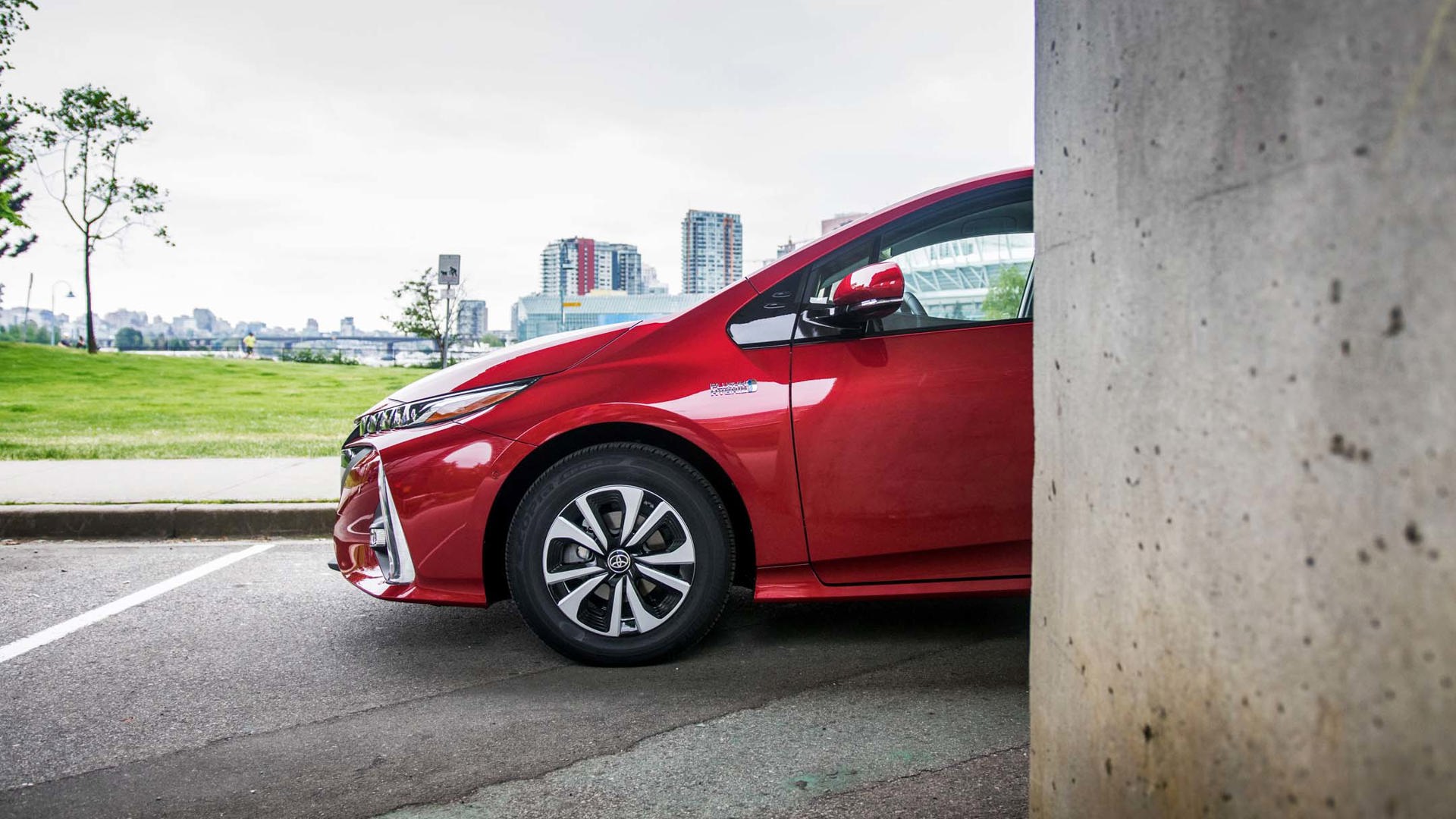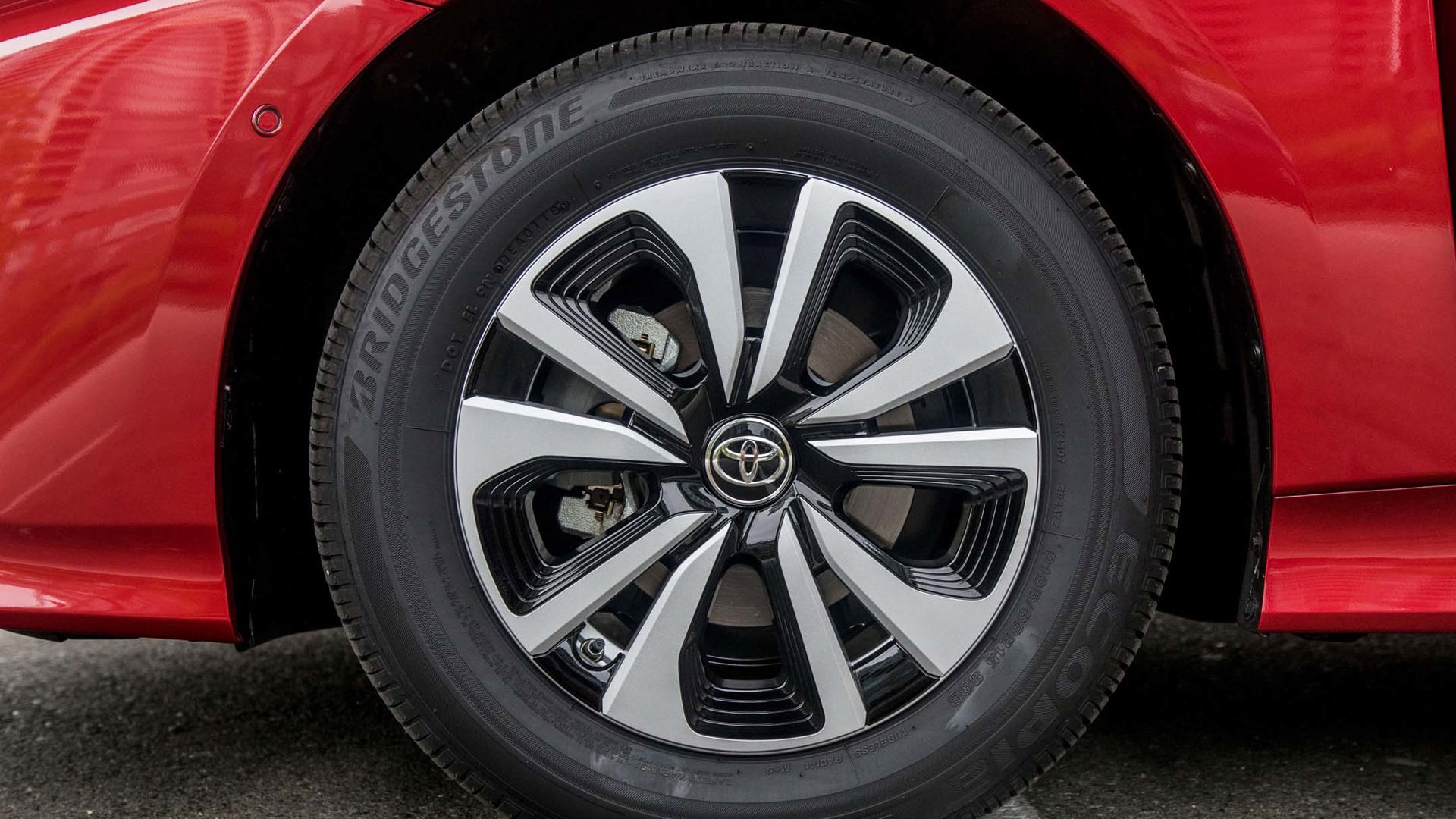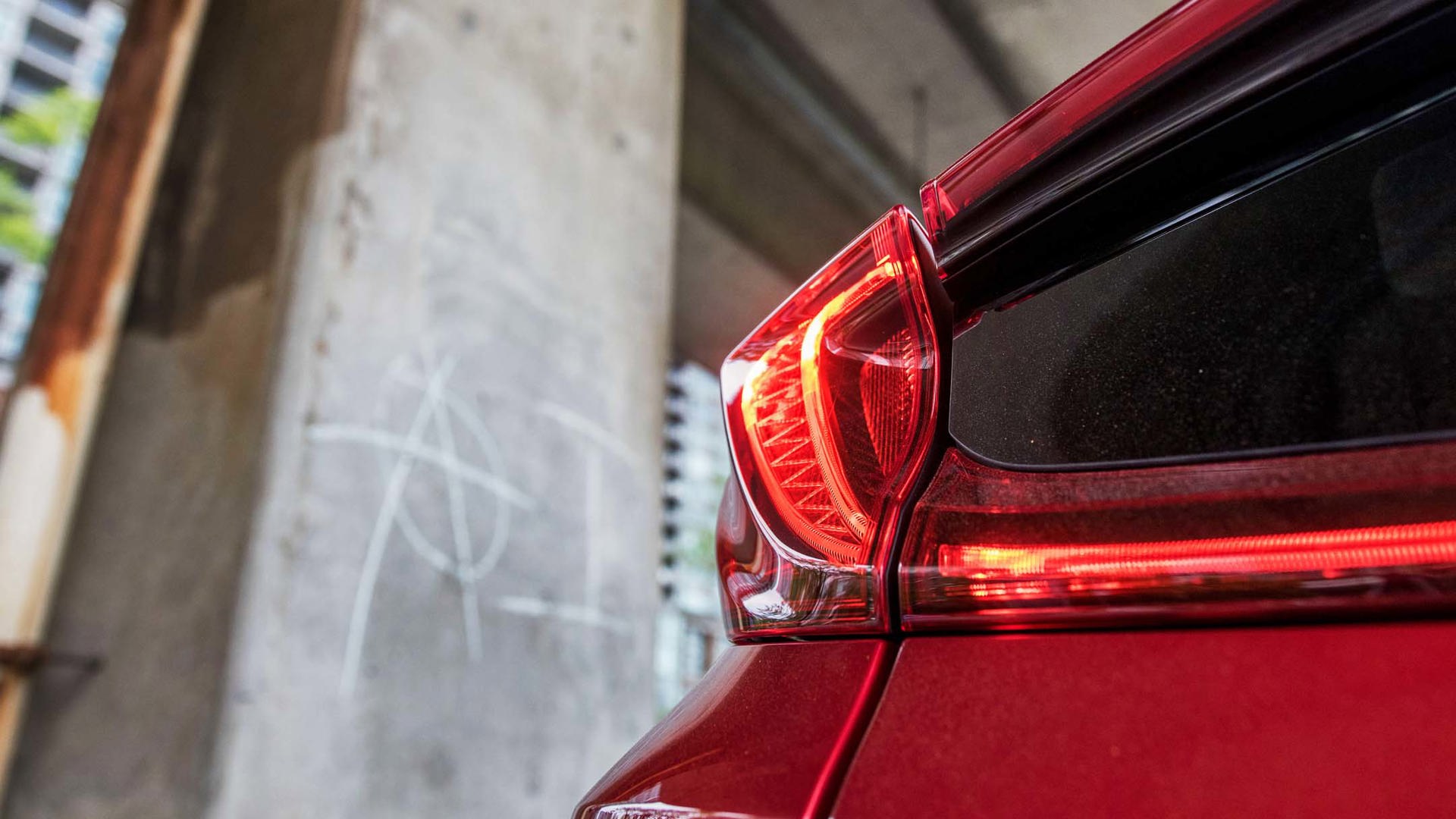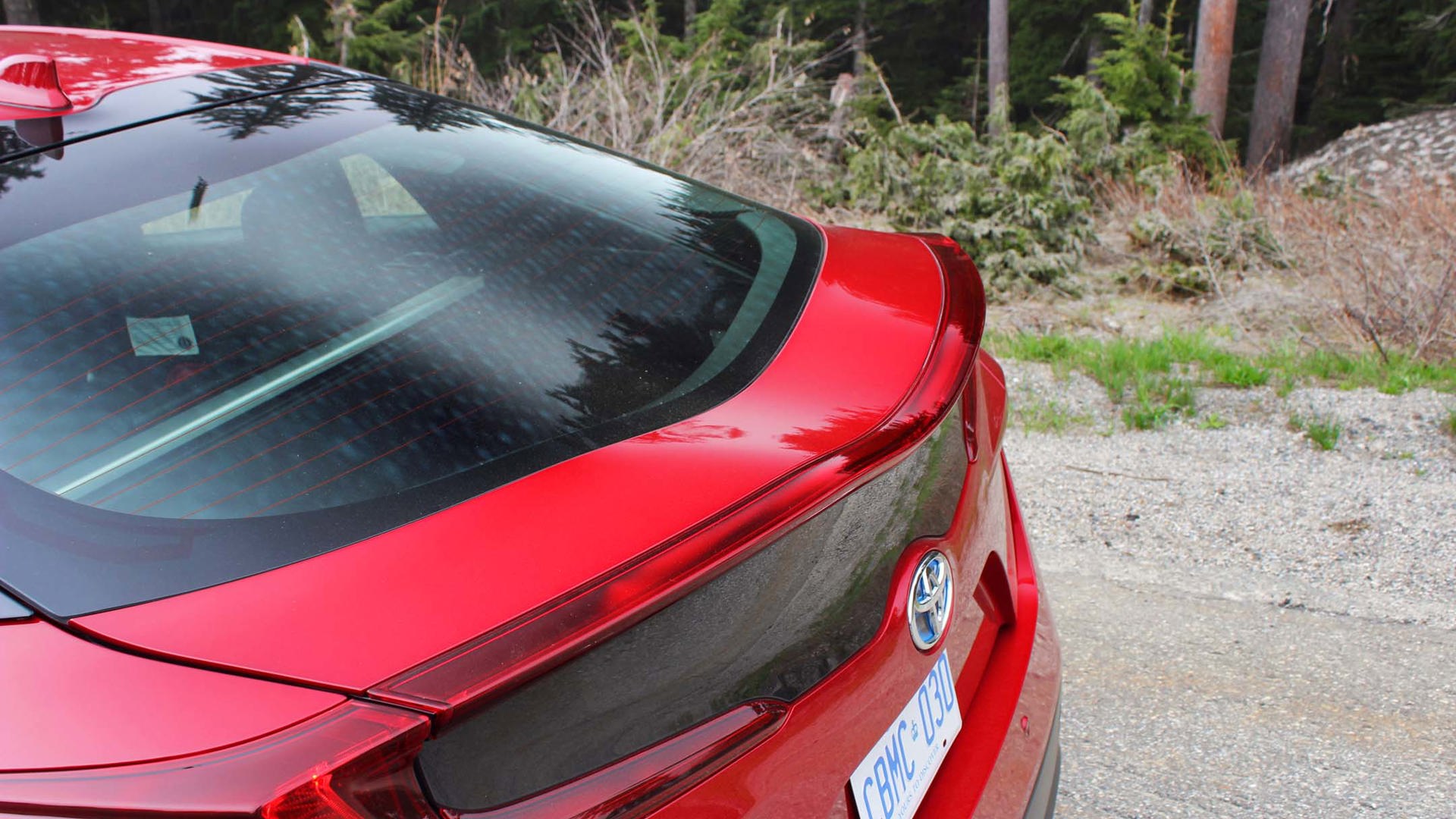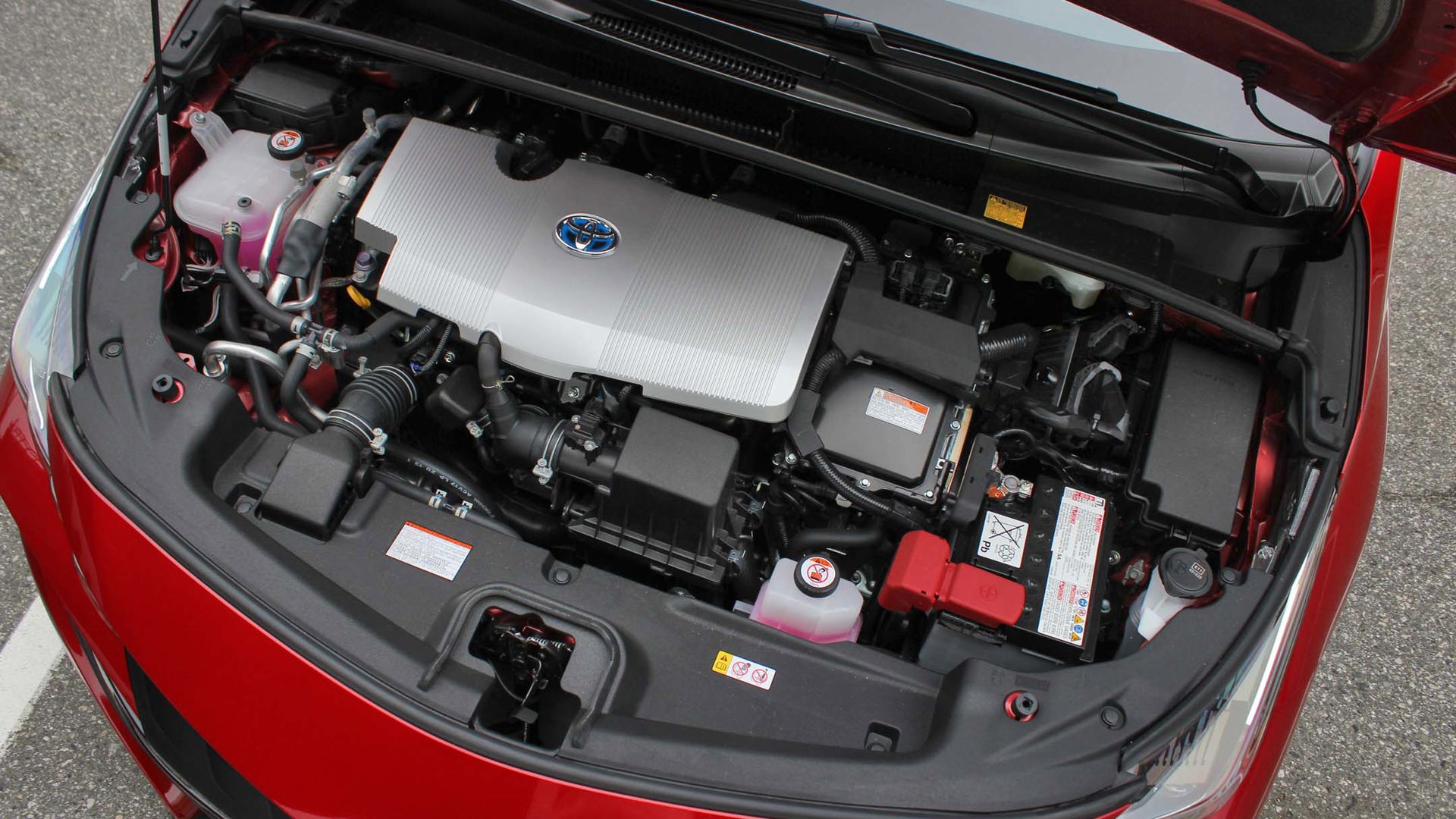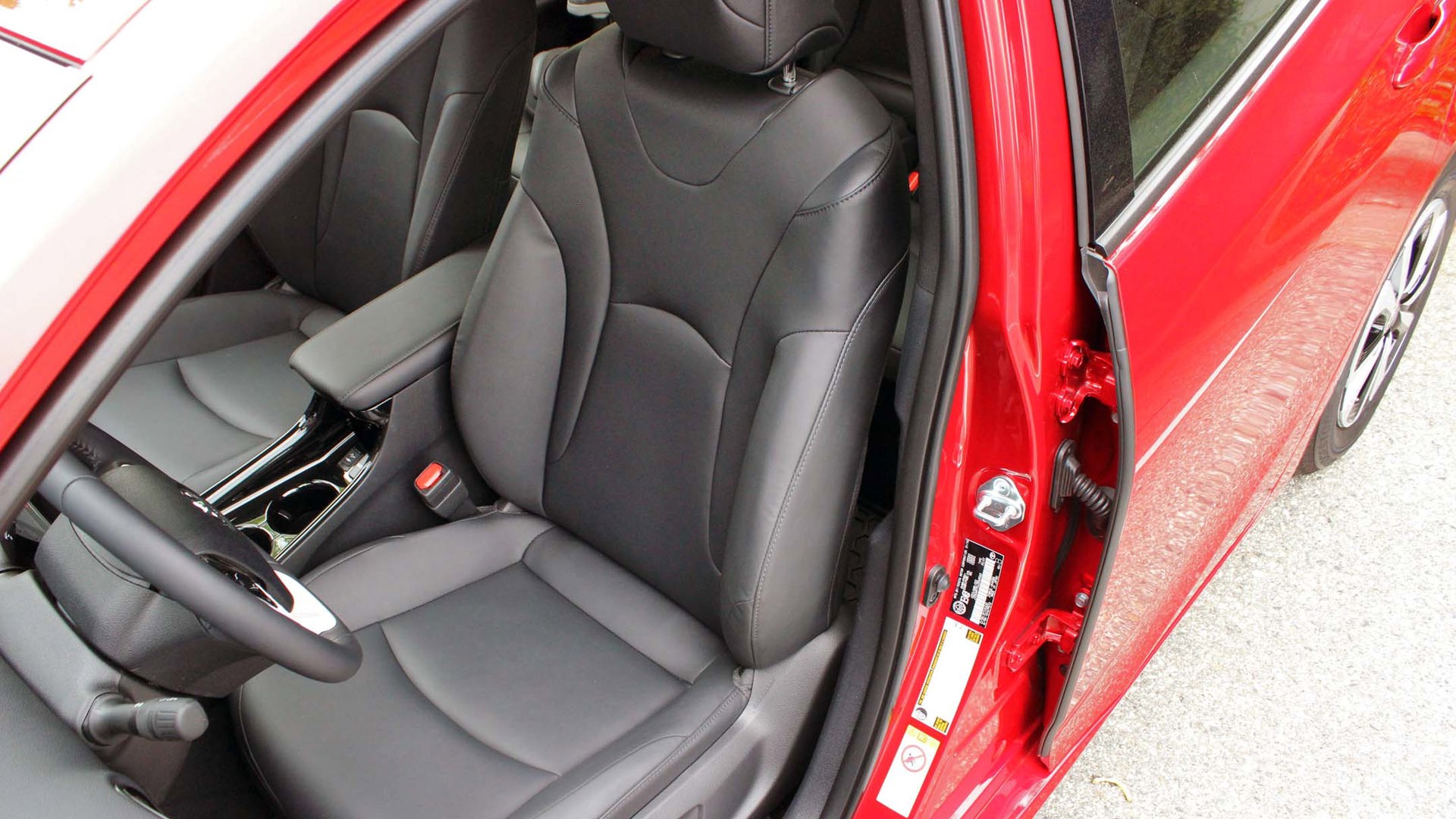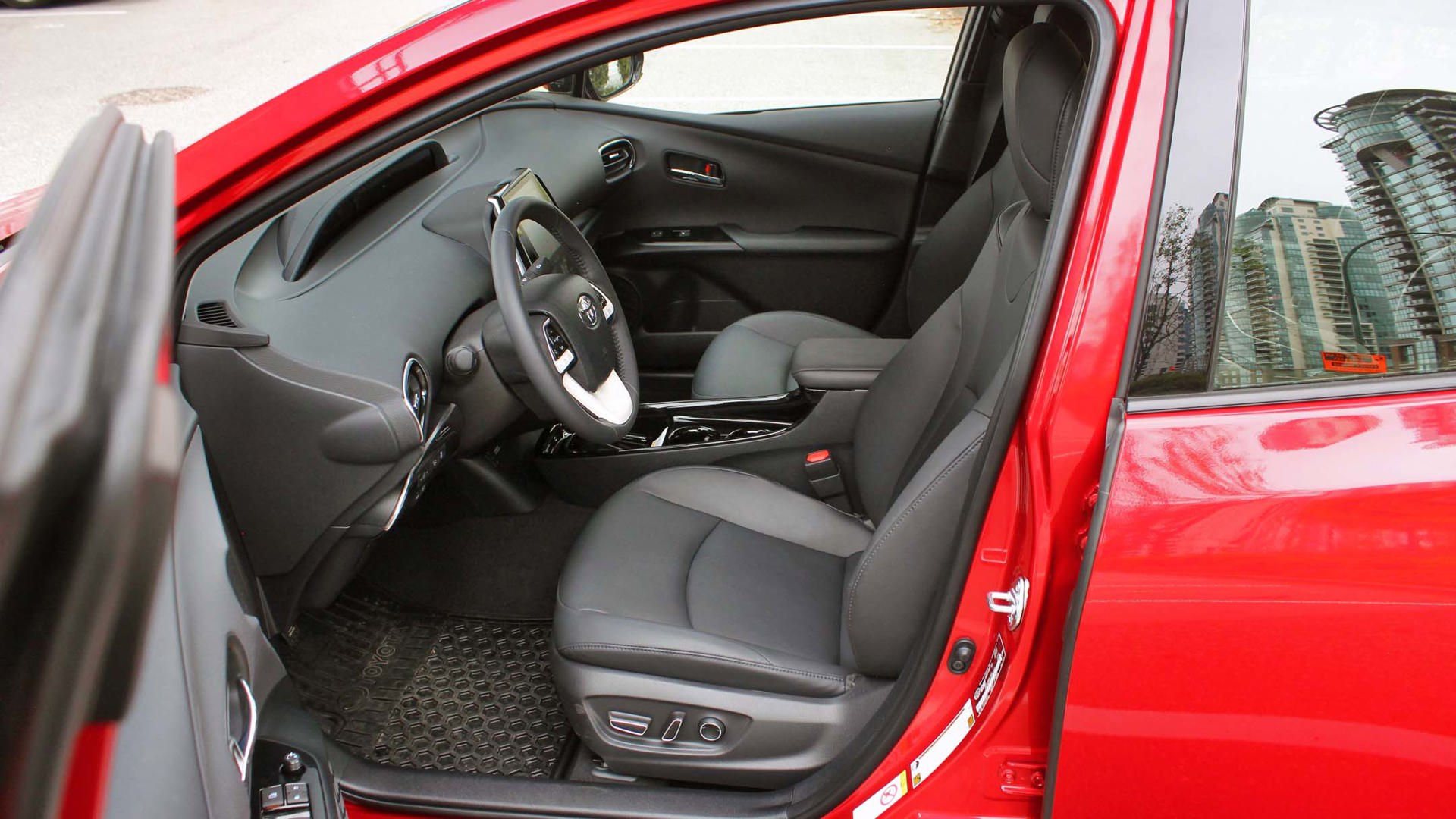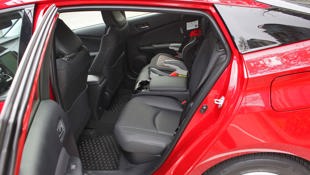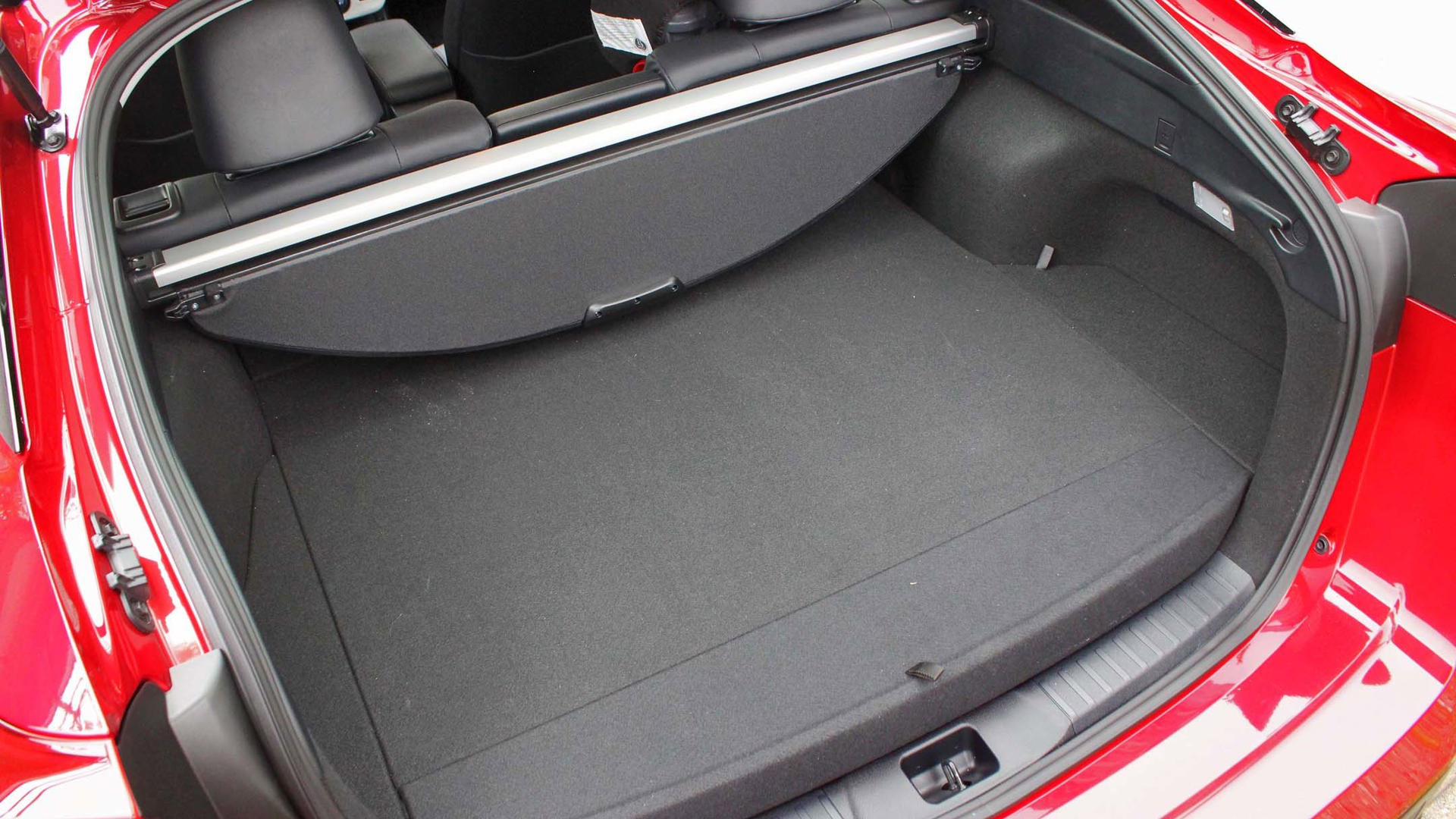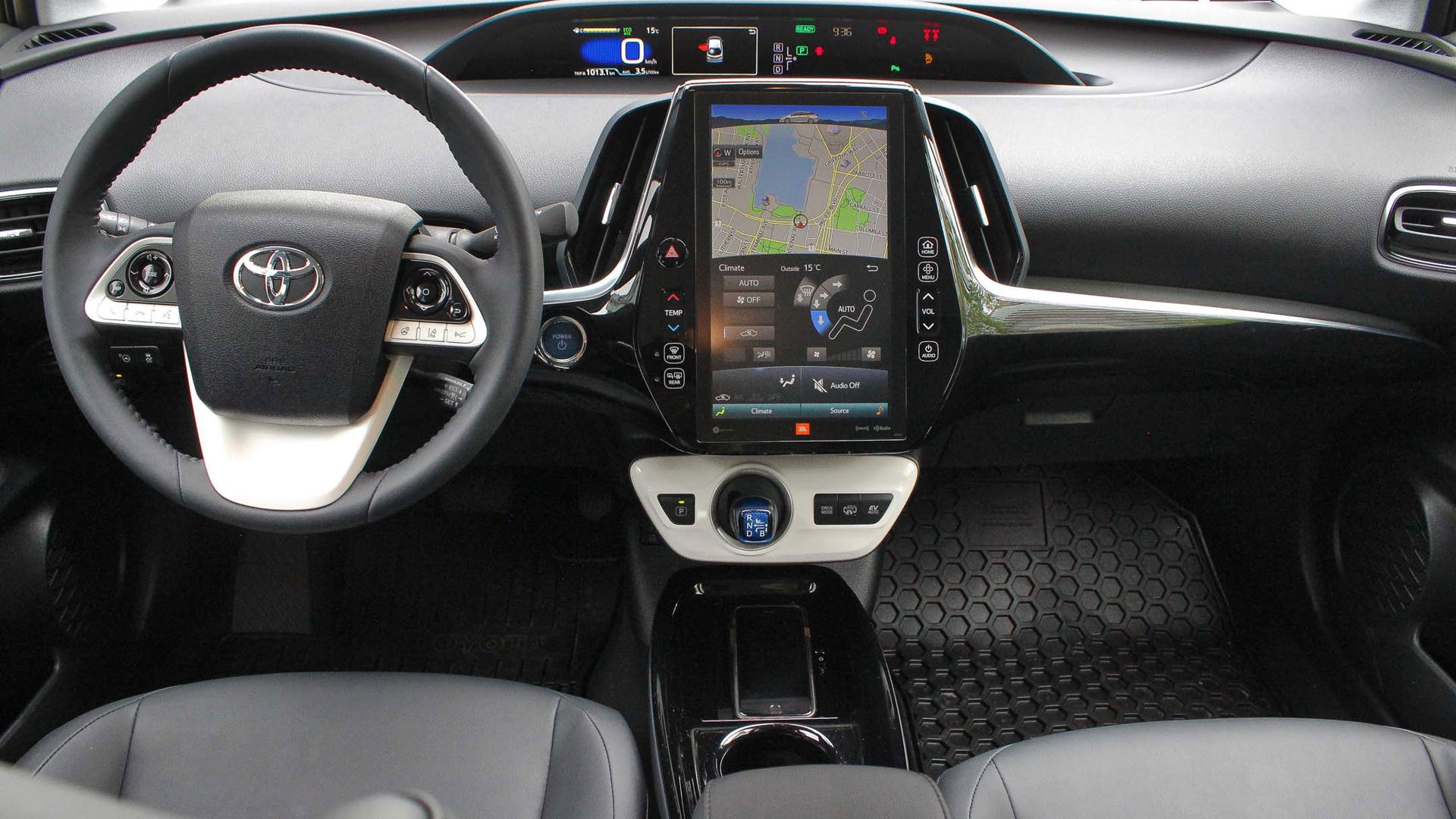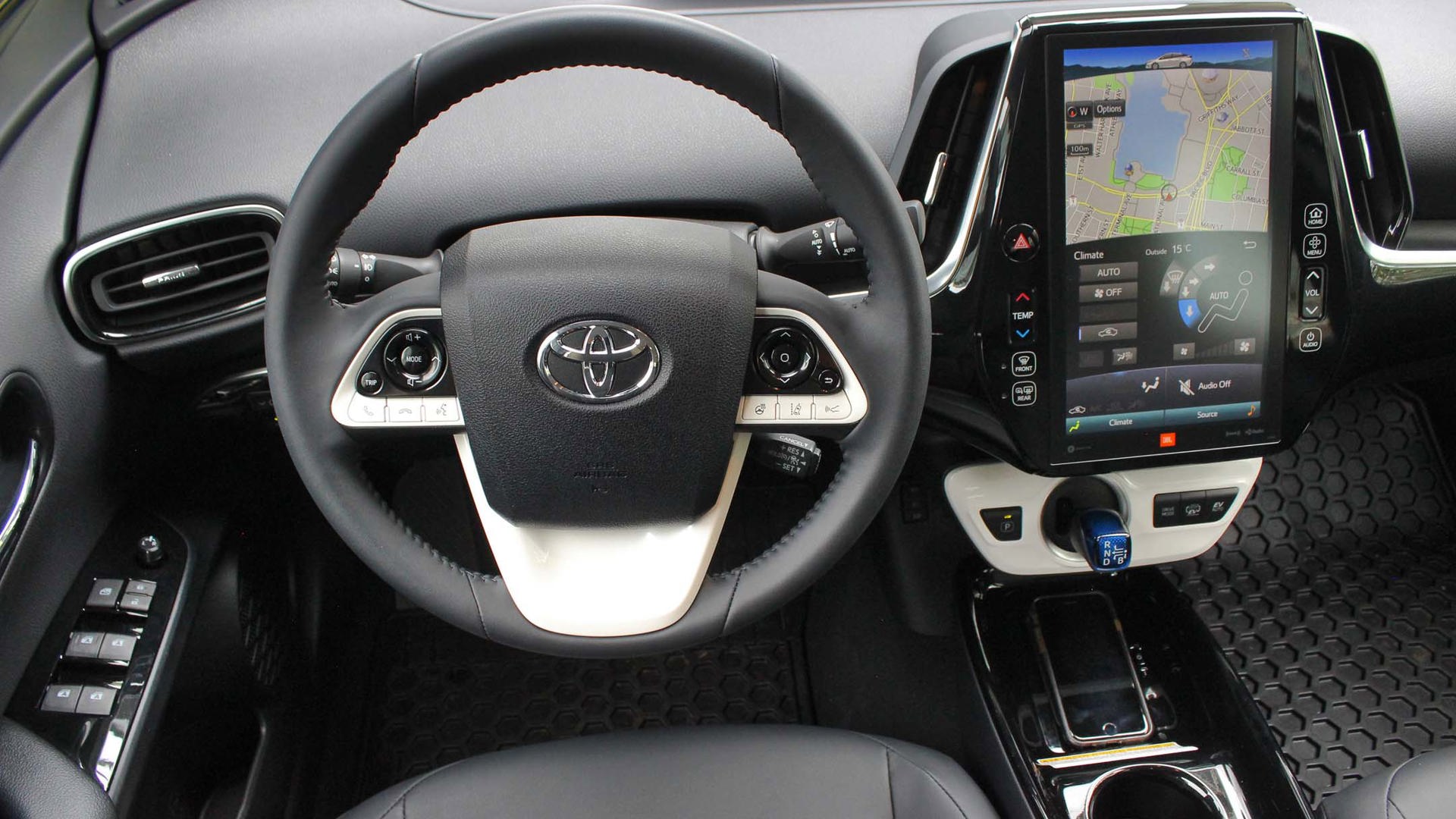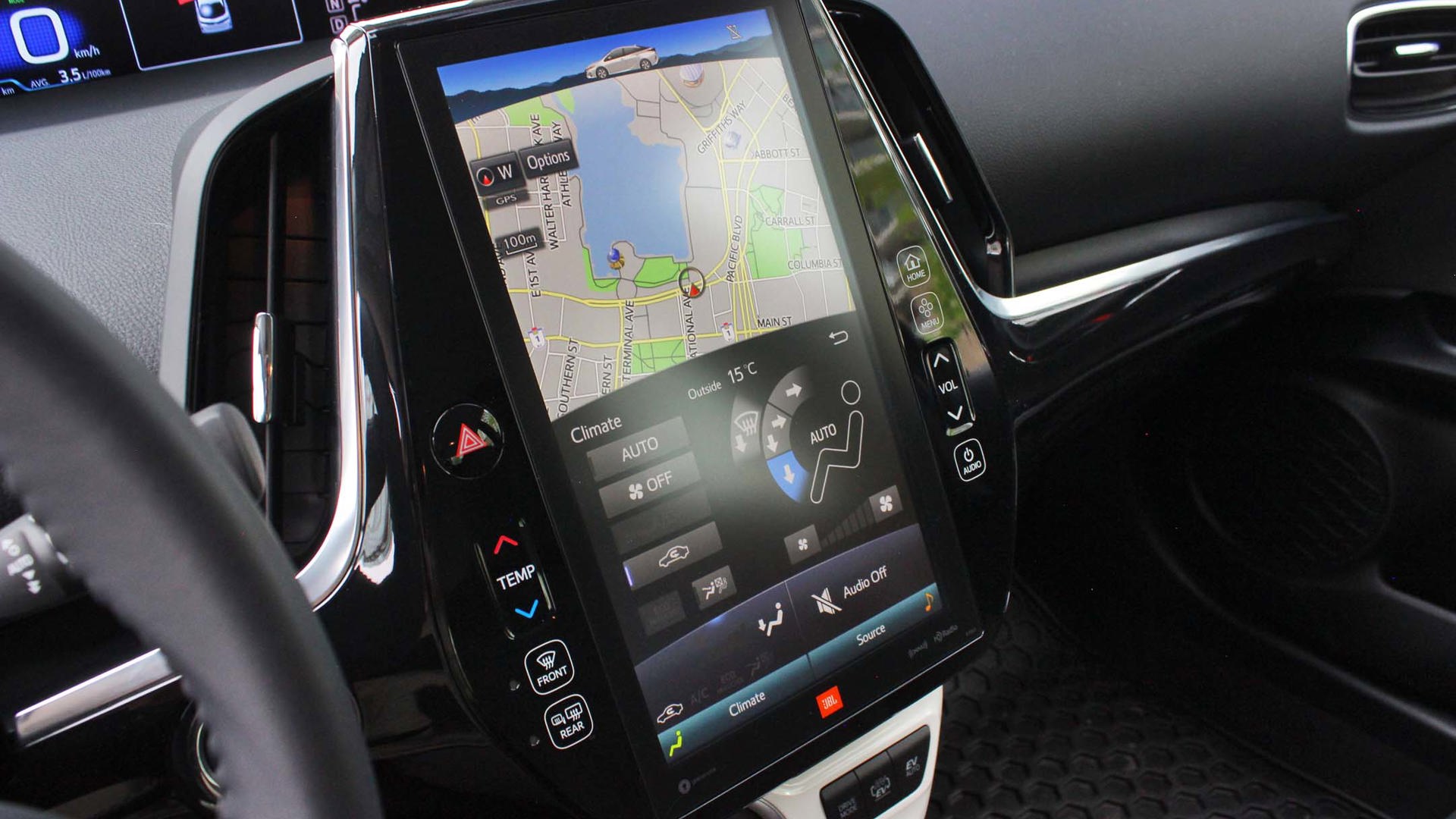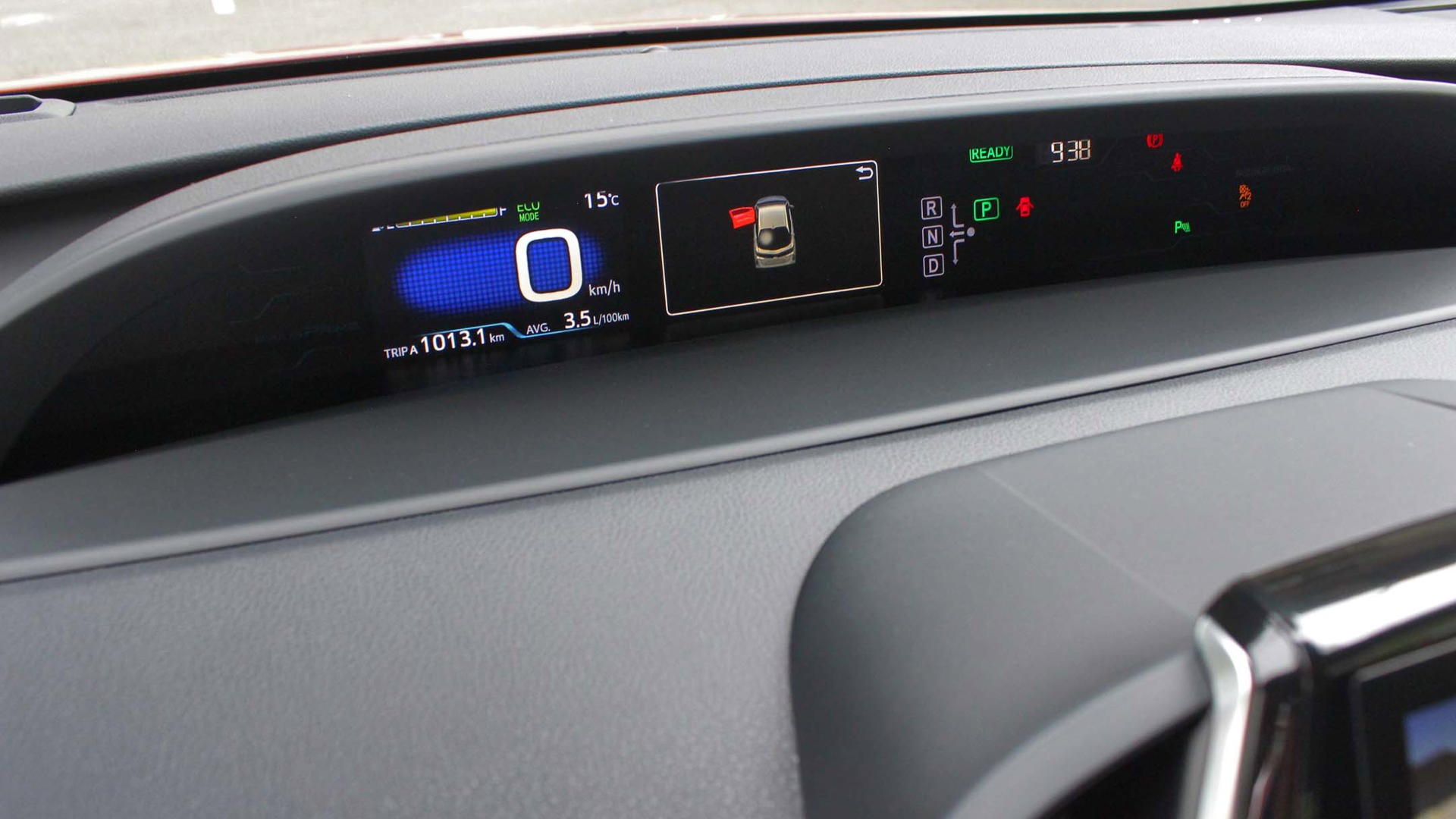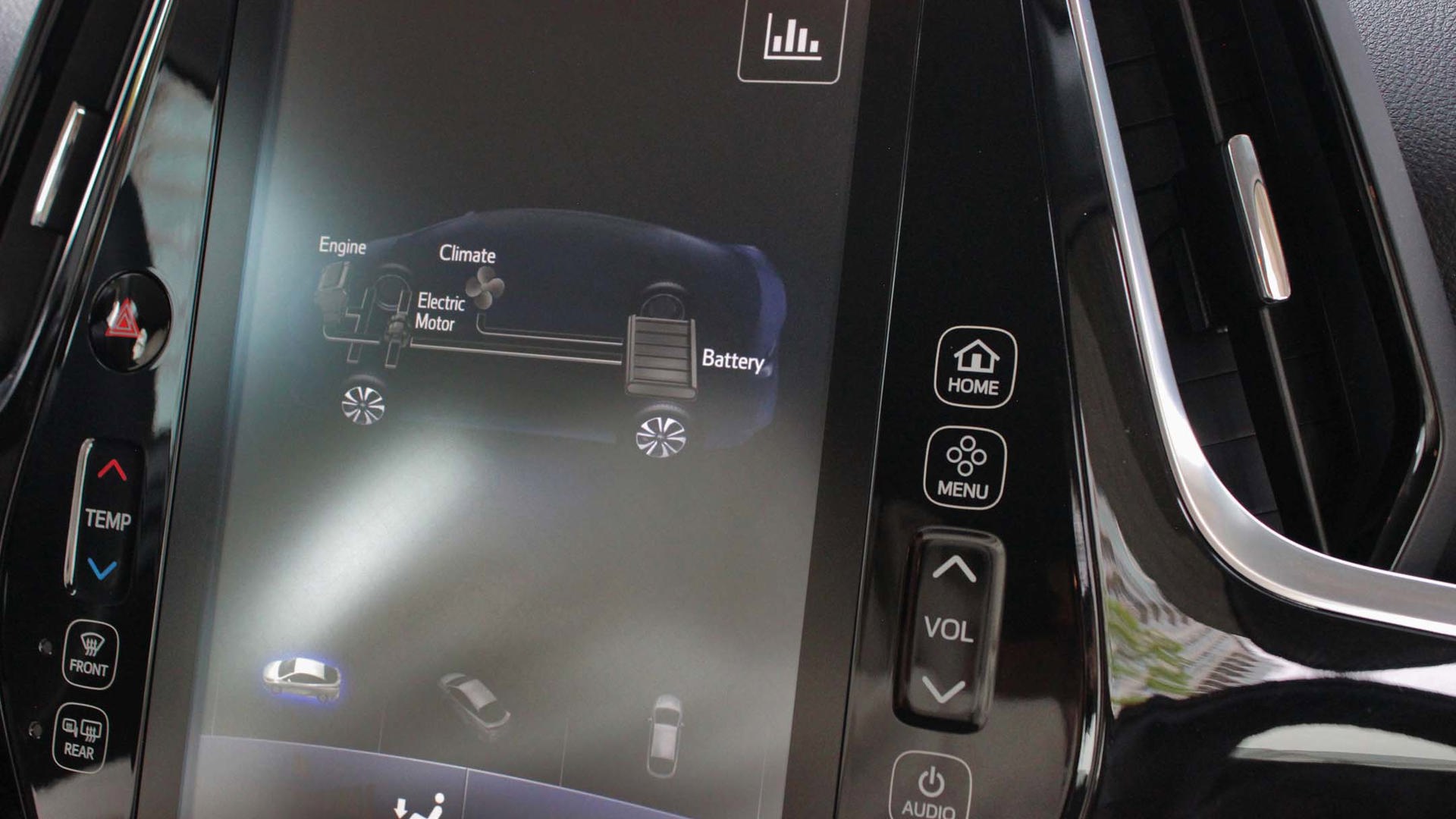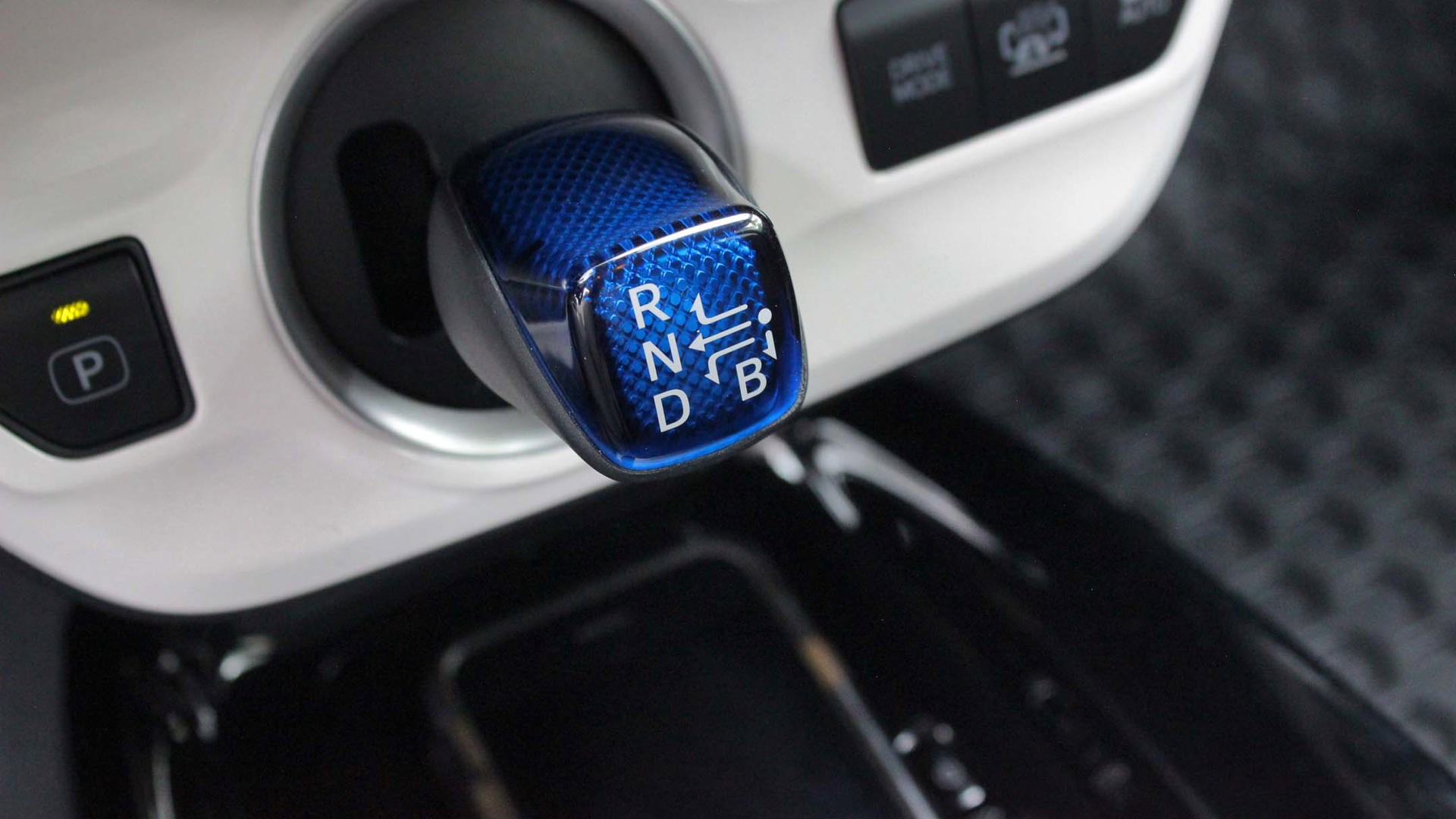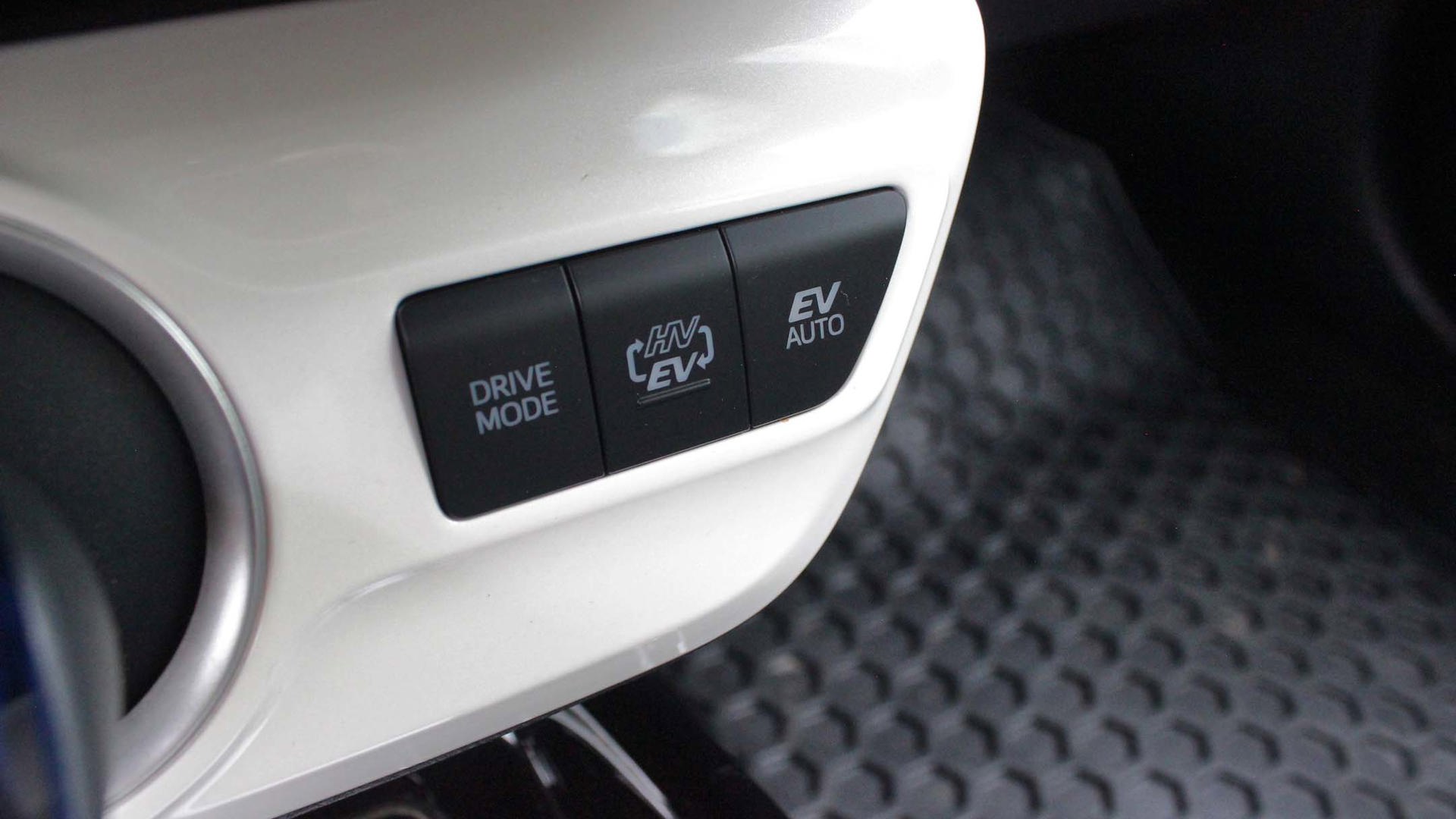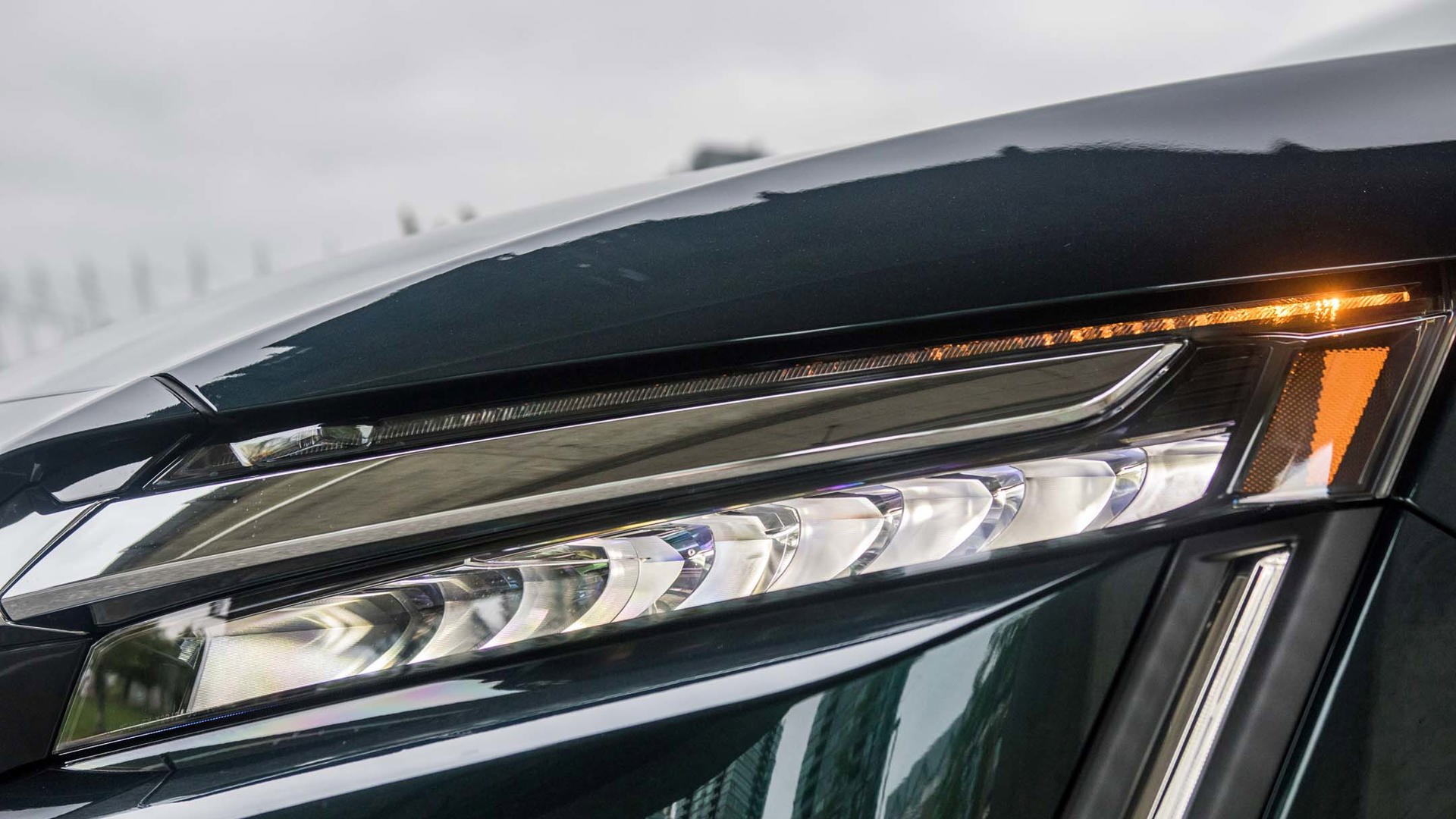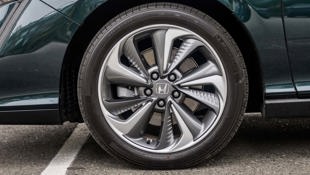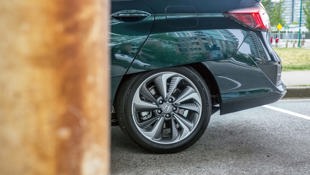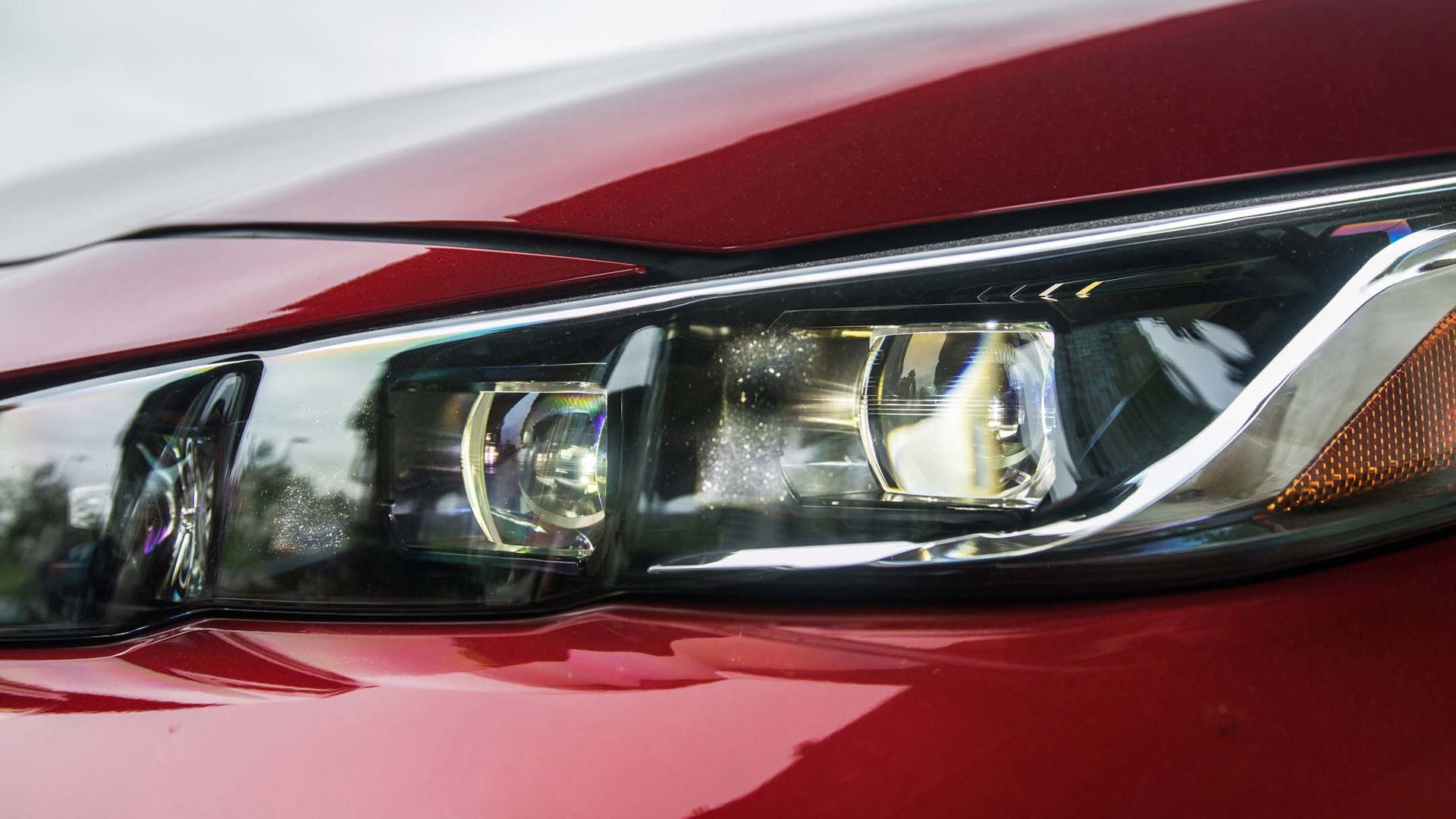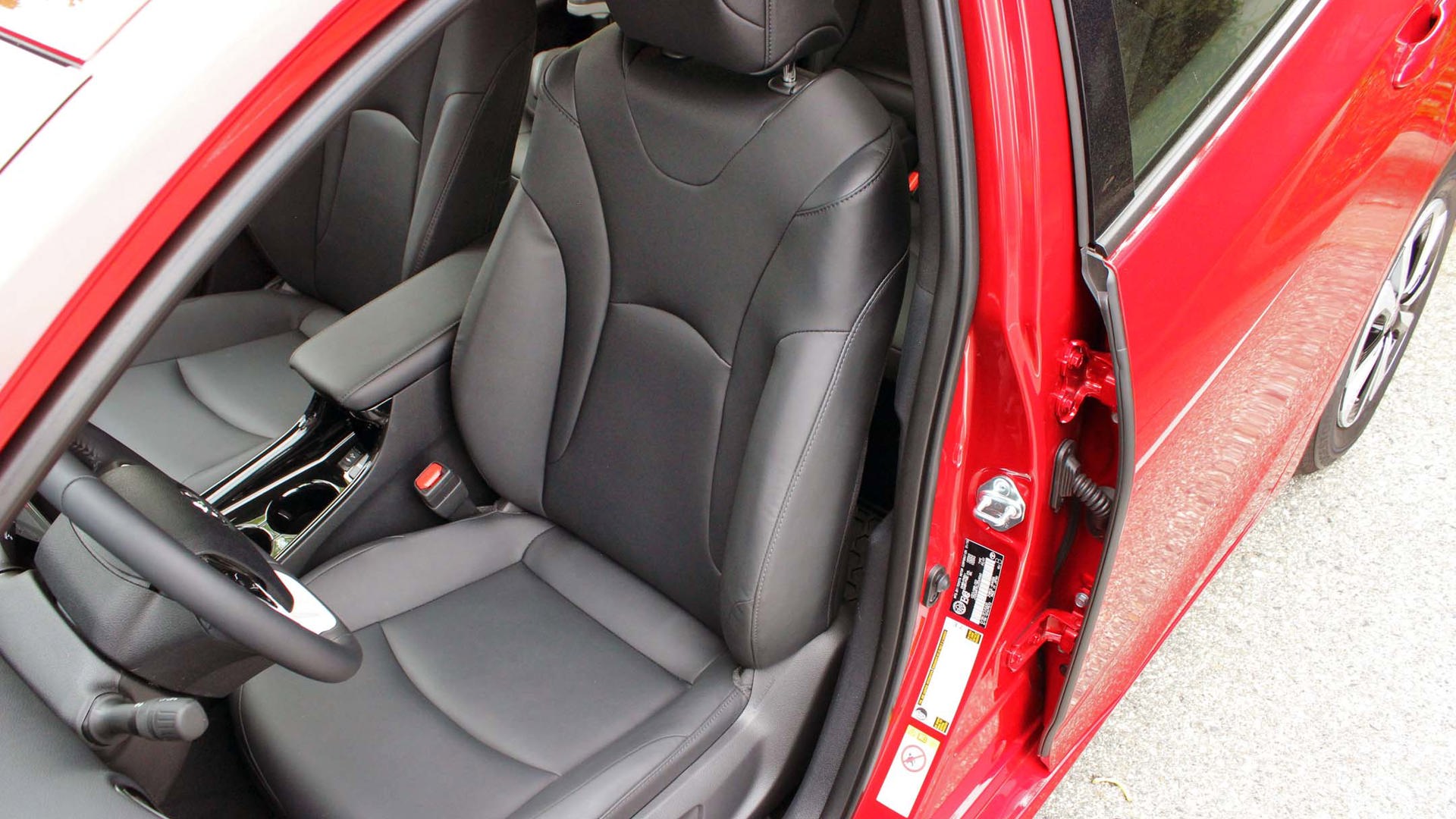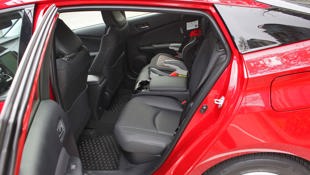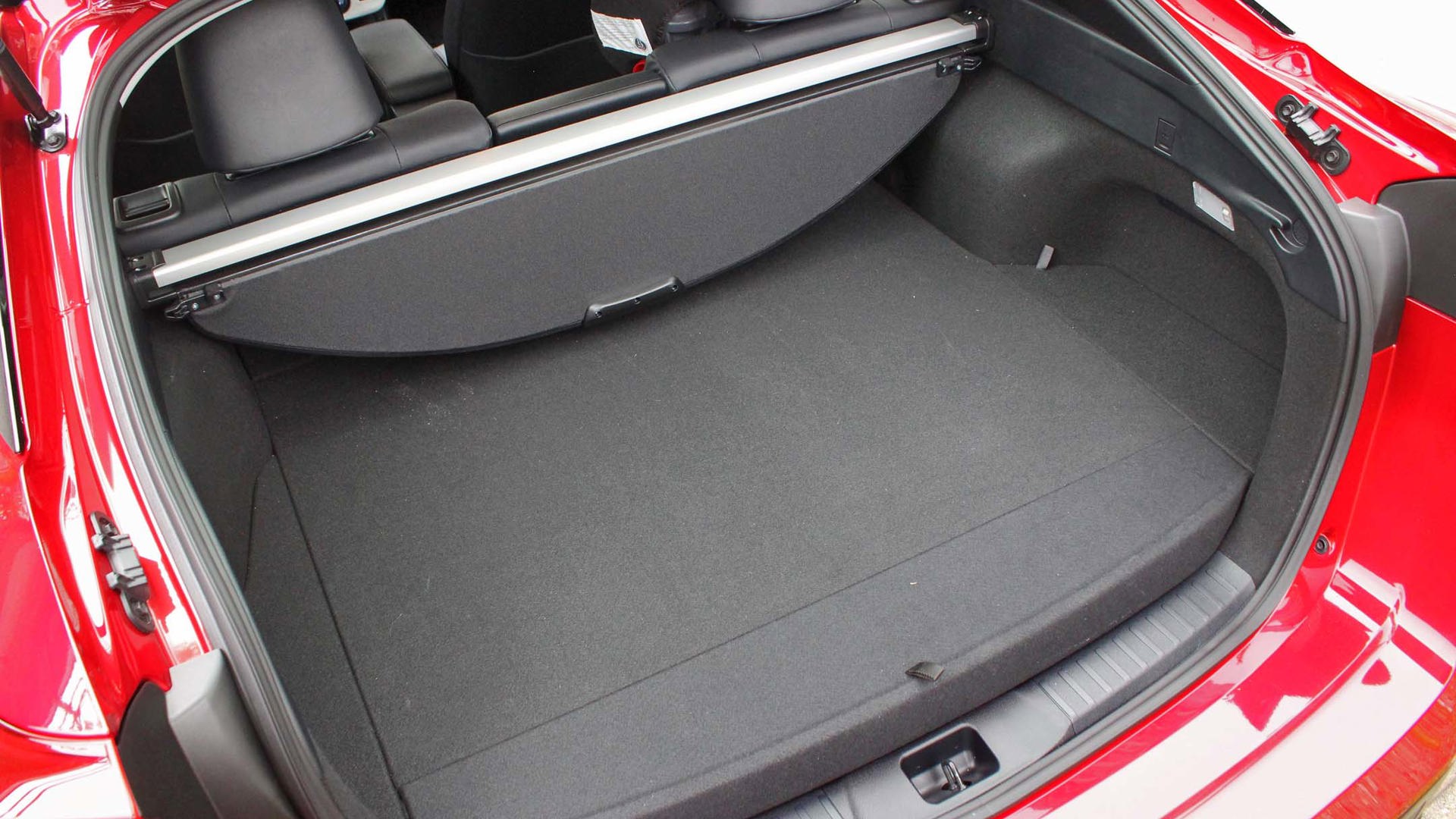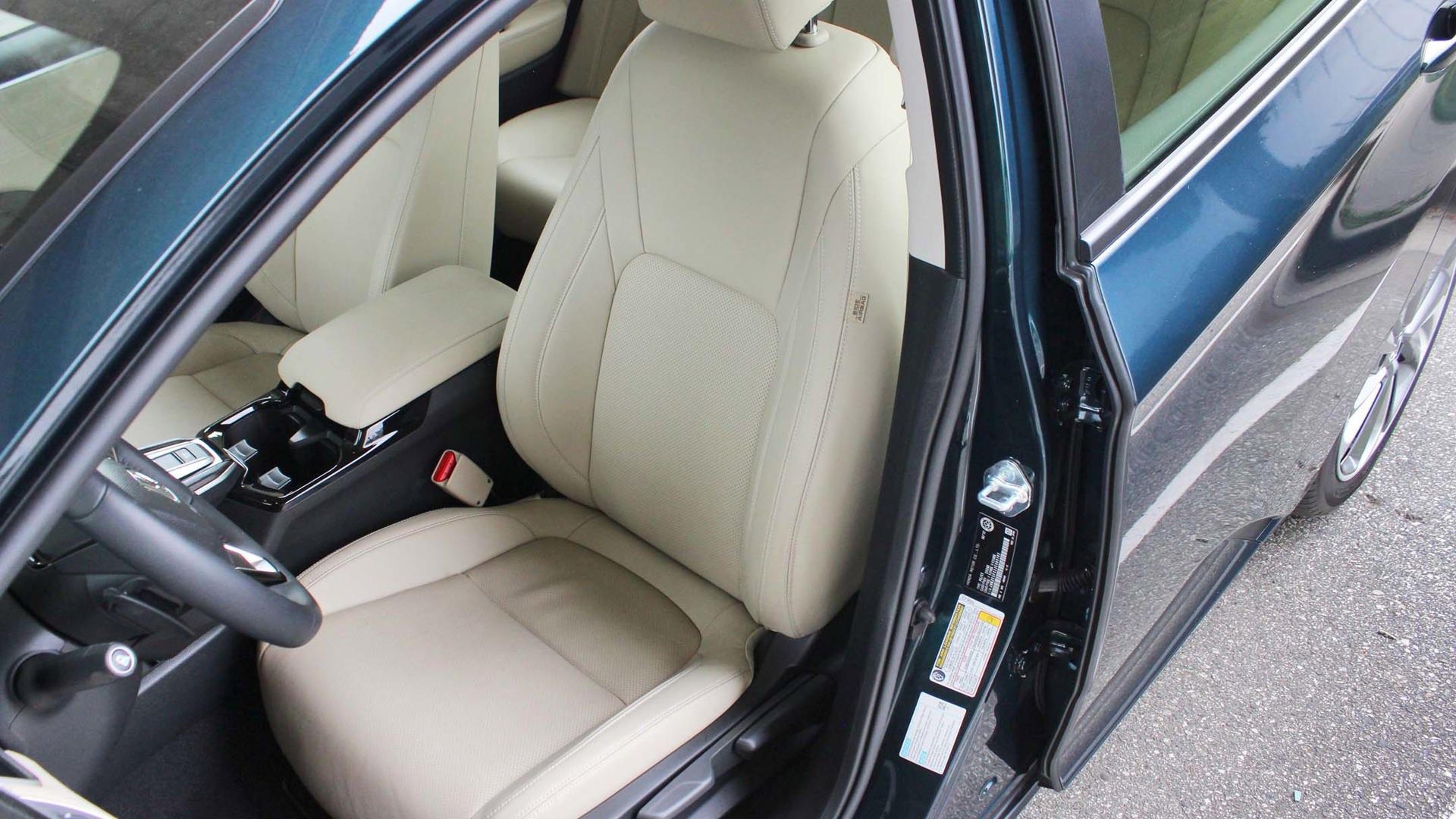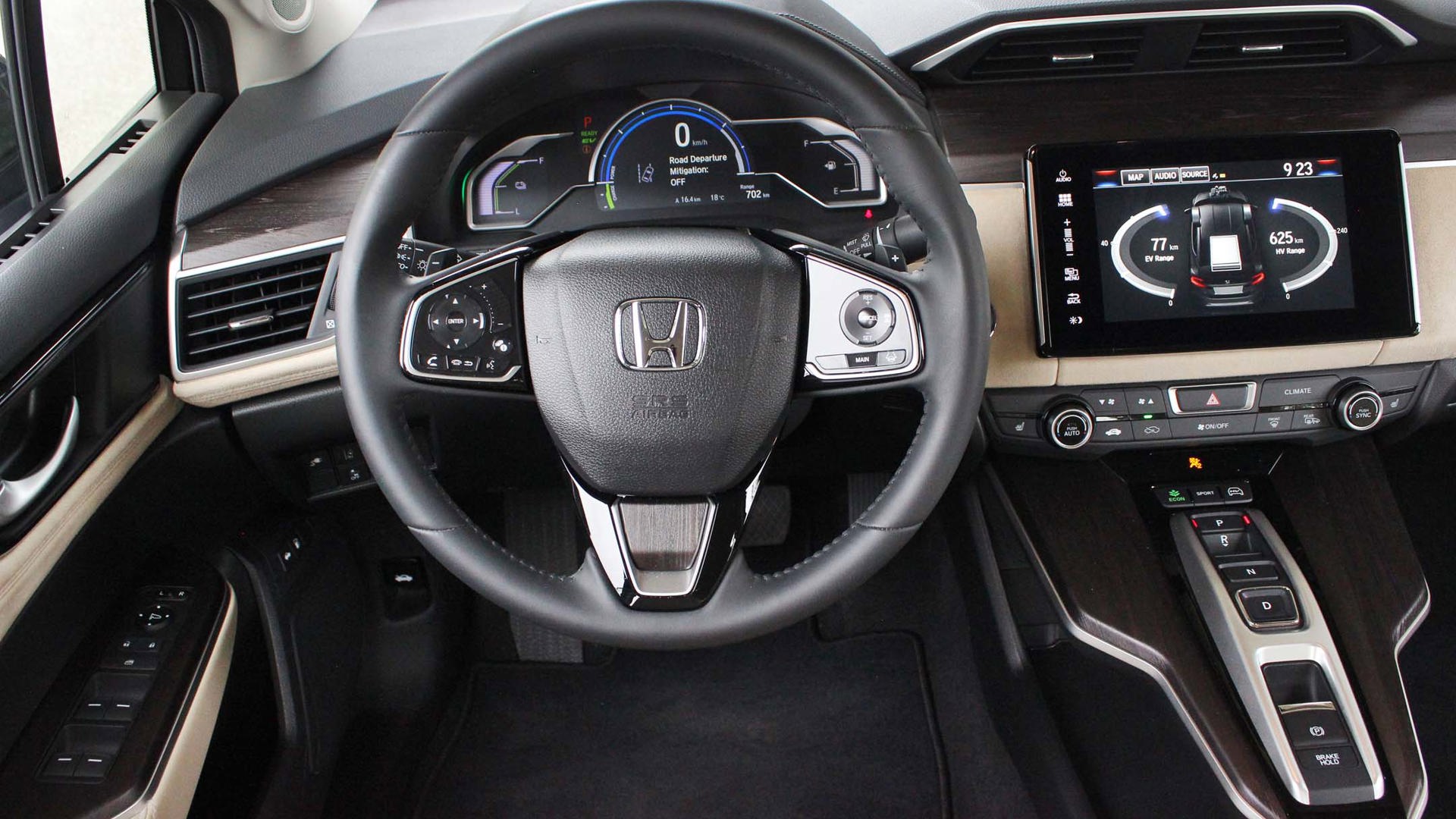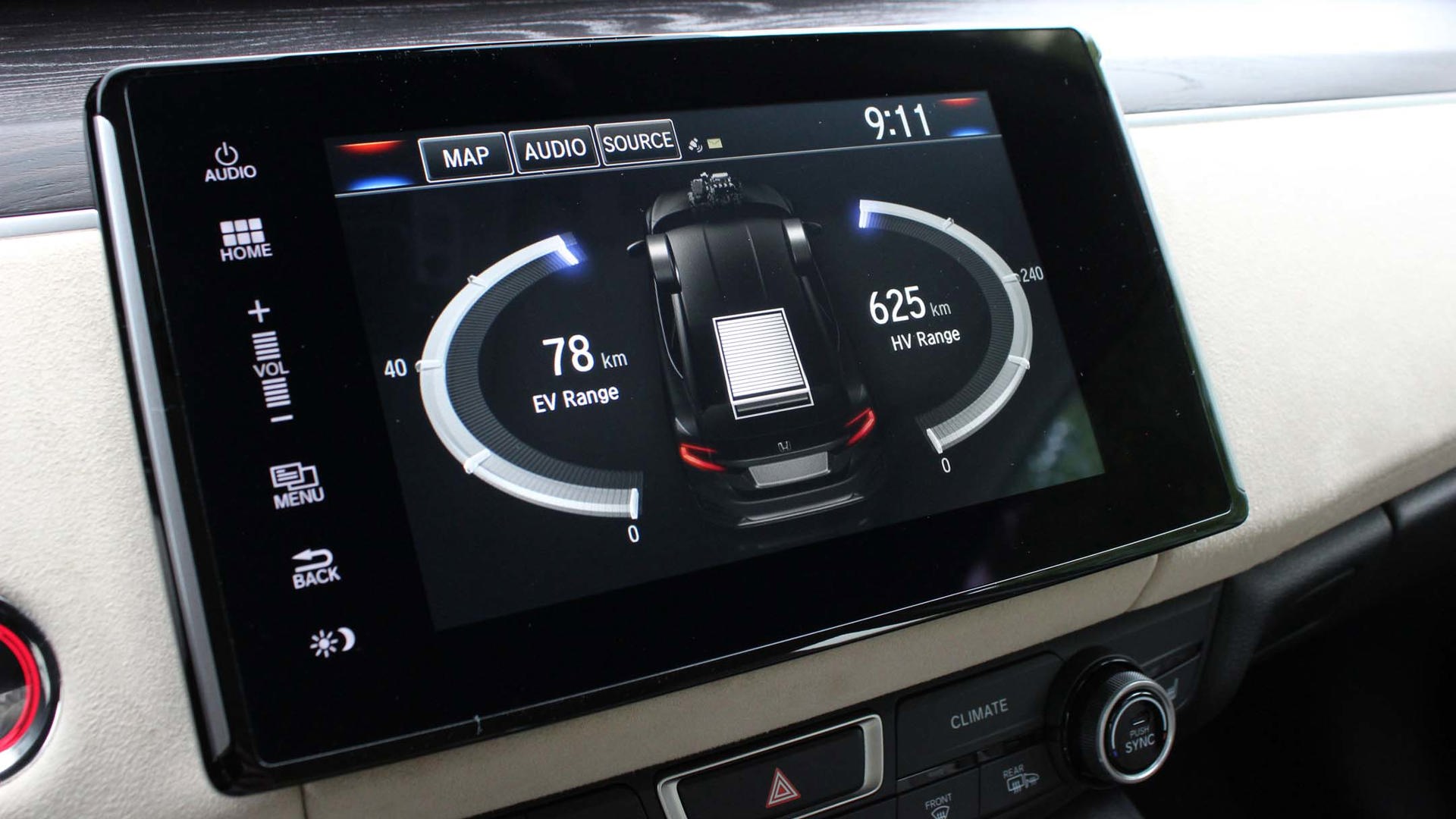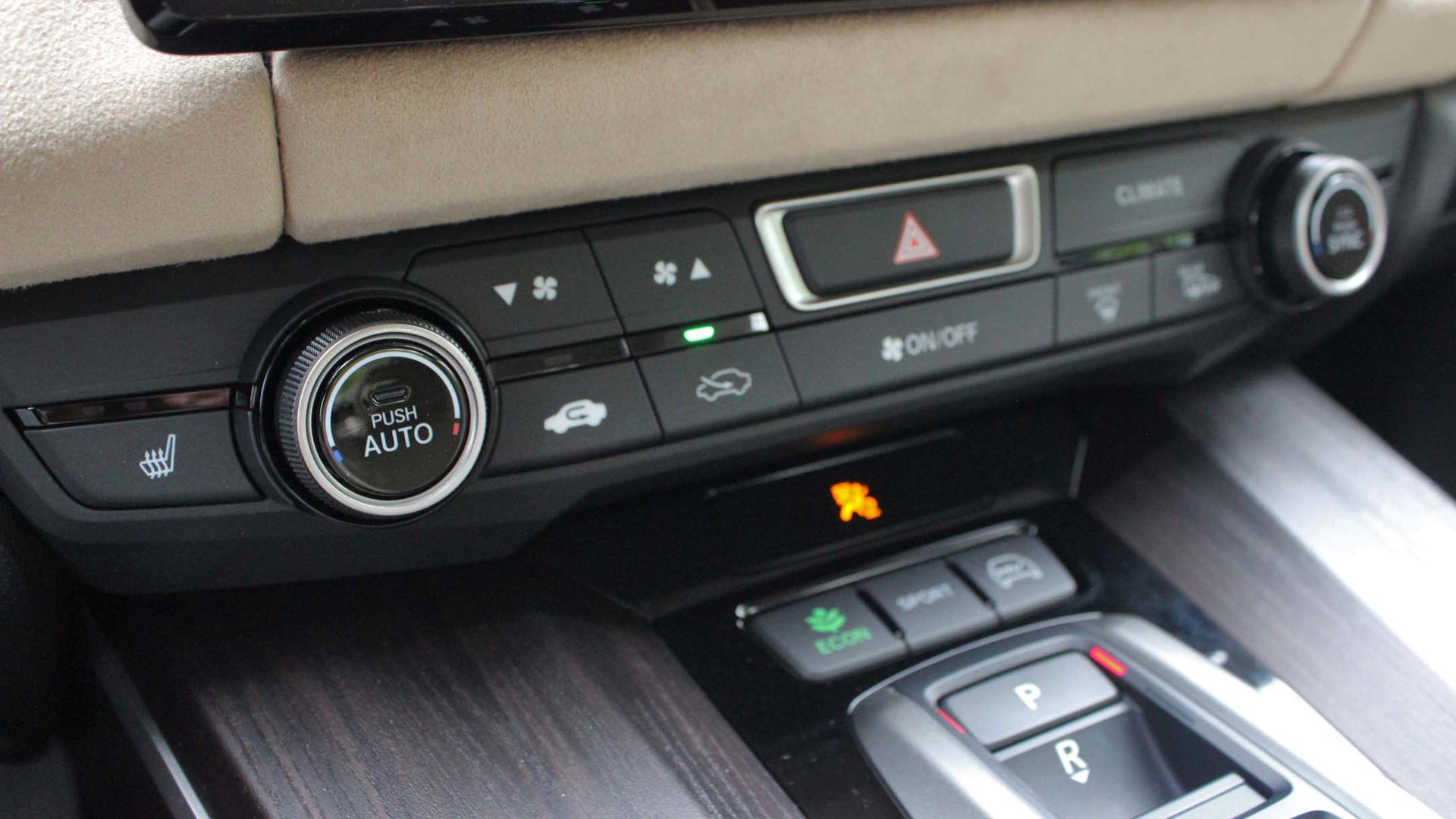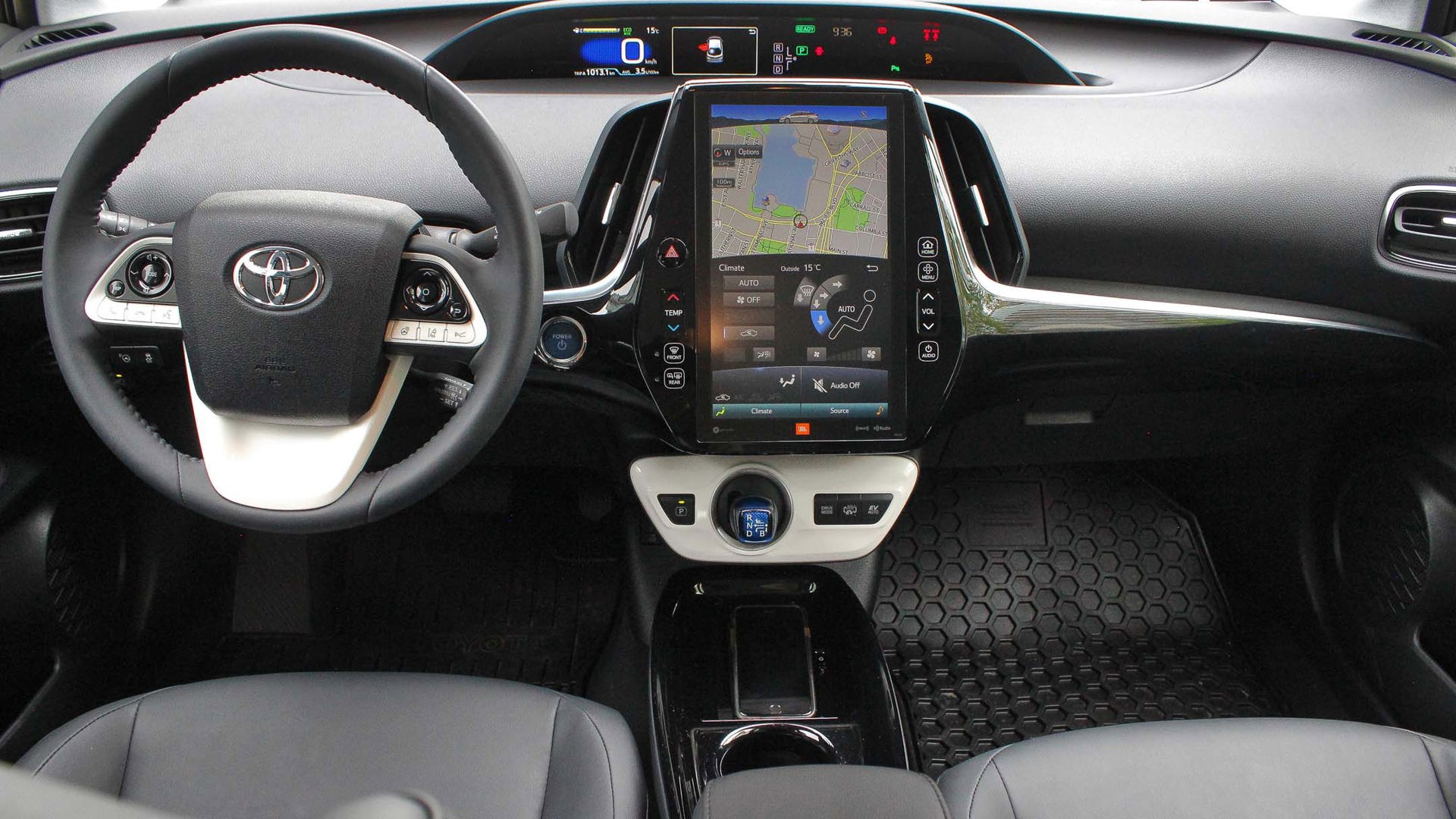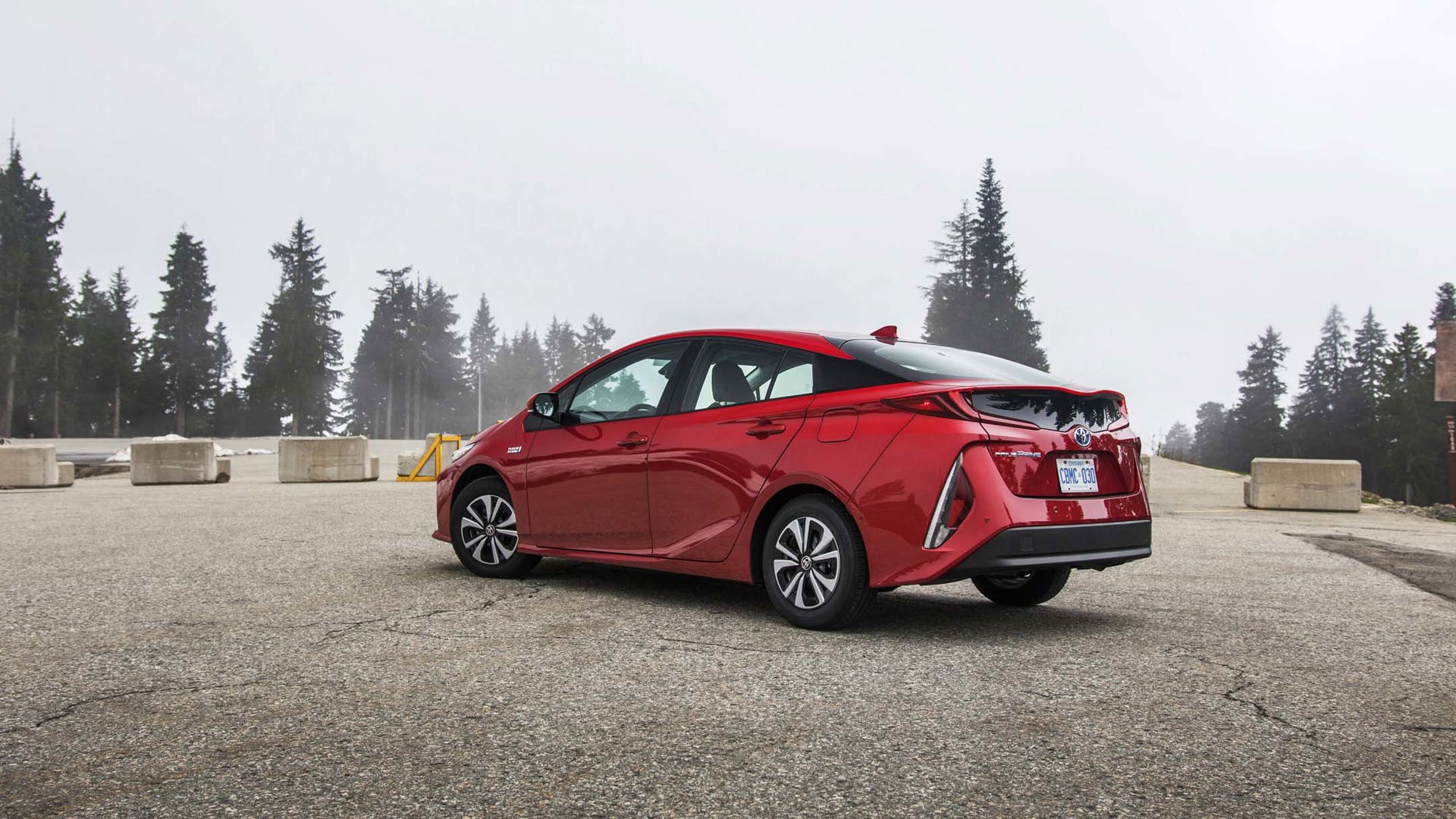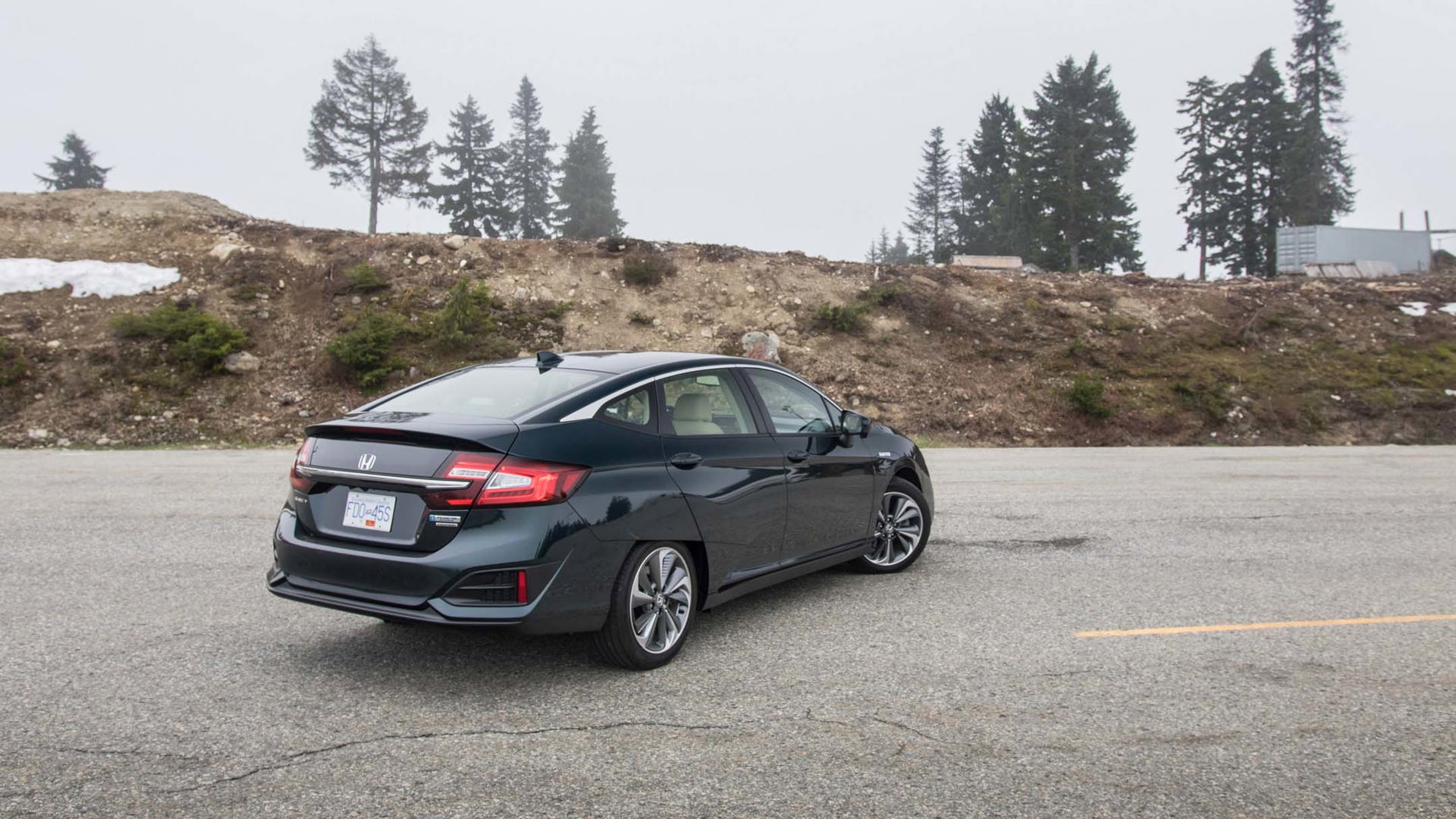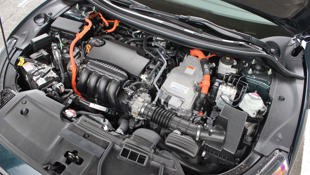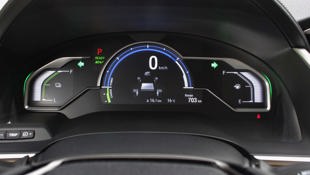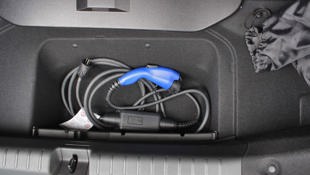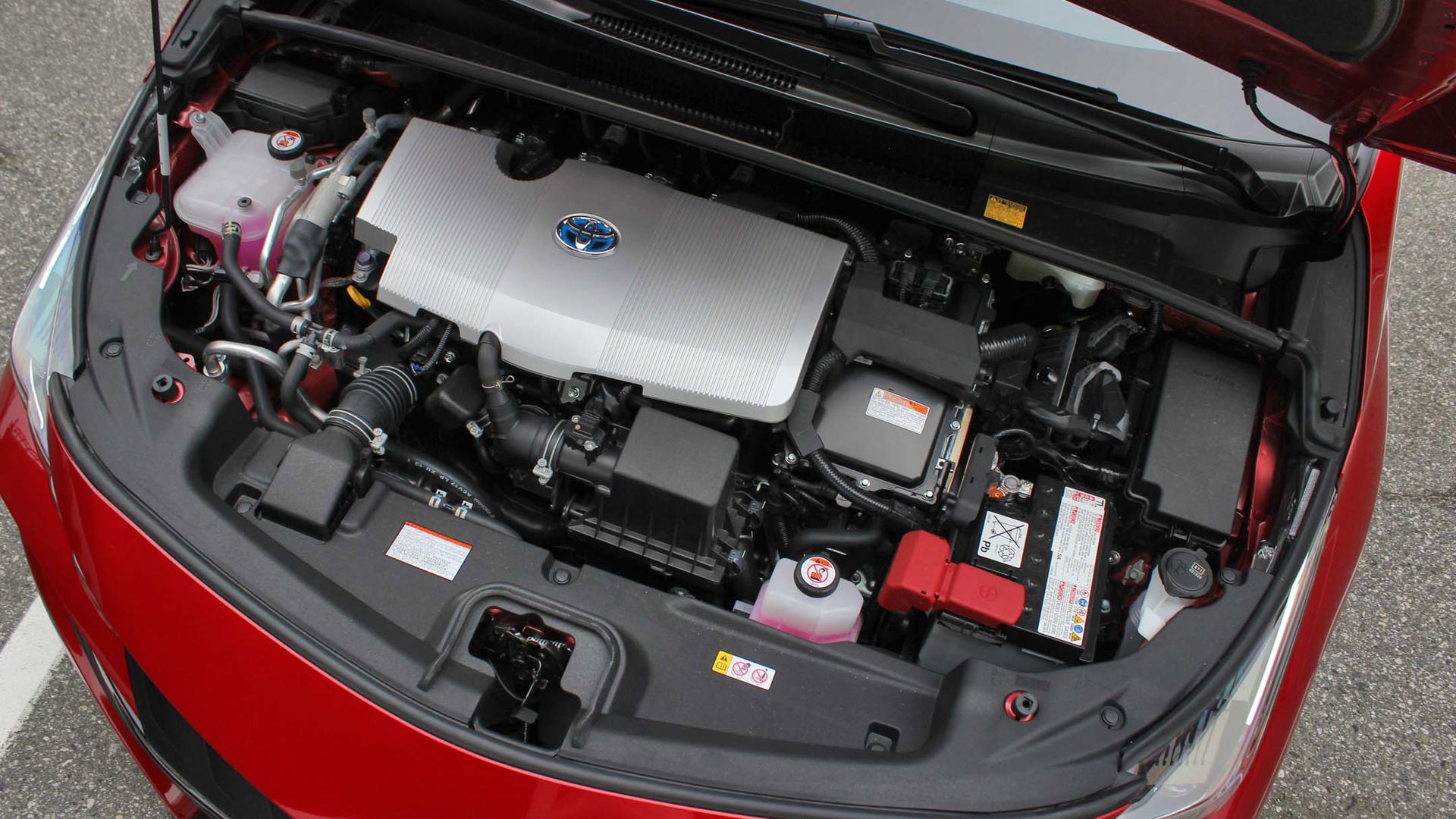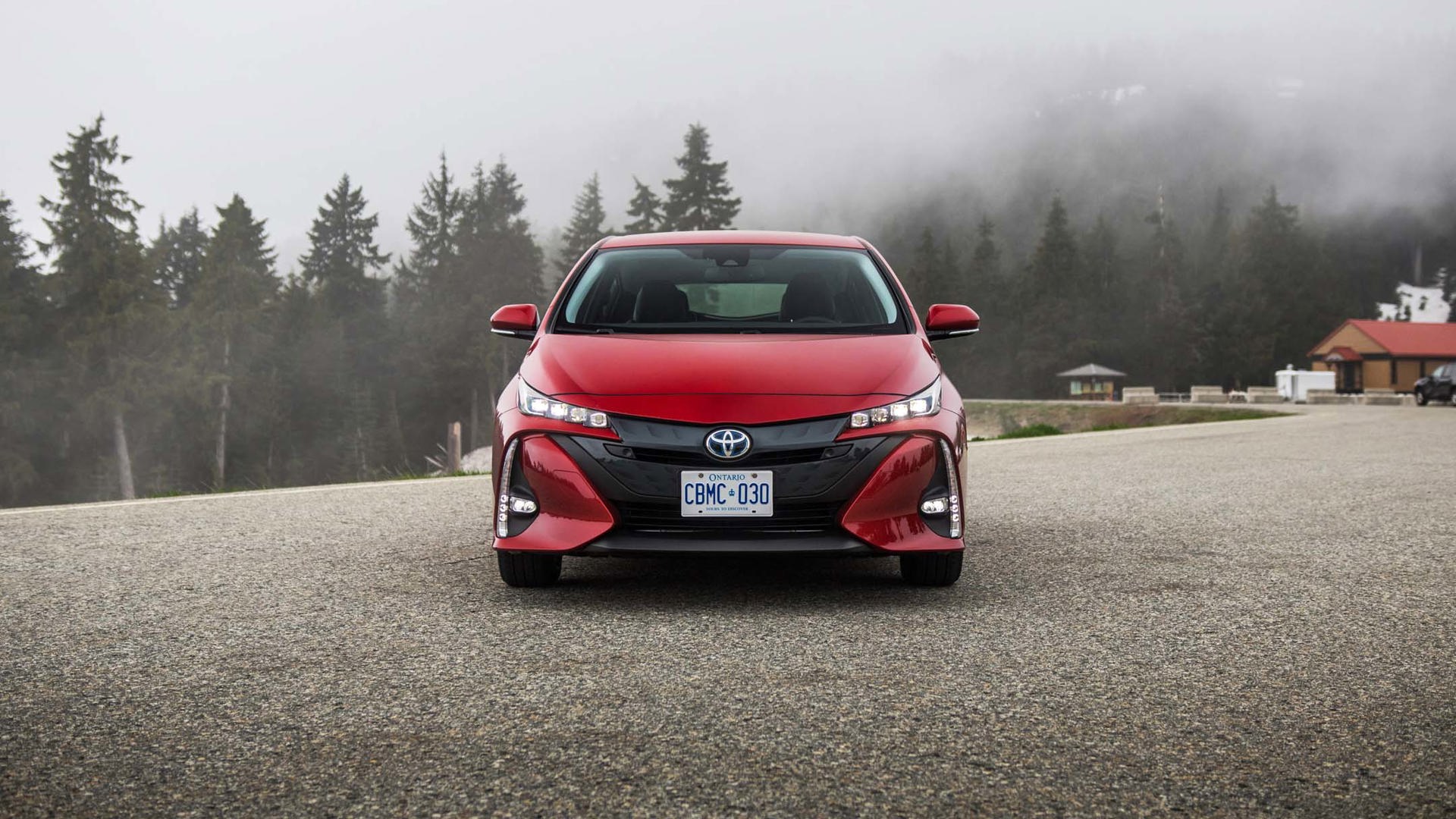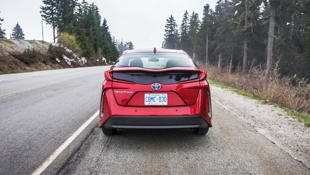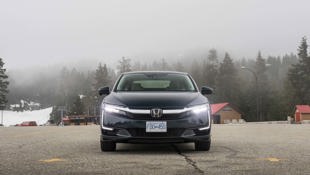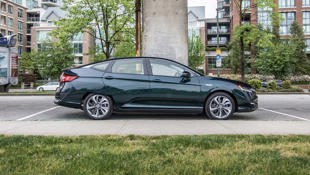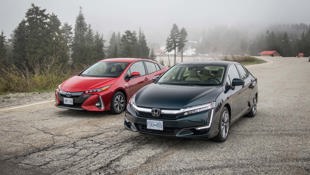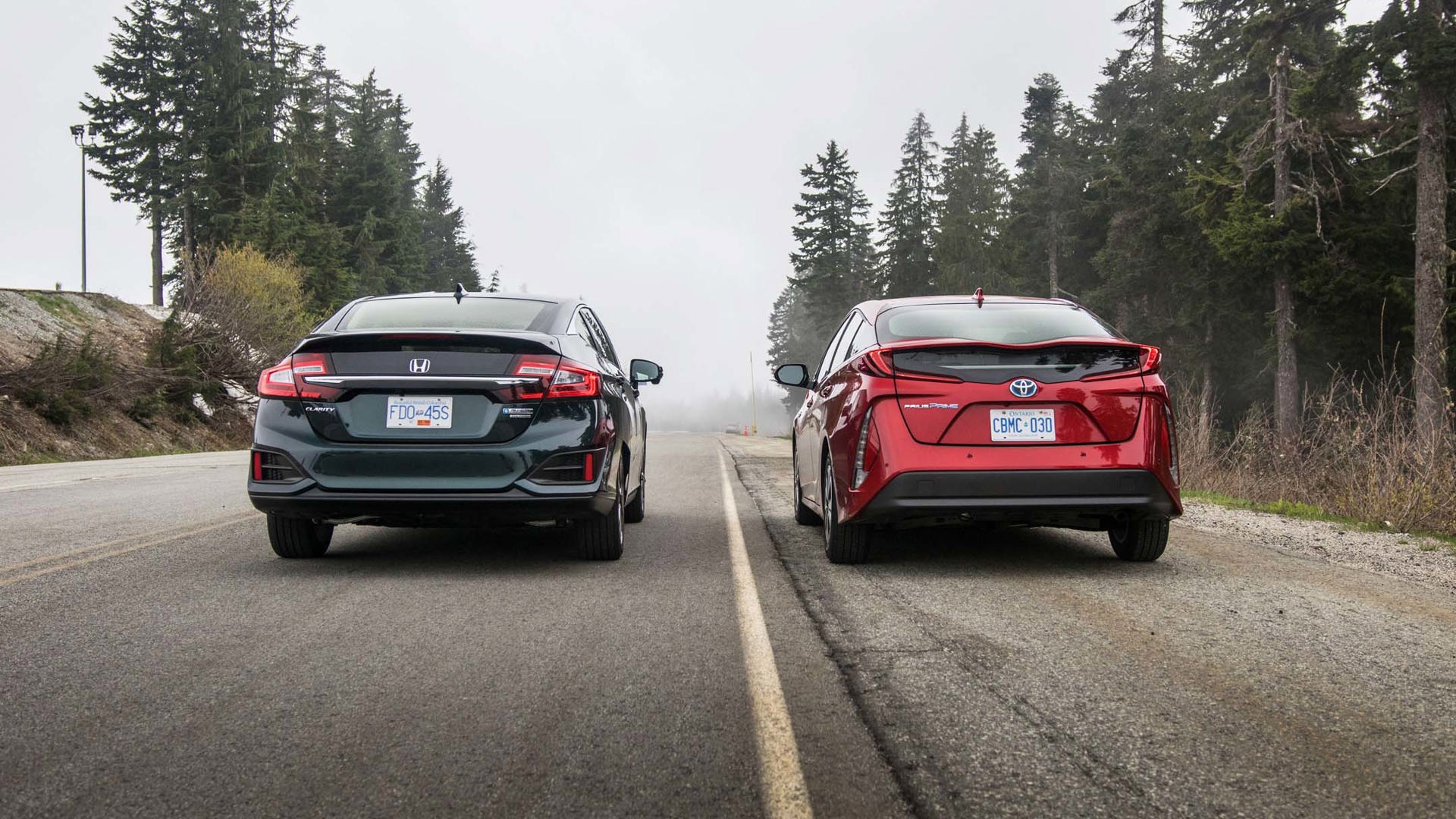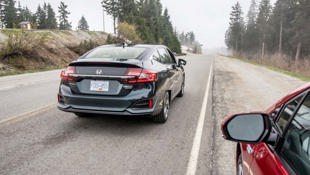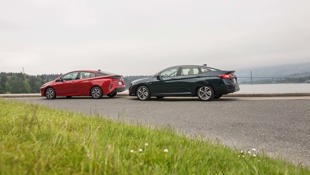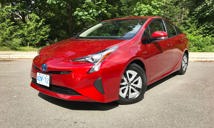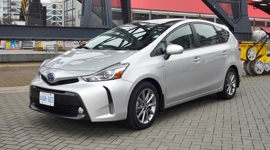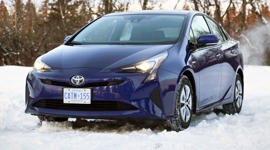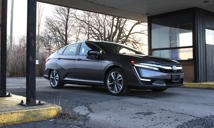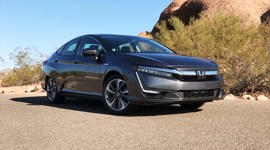Comparison Data
|
2018 Honda Clarity Touring
|
2018 Toyota Prius Prime Upgrade
|
|---|---|
|
Engine Displacement
1.5L
|
1.8L
|
|
Engine Cylinders
I4
|
I4
|
|
Peak Horsepower
212 hp @ 5,500 rpm
|
121 hp
|
|
Peak Torque
232 lb-ft @ 0–2,000 rpm (EV); 99lb-ft @ 5,000 rpm (gas)
|
N/A
|
|
Fuel Economy
5.3/5.9/5.6 L/100 km city/hwy/cmb
|
4.3/4.4/4.3 L/100 km city/hwy/cmb
|
|
Cargo Space
439 L
|
360 L
|
|
Base Price
$43,900
|
$35,445
|
|
A/C Tax
$100
|
$100
|
|
Destination Fee
$1,780
|
$1,715
|
|
Price as Tested
$45,780
|
$40,640
|
|
Optional Equipment
None
|
$3,380 – Hypersonic Red paint $255; Technology pack (10-speaker JBL audio, blind spot monitor system, rear cross traffic alert, intelligent parking assist, intelligent clearance sonar, heads-up display, auto-dimming rear view mirror, rain sensing wipers, security cover, fog lamps) $3,125
|
Dan says:
Which best-of-both-worlds is best?
I’m going to come right out and say it: I like plug-in hybrid electric vehicles (PHEVs) as an alternative to the traditional internal combustion engine (ICE) as your only energy source. I’m a fan of hydrogen power, too, but until that becomes more mainstream, a PHEV would be my choice if I were going for a non-ICE vehicle. Their larger batteries mean more EV cruising, plus they have the safety net of a gas engine, thereby eliminating range anxiety. They’re a great mix of both worlds, and it was time to see what two of the originators of mass-market hybrid cars have to offer to the world of PHEVs.
Brendan says:
I’m with Dan. In fact, I’d go so far as to say that this is the segment I would most like to buy into. As if the well-publicized high fuel prices in Vancouver weren’t pressure enough, electric-powered vehicles are more engaging than you’d think. Traffic is a complete shambles most days, so what you need isn’t the advertised “New! More powerful!” engine sucking down fuel, but the EV that’s keeping the dollars in your pocket. Add in instant off-the-line torque and the weirdly relaxing feel of using regenerative braking to slow your roll, and you’ve got a very satisfying drive.
Now, throw in a gasoline-powered engine to handle highway duties or any other unplanned excursions and bingo – best of both worlds. What we have here is simply answering the question: which best-of-both-worlds is best?
Styling
Dan says:
This is a funny section because if I’m honest, neither of these look particularly good. Indeed, ask Honda and they’ll tell you that the Clarity’s covered wheels are functional (they reduce drag, improving efficiency) and they wouldn’t have styled it that way otherwise. Read: it looks weird. Of course, remember that the car that put Honda on the hybrid map, the original Insight, also had covered rear wheels. It’s too bad, as the wheels themselves look pretty good.
Otherwise, I don’t take as much issue with the rest of the Clarity’s styling; the low roof looks a little grand touring Audi A7-esque, and depending on how you feel about Honda’s latest grille and headlight styling (which is taken to the nth degree here with supper-narrow headlamps that you can barely detect), it looks fine from the front three-quarter perspective, too.
The Prius Prime doesn’t do something quite so outlandish with the wheels, although that’s not to say the way the wheels interact with the body against which they’re placed is that much better; they just look way too small against the Prime’s somewhat slabby body panels. Way too small. Like the Clarity’s, they’re decently styled, but I have a hard time focusing on that aspect of them.
The Prius’ super space-agey taillights have been replaced by a more subdued, horizontal pair on the Prime. It’s a better look, even if it does look a little like the gaping maw of a baleen whale. Up front, the Prime gets a more streamlined look with narrower headlights linked by a blacked-out grille. Those changes aside, the stance of the two is pretty much the same; I was surprised to see that even with those new details, the Prime didn’t look quite as different from the standard Prius as it did when I first saw it launched at the 2016 New York Auto Show. Maybe my memories of the Prime were over-romanticized.
Brendan says:
Somewhere in the Official Book of Cars it is written: “Hybrid cars must look a little weird, okay?” I suppose nearly every modern car is struggling to blend handsome styling with the requirements of pedestrian safety and crash-testing regulations, but it does seem like manufacturers are nearly incapable of building something that doesn’t look like a robot had a baby with a catfish.
Call it virtue signalling, the desire to let everyone know that your mainstream-badged machine is more than everyday fare. Unfortunately, both these cars are a bit much, with the Prius being the crazier of the two. From a cerebral standpoint, I like the double-bubble rear composite hatch, as it’s a complex piece of engineering on a completely run-of-the-mill car, more McLaren than Toyota. But as for the rest of the car, from its Hello Kitty front face to the computer mouse silhouette, it’s just a head-scratcher.
The Clarity, on the other hand, starts off relatively handsome and then just goes wrong at the back end. I actually like the spats and feel like Honda should have embraced them more, opting for a more smoothed-out finish. Think of a less-daring Volkswagen XL1, and try to build something from there. It might end up looking like a Honda Accord driving out of a teardrop, but that’d be a bit of an improvement, bluntly. Either way, if we’re calling it, you’d buy either one of these cars in spite of the styling, not because of it.
Interior and Comfort
Dan says:
While both vehicles are technically classified as mid-size sedans (even though the Clarity is about 200 mm longer and 375 mm wider than the Prius, both wheelbases are almost the same), there’s a very clear winner between the two when it comes to interior comfort.
When I first sampled the Prime’s Prius sibling, I was actually very surprised by how roomy it felt, both up front and in the back seats. With that in mind, I thought that even though the Clarity looks the bigger car (more so in person than in these photos; the Clarity’s dark “Moonlit Forest Pearl” colour hides its bulk), maybe there wasn’t as much of a difference between the two as their exterior digs suggest.
Put simply: I was wrong.
While I wouldn’t call the Clarity “cavernous” – spacious, airy and altogether roomy are all very appropriate adjectives. Even though you can’t get one with a sunroof, I often emerged from the Clarity feeling refreshed – unless I’d struck my knee on the centre console, which features a bit of an outcropping edge that turned out to be the bane of my kneecaps until I learned to focus on avoiding it.
The back seat has no such issues; some may ask for a little more support from the seats themselves as they’re fairly flat, but I doubt it. I found them comfortable and their shape made installing a child seat that much easier.
The size of the Clarity’s trunk also makes loading cargo easy; the Prime’s hatch provides a nice, big opening but it’s a little shallow so you have to be very careful about how you load it. The Clarity’s trunk is properly deep, to the point we were able to fairly easily fit travel gear for a family of three, with a dog kennel in the back seat. Some may complain that the window built into the trunk for better visibility is not good for security, but it is tinted so you have to look very closely to see what’s inside.
As far as the styling and materials go, the Honda is also aces. The “wood” you see may be fake, but it’s tough to tell and they’ve used just the right amount of it in here. Our car featured the lighter of two available interior colours for the Touring trim, the other being black. You can’t mix and match your interior colours, unfortunately, but this being a fairly low-volume car, that’s no surprise, really. Base trim gets a single black/grey combo treatment.
The Prime is even more restrictive in its choices; it’s either black cloth or black leather, depending on which of the two trims (the ingeniously named “Prime” and “Prime Upgrade”) you choose. Its exterior colours are slightly more varied – as in, very slightly as there’s five choices to the Clarity’s four, no matter which trim you select.
Other than the massive 11.6-inch tablet that serves as our tester’s centre stack, it’s a little tamer inside the Toyota than in the Honda. Non-“Upgrade” models get a smaller screen shared with other Toyotas. It’s a little more monochromatic, though you’re still stuck with the tuxedo black-and-white treatment the Prius gets. That car gets either black or white steering-wheel inserts, depending on trim; the Prime is black-and-white only.
While the Clarity wins in the interior comfort sweepstakes, it still must be said that Toyota has managed to carve quite a lot of space out of the Prime. The room in the back seat is what impressed me the most; most adults will have little to complain about the headroom, and while the Clarity’s rear legroom is impressive in its massiveness, adults will survive in back of the Prime, too. Remember the Prius is a favourite amongst cabbies these days, and you’d think they’d want their rear-seat occupants to be comfortable.
Brendan says:
As Dan points out, the Clarity is quite a bit roomier. However, for me, it’s not the space that impresses, it’s the interior appointments. The Prius very much still has one foot in the world of hybrid-as-hair-shirt, with an interior that looks built around economics first. Really, Toyota’s a bit trapped by tradition here: the central gauges are a Prius hallmark, as is the stubby little shifter, as are ho-hum plastics. It’s perfectly acceptable for the segment, but doesn’t move the story forward, apart from the large central touchscreen – more on that later.
Precisely because none of their hybrids have been knockout successes, Honda is free to meddle with the Clarity’s formula. If the original stripped-down Insight had been a hot-seller, maybe we’d be looking at a tiny, low-powered coupe. Instead, we’ve got a machine that’s at least as nice inside as high-trim levels of the Honda Accord.
Since the Clarity costs around $40K, not needing to explain away a cut-rate interior is a good thing. The instrumentation is more conventional, the flying-bridge centre console is a neat way to create extra space, and while the touchscreen doesn’t dominate the dash, it is bright and clear, with a high-resolution display that looks equal to the Prius' in quality if not quantity.
Tech
Dan says:
Ohh, that Prime screen. It serves as your hub for, well, pretty much everything from your climate controls to your music choices. The more old-school amongst us will be happy to learn that there are redundant controls alongside the screen, if you’d rather make use of more traditional buttons. One of which is your volume control, which we’ll soon see is not always the case in the world today.
To wit: the Honda Clarity. Like its Civic, Pilot, and Ridgeline siblings, its infotainment is an all-touch affair. No knobs or buttons to speak of, unless you include the items on the steering-wheel spokes. The touchscreen itself is nicely responsive, but so many of the buttons on the surrounding touch panel are not. The biggest culprit is the volume control, which was an exercise in annoyance almost every time I tried to use it. The steering wheel controls are a little better, but even they’re kind of small and oddly shaped. The latest CR-V and Accord have a volume knob, and Honda should take note for the rest of its lineup. If the latest Accord gets one, why can’t the Clarity?
The Clarity does gain some points back in the infotainment department with its inclusion of Apple CarPlay and Android Auto compatibility, features that Toyota continues to ignore with the Prime. Unlike other systems I’ve tried, the Clarity’s Apple CarPlay offering had no issues – all my apps worked properly (including Google Play Music, which has caused issues for me in numerous vehicles), there were no connection/freezing problems and it became second nature to have the feature. I love it, and Toyota has obviously taken note, with the new Avalon offering CarPlay compatibility. The rest of the lineup should be following suit.
Both Clarity trims get lane-departure warning, auto braking, road-departure mitigation system, adaptive cruise, and Honda LaneWatch (whereby your infotainment screen becomes a blind spot camera once you indicate right) as standard. The Prime, on the other hand, required upgrading to the, ahem, Upgrade trim in order to get blind-spot warning, but that also adds rear cross-traffic alert, 10-speaker JBL audio (up from the standard six), park assist, and head-up display, all features that further solidify the Prime as the winner in the tech department.
Brendan says:
Yes, the Prime’s huge screen provides much of the wow factor to its interior, and yes, the Clarity’s interface suffers from much of the same ergonomic foibles as the rest of the Honda range. However, I wouldn’t call this a slam-dunk for the Prime versus the Clarity. That large touchscreen isn’t quite as fast as I would like, so don’t think of it as a Tesla on the cheap. On the plus side, Toyota’s longer testing and development cycles mean that this screen should be a relatively glitch-free offering.
But for everyday regular-car livability, I’d argue that the Clarity, knobless though it may be, is actually the better choice because of its conventionality. The CarPlay and Android Auto compatibility is worth more than a few extra points here, and the system overall is greatly improved compared to other Hondas in the range. Also, I actually like the steering wheel controls. They fall easily to, uh, thumb.
Then there’s a bunch of other nice features like the aforementioned LaneWatch and the Clarity’s three-way adjustable rear camera. The Prime’s huge touchscreen is like a big flat screen in a pretty starkly laid-out apartment. Sure it looks cool, but this is a car – aren’t you supposed to be paying more attention to what’s happening beyond the windshield?
Ride and handling
Dan says:
This was probably the toughest section to call, as it varies so much on what you want from your PHEV. The results may surprise you – they did me.
If you want your little efficient city runabout to be easier to thread through the tight confines of the urban jungle, then it has to be said that the Prime is the way to go. Not just because it’s smaller, but because it is a very able handler, to boot. The steering is responsive without being overly nervous on the highway, so you can squirt from point to point with just a few flicks of the wrist. Body roll is minimal, too, only really felt when you really pitch it in to a corner. It’s a move that I’m sure few Prime owners will ever do, but it just goes to show that this baby can handle.
The Honda rides pretty much how it looks – that is to say somewhat wallowy, but incredibly smoothly. As you move through town or what have you, bumps are swallowed up with gumption that had me wondering on a few occasions if the Clarity had air suspension – it doesn’t, but man oh man it may as well. It rides smoothly, it rides quietly – in short, it rides like a Toyota Camry (or a Lexus, even), hence my surprise at the divergence of the handling of these two cars.
Brendan says:
Just as the size difference between these two cars becomes more pronounced once you climb inside them, the emphasis continues once you get behind the wheel. I’ve previously had the very odd experience of chucking around a Prius at a racetrack on a Toyota event, and it handled better than anticipated. Obviously, expectations for a Prius handling are a bar dropped into the Challenger Deep, but the Prime is far more fun than you’d think. The car maintains its poise through corners, and if there’s not a ton of acceleration on tap, preserving momentum is easy and fun.
Surprisingly, this relatively nimble feel suits the Prius to a T. This is a car where reaching for the brake pedal feels like a failure, where keeping your eyes up and anticipating traffic slowdowns is part of the fun. No wonder the Prius is so popular among taxi drivers, especially around here in Vancouver.
I wouldn’t call the Clarity a complete pillow, more a heavier version of the Honda recipe we’re used to. Perhaps it’s because the bar for Honda handling is so much higher that the Clarity’s relatively soft performance and feeling of gravitas impresses a little less off the bat.
Having said that, the Clarity’s ride and handling back up initial impressions that it’s the more substantial car. As Dan points out, this is Lexus-level comfort, and it’s not like the grip isn’t there once the Clarity takes a set. Leave the Prius to the cab companies – the Clarity’s both the better choice for a longer road trip, and for getting you to work in a more relaxed mood.
Performance and Economy
Brendan says:
Let’s mention the straight-line stuff in brief here, and then pick these two apart based on how good they are at sipping fuel, as that’s the more important factor. First, the Prius Prime, which comes with a 95 hp 1.8L Atkinson-cycle gasoline engine and an 8.8 kWh lithium-ion battery. Total power is 121 hp, which is good enough for a fairly leisurely 10-second-plus jaunt to 100 km/h.
Happily, the Prime comes off the line a little quicker than its 0–100 km/h time would indicate, and anyway you can’t go quicker than the six Corollas in front of you. For the plug-in part, the Prime’s li-ion battery is good for a claimed 40 km of pure electric range. In a normal week’s use, I was able to get over 30 km of use fairly regularly, but never quite hit the 35 km peak.
However, it’s not like you’d use the Prime like a gasoline car, continually driving until empty. One advantage of the small battery pack is that it charges in just a couple of hours (5.5 hours on 120V, two hours on 240V). Hitting 80 percent charge on even a regular wall outlet takes just a couple of hours, and if you can find a plug when shopping, working, or hitting the gym, you might not have to plug in at home for days.
Toyota claims a total range of 965 km between battery pack and gasoline engine, and with its slippery aerodynamics, the Prime returned excellent fuel economy even on highway use. Because both cars are such long-range affairs, Dan and I tracked values for more than the single day of testing, and I found the Prime to be capable of hitting all its stated targets. If I had a shorter commute, I might want to run the engine every couple of months just so it wasn’t sitting around doing nothing.
The Clarity, however, offers more of everything. The 1.5L engine is also Atkinson-cycle, but produces a little more peak power at 105 hp. More impressive from behind the wheel is the Clarity’s electric grunt: backed up by a 17 kWh battery, the electrified Honda comes with more than twice the Prime’s torque.
However, the Clarity needs that extra oomph to get off the line. At more than 1,800 kg, it’s significantly heavier than the Prime’s 1,531 kg curb weight rating. Mostly, however, the weight is more noticeable in handling characteristics rather than acceleration. The Clarity is easily quicker than the Prius, taking at least two fewer seconds to get up to highway speeds.
That 17 kWh lithium-ion battery gives the Clarity not-quite-double the electric-only range of the Prius, at 77 km. It is, however, much more pleasing to drive in electric-only mode, as the Prime can feel a little underpowered when running on electrons only. Total range is less than the Prime as the Clarity has a very small 26.5 L fuel tank, so you can only go 547 km with both a fully powered battery-pack and gasoline charge. If you were, for instance, heading out on a multi-day road trip, the Prime might have an advantage here, especially as it’s about 1.5 L more efficient per 100 km in gasoline-powered fuel economy on the highway.
In terms of being able to run on electricity as much of the time as possible, however, the Clarity’s bigger battery is the smarter choice for a commuter. The Toyota’s combined electric-gasoline economy is 0.3 Le/100 km better than the Honda, but unless you regularly road-trip your hybrid every weekend, that’s a pretty small gap for a significant boost in driving performance.
Dan says:
While both cars exhibit the wonders of instantaneous acceleration afforded by EV power, the way the Clarity really takes off when you dip that throttle pedal is mighty impressive, and I never tired of giving it the boot when I had the chance. The Prius less so of course, but it serves its purpose as a nifty city runabout rather well. That EV performance may falter a little as the speeds get higher, but it’s very point-and-squirtable in town, the active chassis and powertrain working in unison to make city jaunts that much easier. Still having trouble getting used to that weird shifter/shift dongle, though. I’ve driven Priuses many times, but I still have to remind myself what is what when it comes to the shifter, which means I spent more time glowering at it than I should have.
Brendan mentions that the Prime may be better suited for a multi-day road trip, but I had the opportunity to take the Clarity on a road trip and I was impressed with the results. I managed to start one leg with 74 km on the EV clock, and ended up finishing my 120 km drive having only driven about 20 km on full-gas power. That’s a pretty impressive feat.
Granted, the trip had a lot of downhill as my family and I were coming out of the mountains, but it’s impressive nonetheless. I also like the way multiple drives in “HV charge” mode (activated by holding down a button mounted at the base of the centre stack) saw me return two km of charge per every one km driven. Not bad, and it at least partially makes up for the fact that the Clarity takes so much longer to charge from an outlet than the Prime.
I do have to say, however: Brendan mentions that the Prime feels lees energetic on EV power than the Clarity. While I agree with that, the way the Clarity and its 1,800 kilos struggle in gas-only mode is just as egregious. Especially on the highway – and especially on the way up those same mountains I eventually came down from – where the complaints of a slightly overstressed 1.5L four join your less-than-stellar forward progress. The Clarity can’t be forced to drive on gas-only mode on the highway (saving EV for the city), and I think I now understand one of the reasons why.
I do love those brake regen paddles in behind the Clarity’s wheel, though. They are marked “+” and “-”, but that has nothing to do with shifting gears; instead, the “+” means less brake drag, the “-”, more. The idea, of course, is that you flip the “-” paddle a bunch as you slow for a red light, to better gain back more power through brake regeneration. It can set to numerous levels, but reverts back to “none” once you come to a stop, meaning you have to do it all again next time.
Value
Dan says:
The Prime starts at a clear seven grand lower than the Clarity, and the top-spec models we tested have a $5,000 gap between them. I guess the easy answer is that being a bigger car, the Clarity’s higher price is understandable even if they’re both considered mid-sizers. I guess what you have to decide is whether or not the tech offered by the Prius (including that screen) is enough of a value add to make up for the fact that the Clarity gets more range, rides better, and is the bigger car. For me, I think I’d be happy to opt for the base Clarity, which provides most of the safety and infotainment features of the Touring model, sacrificing mainly the leather interior, some colour options, and GPS. That’s pretty much it.
As Brendan demonstrates, however, the Clarity has an ace up its sleeve in this department.
Brendan says:
The pricing is going to be a clear hurdle here for the Clarity, but it’s lowered right out of the gate in BC by rebates. The Clarity gets the full $5,000 plug-in rebate, while the Prime’s smaller battery means it only gets $2,500. In Ontario, the new provincial government has announced the total cancellation of its provincial plug-in vehicle rebates, with the caveat that non-Tesla vehicles still on dealer lots will be eligible for the previous rebates if delivered and plated by September 10, 2018. The Clarity gets a whopping $13,000 rebate, and the Prime gets $5,000 off, but both of those cars are in very short supply on Ontario dealer lots. In Quebec, the Prius Prime receives a $4,000 provincial rebate, and the Clarity an $8,000 one.
Like Dan, I figure the base Clarity has everything you really need, especially as CarPlay and Android Auto are included. But wait, there’s more. I mean less.
As Dan and I are both West Coasters, I’ll stand by the Clarity as the better value. If you’re in Ontario, it’s hard to make a purely financial case for either one – the overnight change suddenly sweeps the legs out from both plug-in machines when compared to their less expensive gasoline-rivals.
That being the case, the Clarity’s bigger battery still makes it the choice, as you’re likely getting the most gasoline-free experience for most Canadian driving needs.
Conclusion
Dan says:
The first thing I – and probably most – considered about the Clarity was its avant-garde styling, and how that was going to make for a steep hill to climb on the sales front. Not to mention the fact that while both manufacturers got their start in the hybrid business around the same time, I’d have to agree with Brendan: when you’re talking hybrid (or PHEV), “Toyota” and “Prius” comes up so much, they’re almost synonymous.
I have to say, though, that the rest of the Clarity experience – the ride, interior quality, the powertrain – was just so good that I might just be willing to accept those weird rear fenders. I’m guessing that’s what Honda gambled on, and from my standpoint, it was a good bet.
The Prime has its merits. I like the handling, the space inside for such a small car deserves mention and the tech is good. For this test, though, its merits as a PHEV are outclassed by the larger car, as is the ride. My love for PHEVs has grown, and it’s all thanks to Honda.
How about you, Brend-o?
Brendan says:
To me, it wasn’t the styling, it was the badge. And not the Toyota versus Honda thing either – the Clarity’s biggest uphill battle is that it’s waging war against a Prius, probably the best-recognized nameplate in terms of environmental choices. Because of the taxi-cab thing, everyone’s ridden in a Prius, we’ve all seen them on the roads, and we know what they can do. A slightly better plug-in one? That’s a no-brainer.
However, if you do choose to engage your brain, and/or if Honda can at least get you in the door to take one for a spin, the Clarity is the better car. It asks you to compromise less, it’s more comfortable and substantial-feeling, and the interior is upscale rather than deliberately odd. Only the styling is a bit weird, and it’s not like the anime-cat Prius is about to win any beauty competitions.
My one wish for the Clarity is that it find enough success that Honda decides to offer this level of competence and execution in something like a CR-V. Otherwise, if you’re casting a gloomy eye at fuel prices and wondering if life would be better in a hybrid, then good news: There’s never been a better time to plug in.
